CHCDIV002 Promote Aboriginal and/or Torres Strait Islander Cultural Safety Learner Workbook
VerifiedAdded on 2023/06/15
|55
|13325
|458
AI Summary
This is a learner workbook for CHCDIV002: Promote Aboriginal and/or Torres Strait Islander cultural safety. It includes assessment instructions, requirements, observation/demonstration, third party guide, and activities. The workbook requires active participation and adherence to the terms and conditions. Assessment can be done through direct observation, product-based methods, portfolios, questioning, or third party evidence. Learners must complete all activities and have them deemed satisfactory by the assessor to demonstrate competence in this unit.
Contribute Materials
Your contribution can guide someone’s learning journey. Share your
documents today.
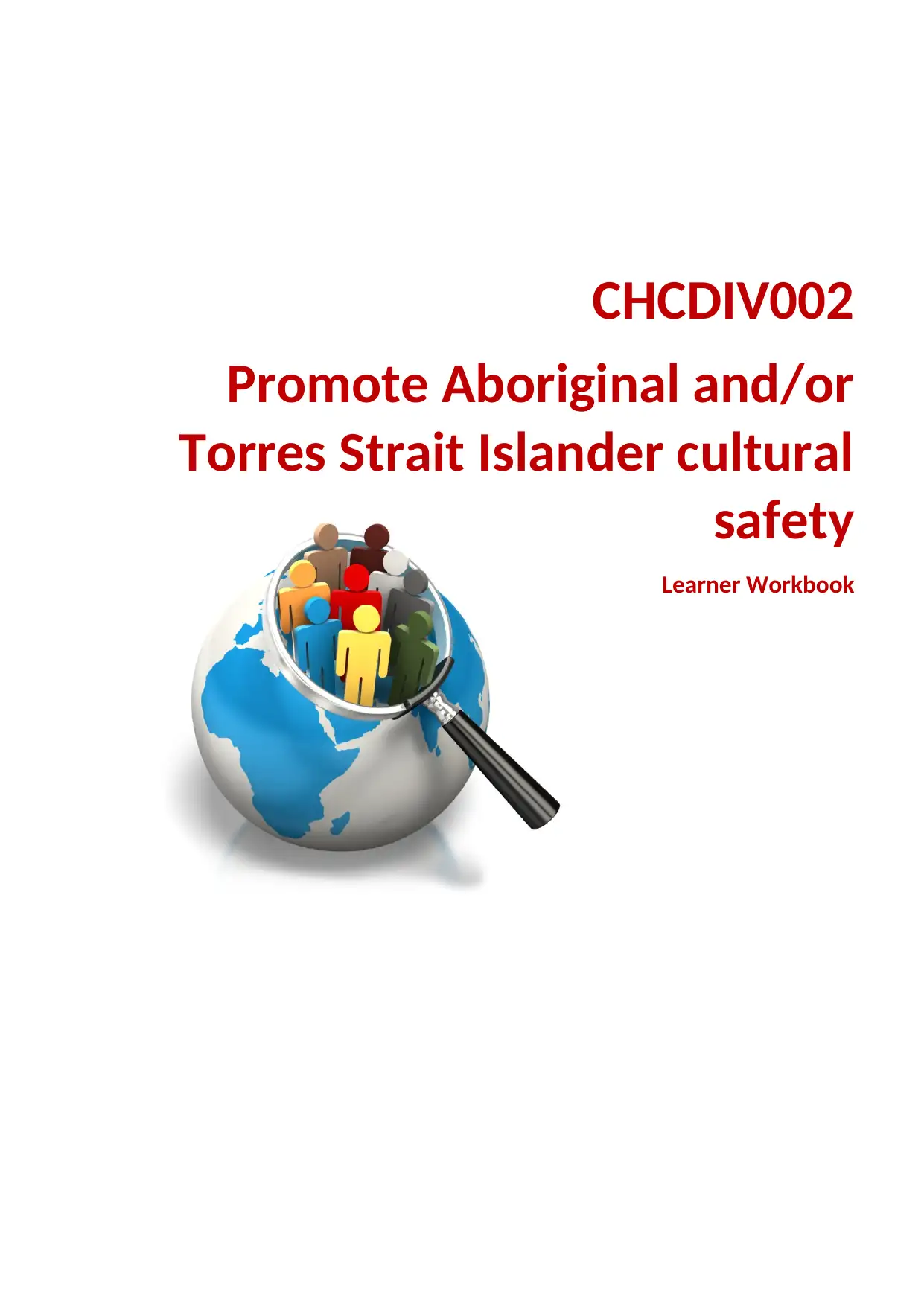
CHCDIV002
Promote Aboriginal and/or
Torres Strait Islander cultural
safety
Learner Workbook
Promote Aboriginal and/or
Torres Strait Islander cultural
safety
Learner Workbook
Secure Best Marks with AI Grader
Need help grading? Try our AI Grader for instant feedback on your assignments.
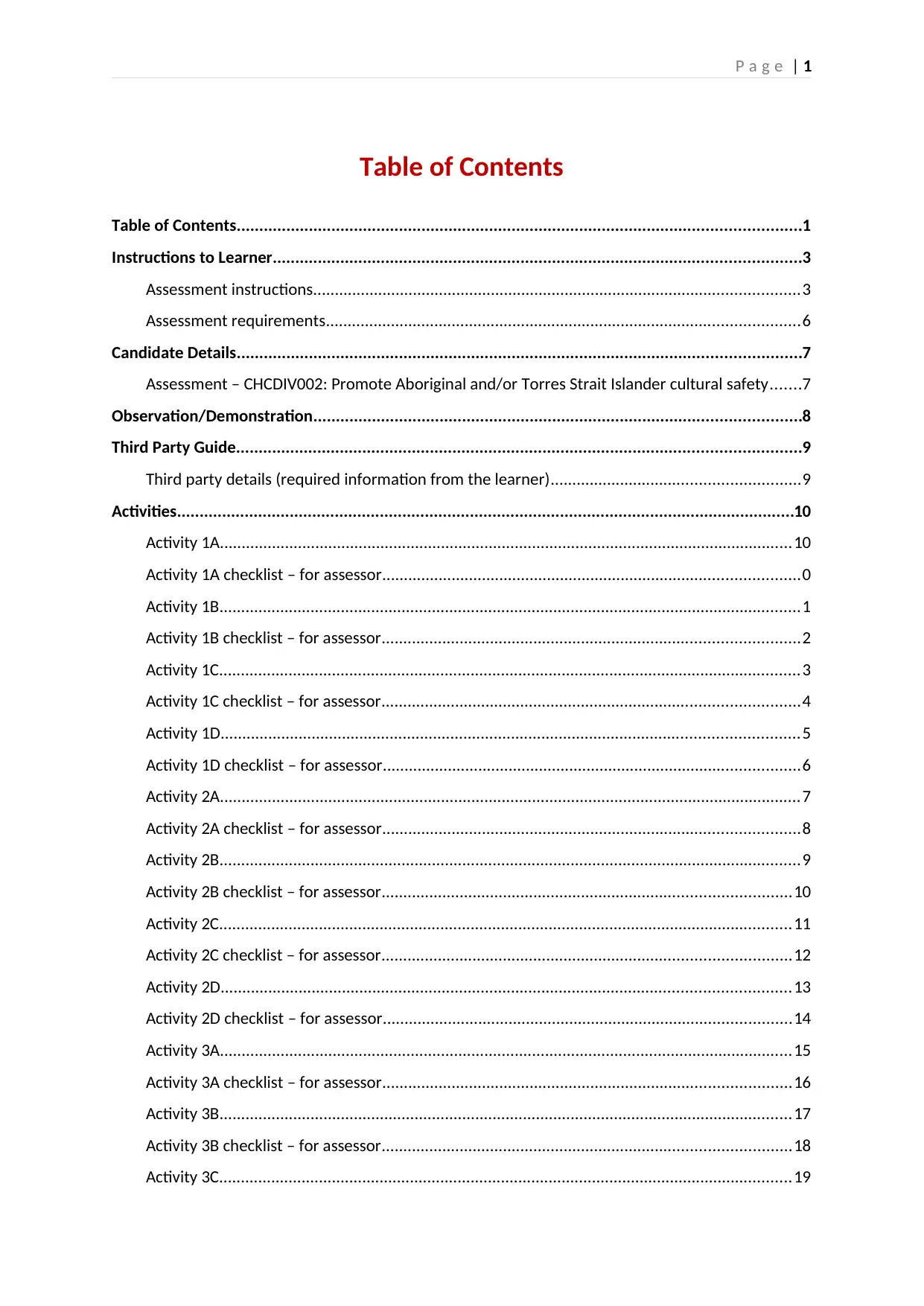
P a g e | 1
Table of Contents
Table of Contents.............................................................................................................................1
Instructions to Learner.....................................................................................................................3
Assessment instructions................................................................................................................3
Assessment requirements.............................................................................................................6
Candidate Details.............................................................................................................................7
Assessment – CHCDIV002: Promote Aboriginal and/or Torres Strait Islander cultural safety.......7
Observation/Demonstration............................................................................................................8
Third Party Guide.............................................................................................................................9
Third party details (required information from the learner).........................................................9
Activities.........................................................................................................................................10
Activity 1A....................................................................................................................................10
Activity 1A checklist – for assessor................................................................................................0
Activity 1B......................................................................................................................................1
Activity 1B checklist – for assessor................................................................................................2
Activity 1C......................................................................................................................................3
Activity 1C checklist – for assessor................................................................................................4
Activity 1D.....................................................................................................................................5
Activity 1D checklist – for assessor................................................................................................6
Activity 2A......................................................................................................................................7
Activity 2A checklist – for assessor................................................................................................8
Activity 2B......................................................................................................................................9
Activity 2B checklist – for assessor..............................................................................................10
Activity 2C....................................................................................................................................11
Activity 2C checklist – for assessor..............................................................................................12
Activity 2D...................................................................................................................................13
Activity 2D checklist – for assessor..............................................................................................14
Activity 3A....................................................................................................................................15
Activity 3A checklist – for assessor..............................................................................................16
Activity 3B....................................................................................................................................17
Activity 3B checklist – for assessor..............................................................................................18
Activity 3C....................................................................................................................................19
Table of Contents
Table of Contents.............................................................................................................................1
Instructions to Learner.....................................................................................................................3
Assessment instructions................................................................................................................3
Assessment requirements.............................................................................................................6
Candidate Details.............................................................................................................................7
Assessment – CHCDIV002: Promote Aboriginal and/or Torres Strait Islander cultural safety.......7
Observation/Demonstration............................................................................................................8
Third Party Guide.............................................................................................................................9
Third party details (required information from the learner).........................................................9
Activities.........................................................................................................................................10
Activity 1A....................................................................................................................................10
Activity 1A checklist – for assessor................................................................................................0
Activity 1B......................................................................................................................................1
Activity 1B checklist – for assessor................................................................................................2
Activity 1C......................................................................................................................................3
Activity 1C checklist – for assessor................................................................................................4
Activity 1D.....................................................................................................................................5
Activity 1D checklist – for assessor................................................................................................6
Activity 2A......................................................................................................................................7
Activity 2A checklist – for assessor................................................................................................8
Activity 2B......................................................................................................................................9
Activity 2B checklist – for assessor..............................................................................................10
Activity 2C....................................................................................................................................11
Activity 2C checklist – for assessor..............................................................................................12
Activity 2D...................................................................................................................................13
Activity 2D checklist – for assessor..............................................................................................14
Activity 3A....................................................................................................................................15
Activity 3A checklist – for assessor..............................................................................................16
Activity 3B....................................................................................................................................17
Activity 3B checklist – for assessor..............................................................................................18
Activity 3C....................................................................................................................................19
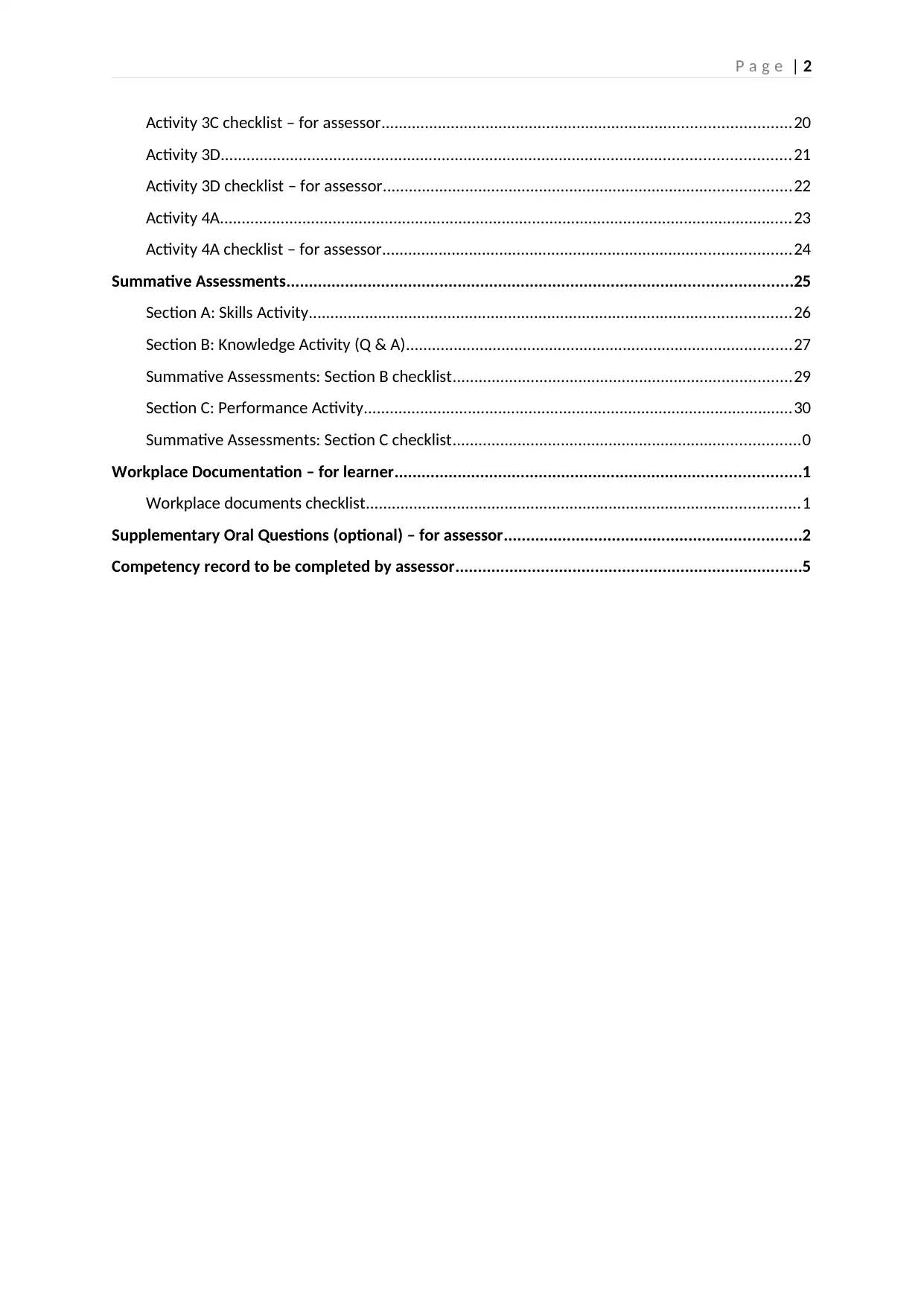
P a g e | 2
Activity 3C checklist – for assessor..............................................................................................20
Activity 3D...................................................................................................................................21
Activity 3D checklist – for assessor..............................................................................................22
Activity 4A....................................................................................................................................23
Activity 4A checklist – for assessor..............................................................................................24
Summative Assessments................................................................................................................25
Section A: Skills Activity...............................................................................................................26
Section B: Knowledge Activity (Q & A).........................................................................................27
Summative Assessments: Section B checklist..............................................................................29
Section C: Performance Activity...................................................................................................30
Summative Assessments: Section C checklist................................................................................0
Workplace Documentation – for learner..........................................................................................1
Workplace documents checklist....................................................................................................1
Supplementary Oral Questions (optional) – for assessor..................................................................2
Competency record to be completed by assessor.............................................................................5
Activity 3C checklist – for assessor..............................................................................................20
Activity 3D...................................................................................................................................21
Activity 3D checklist – for assessor..............................................................................................22
Activity 4A....................................................................................................................................23
Activity 4A checklist – for assessor..............................................................................................24
Summative Assessments................................................................................................................25
Section A: Skills Activity...............................................................................................................26
Section B: Knowledge Activity (Q & A).........................................................................................27
Summative Assessments: Section B checklist..............................................................................29
Section C: Performance Activity...................................................................................................30
Summative Assessments: Section C checklist................................................................................0
Workplace Documentation – for learner..........................................................................................1
Workplace documents checklist....................................................................................................1
Supplementary Oral Questions (optional) – for assessor..................................................................2
Competency record to be completed by assessor.............................................................................5
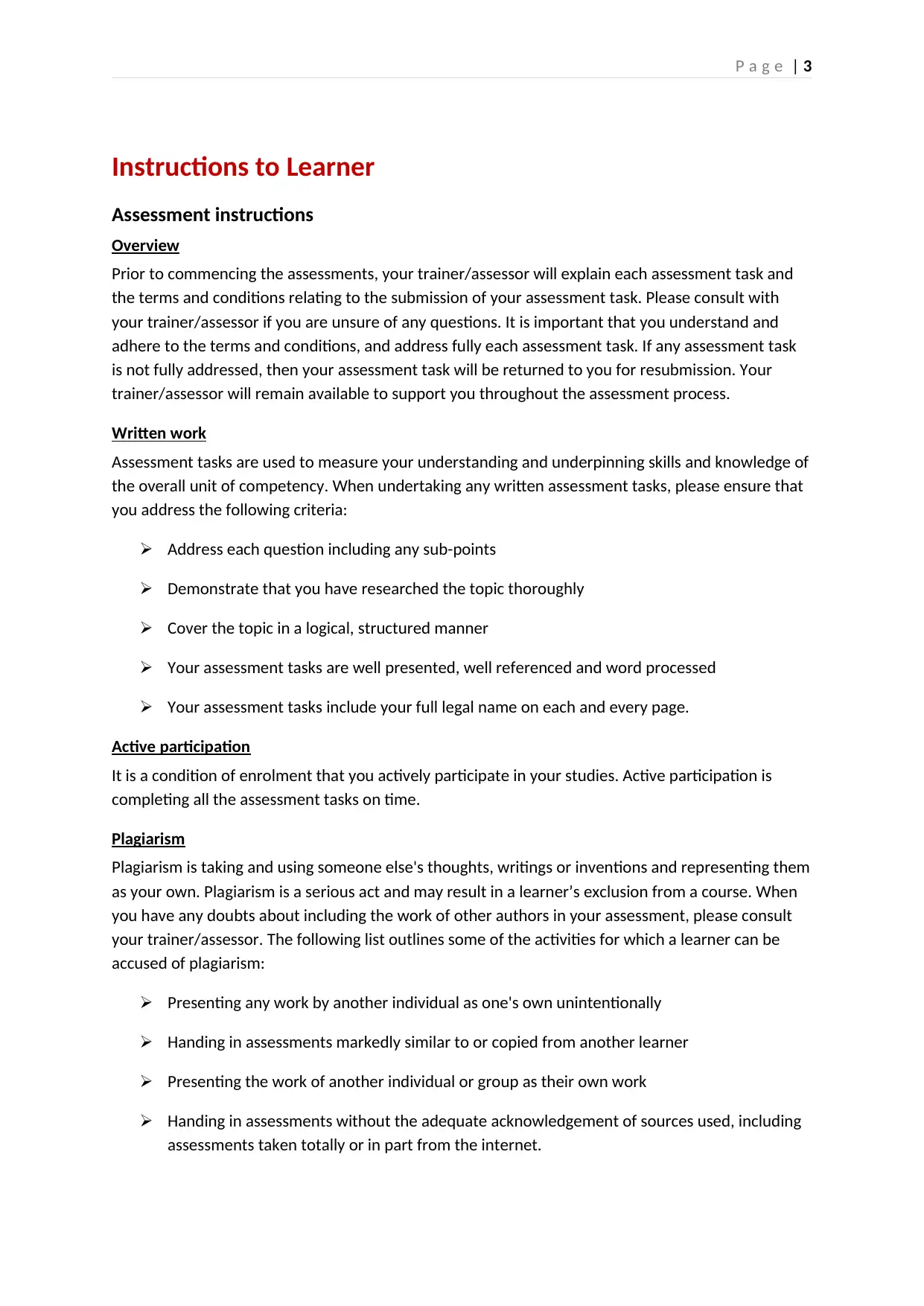
P a g e | 3
Instructions to Learner
Assessment instructions
Overview
Prior to commencing the assessments, your trainer/assessor will explain each assessment task and
the terms and conditions relating to the submission of your assessment task. Please consult with
your trainer/assessor if you are unsure of any questions. It is important that you understand and
adhere to the terms and conditions, and address fully each assessment task. If any assessment task
is not fully addressed, then your assessment task will be returned to you for resubmission. Your
trainer/assessor will remain available to support you throughout the assessment process.
Written work
Assessment tasks are used to measure your understanding and underpinning skills and knowledge of
the overall unit of competency. When undertaking any written assessment tasks, please ensure that
you address the following criteria:
Address each question including any sub-points
Demonstrate that you have researched the topic thoroughly
Cover the topic in a logical, structured manner
Your assessment tasks are well presented, well referenced and word processed
Your assessment tasks include your full legal name on each and every page.
Active participation
It is a condition of enrolment that you actively participate in your studies. Active participation is
completing all the assessment tasks on time.
Plagiarism
Plagiarism is taking and using someone else's thoughts, writings or inventions and representing them
as your own. Plagiarism is a serious act and may result in a learner’s exclusion from a course. When
you have any doubts about including the work of other authors in your assessment, please consult
your trainer/assessor. The following list outlines some of the activities for which a learner can be
accused of plagiarism:
Presenting any work by another individual as one's own unintentionally
Handing in assessments markedly similar to or copied from another learner
Presenting the work of another individual or group as their own work
Handing in assessments without the adequate acknowledgement of sources used, including
assessments taken totally or in part from the internet.
Instructions to Learner
Assessment instructions
Overview
Prior to commencing the assessments, your trainer/assessor will explain each assessment task and
the terms and conditions relating to the submission of your assessment task. Please consult with
your trainer/assessor if you are unsure of any questions. It is important that you understand and
adhere to the terms and conditions, and address fully each assessment task. If any assessment task
is not fully addressed, then your assessment task will be returned to you for resubmission. Your
trainer/assessor will remain available to support you throughout the assessment process.
Written work
Assessment tasks are used to measure your understanding and underpinning skills and knowledge of
the overall unit of competency. When undertaking any written assessment tasks, please ensure that
you address the following criteria:
Address each question including any sub-points
Demonstrate that you have researched the topic thoroughly
Cover the topic in a logical, structured manner
Your assessment tasks are well presented, well referenced and word processed
Your assessment tasks include your full legal name on each and every page.
Active participation
It is a condition of enrolment that you actively participate in your studies. Active participation is
completing all the assessment tasks on time.
Plagiarism
Plagiarism is taking and using someone else's thoughts, writings or inventions and representing them
as your own. Plagiarism is a serious act and may result in a learner’s exclusion from a course. When
you have any doubts about including the work of other authors in your assessment, please consult
your trainer/assessor. The following list outlines some of the activities for which a learner can be
accused of plagiarism:
Presenting any work by another individual as one's own unintentionally
Handing in assessments markedly similar to or copied from another learner
Presenting the work of another individual or group as their own work
Handing in assessments without the adequate acknowledgement of sources used, including
assessments taken totally or in part from the internet.
Secure Best Marks with AI Grader
Need help grading? Try our AI Grader for instant feedback on your assignments.
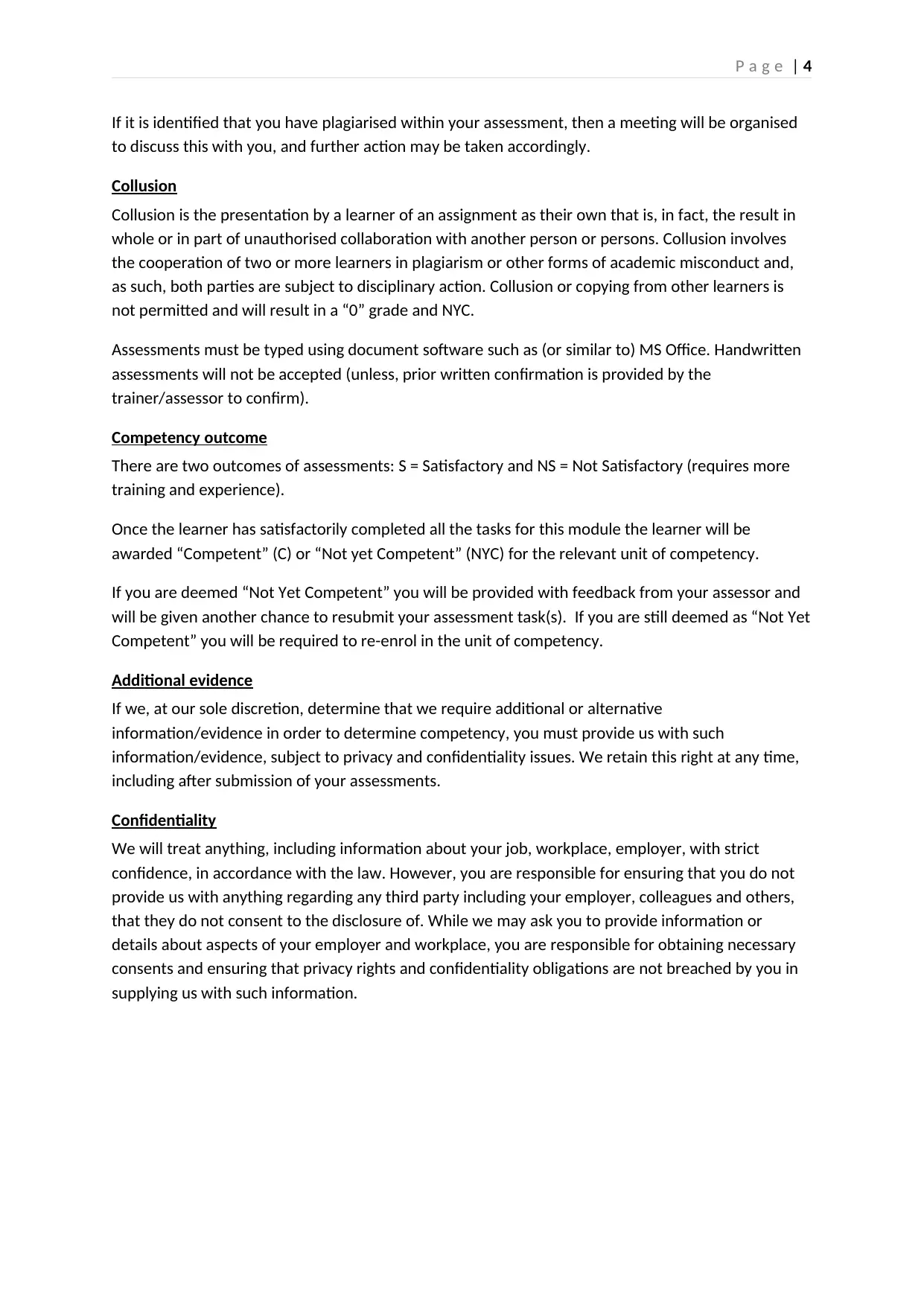
P a g e | 4
If it is identified that you have plagiarised within your assessment, then a meeting will be organised
to discuss this with you, and further action may be taken accordingly.
Collusion
Collusion is the presentation by a learner of an assignment as their own that is, in fact, the result in
whole or in part of unauthorised collaboration with another person or persons. Collusion involves
the cooperation of two or more learners in plagiarism or other forms of academic misconduct and,
as such, both parties are subject to disciplinary action. Collusion or copying from other learners is
not permitted and will result in a “0” grade and NYC.
Assessments must be typed using document software such as (or similar to) MS Office. Handwritten
assessments will not be accepted (unless, prior written confirmation is provided by the
trainer/assessor to confirm).
Competency outcome
There are two outcomes of assessments: S = Satisfactory and NS = Not Satisfactory (requires more
training and experience).
Once the learner has satisfactorily completed all the tasks for this module the learner will be
awarded “Competent” (C) or “Not yet Competent” (NYC) for the relevant unit of competency.
If you are deemed “Not Yet Competent” you will be provided with feedback from your assessor and
will be given another chance to resubmit your assessment task(s). If you are still deemed as “Not Yet
Competent” you will be required to re-enrol in the unit of competency.
Additional evidence
If we, at our sole discretion, determine that we require additional or alternative
information/evidence in order to determine competency, you must provide us with such
information/evidence, subject to privacy and confidentiality issues. We retain this right at any time,
including after submission of your assessments.
Confidentiality
We will treat anything, including information about your job, workplace, employer, with strict
confidence, in accordance with the law. However, you are responsible for ensuring that you do not
provide us with anything regarding any third party including your employer, colleagues and others,
that they do not consent to the disclosure of. While we may ask you to provide information or
details about aspects of your employer and workplace, you are responsible for obtaining necessary
consents and ensuring that privacy rights and confidentiality obligations are not breached by you in
supplying us with such information.
If it is identified that you have plagiarised within your assessment, then a meeting will be organised
to discuss this with you, and further action may be taken accordingly.
Collusion
Collusion is the presentation by a learner of an assignment as their own that is, in fact, the result in
whole or in part of unauthorised collaboration with another person or persons. Collusion involves
the cooperation of two or more learners in plagiarism or other forms of academic misconduct and,
as such, both parties are subject to disciplinary action. Collusion or copying from other learners is
not permitted and will result in a “0” grade and NYC.
Assessments must be typed using document software such as (or similar to) MS Office. Handwritten
assessments will not be accepted (unless, prior written confirmation is provided by the
trainer/assessor to confirm).
Competency outcome
There are two outcomes of assessments: S = Satisfactory and NS = Not Satisfactory (requires more
training and experience).
Once the learner has satisfactorily completed all the tasks for this module the learner will be
awarded “Competent” (C) or “Not yet Competent” (NYC) for the relevant unit of competency.
If you are deemed “Not Yet Competent” you will be provided with feedback from your assessor and
will be given another chance to resubmit your assessment task(s). If you are still deemed as “Not Yet
Competent” you will be required to re-enrol in the unit of competency.
Additional evidence
If we, at our sole discretion, determine that we require additional or alternative
information/evidence in order to determine competency, you must provide us with such
information/evidence, subject to privacy and confidentiality issues. We retain this right at any time,
including after submission of your assessments.
Confidentiality
We will treat anything, including information about your job, workplace, employer, with strict
confidence, in accordance with the law. However, you are responsible for ensuring that you do not
provide us with anything regarding any third party including your employer, colleagues and others,
that they do not consent to the disclosure of. While we may ask you to provide information or
details about aspects of your employer and workplace, you are responsible for obtaining necessary
consents and ensuring that privacy rights and confidentiality obligations are not breached by you in
supplying us with such information.
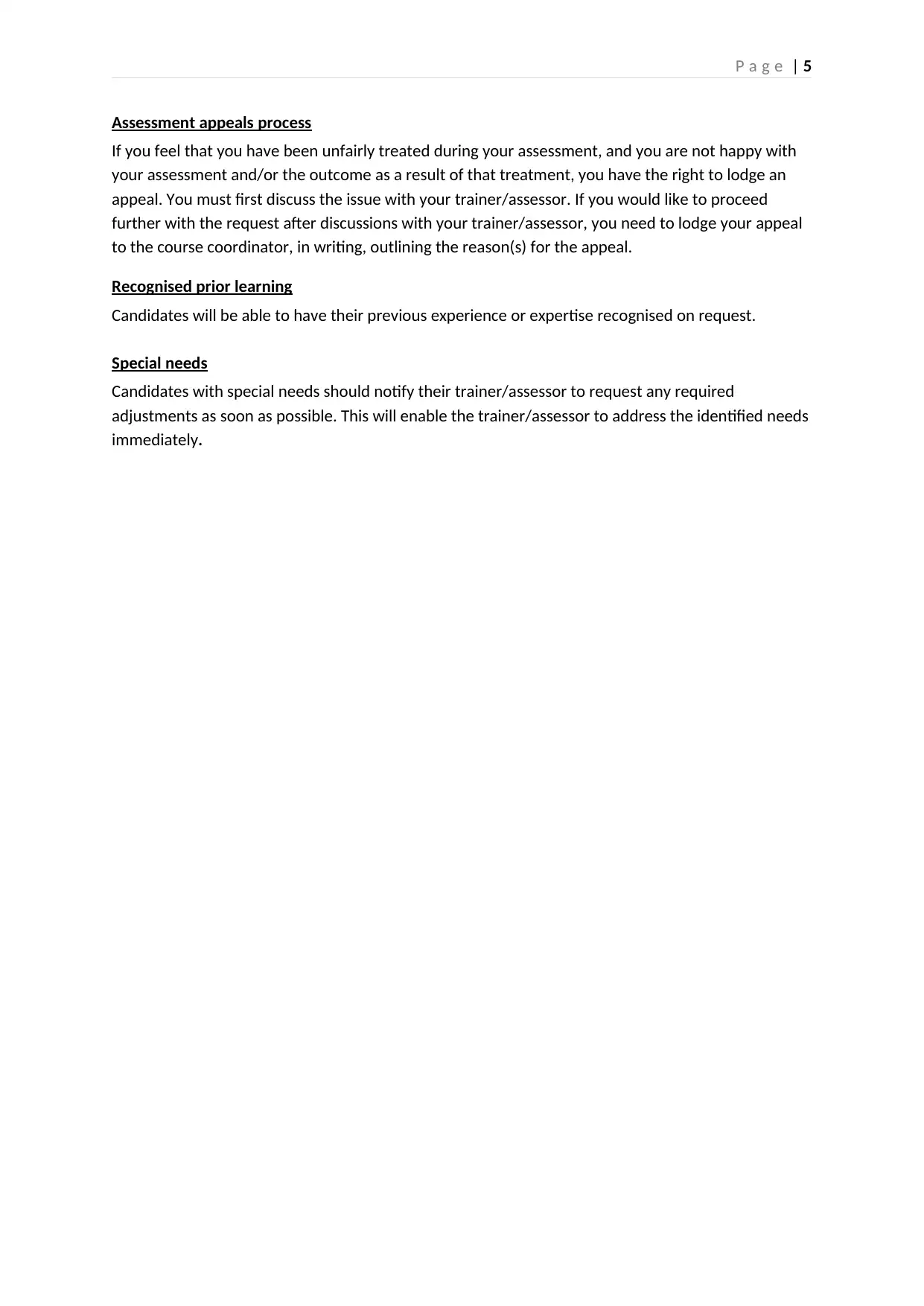
P a g e | 5
Assessment appeals process
If you feel that you have been unfairly treated during your assessment, and you are not happy with
your assessment and/or the outcome as a result of that treatment, you have the right to lodge an
appeal. You must first discuss the issue with your trainer/assessor. If you would like to proceed
further with the request after discussions with your trainer/assessor, you need to lodge your appeal
to the course coordinator, in writing, outlining the reason(s) for the appeal.
Recognised prior learning
Candidates will be able to have their previous experience or expertise recognised on request.
Special needs
Candidates with special needs should notify their trainer/assessor to request any required
adjustments as soon as possible. This will enable the trainer/assessor to address the identified needs
immediately .
Assessment appeals process
If you feel that you have been unfairly treated during your assessment, and you are not happy with
your assessment and/or the outcome as a result of that treatment, you have the right to lodge an
appeal. You must first discuss the issue with your trainer/assessor. If you would like to proceed
further with the request after discussions with your trainer/assessor, you need to lodge your appeal
to the course coordinator, in writing, outlining the reason(s) for the appeal.
Recognised prior learning
Candidates will be able to have their previous experience or expertise recognised on request.
Special needs
Candidates with special needs should notify their trainer/assessor to request any required
adjustments as soon as possible. This will enable the trainer/assessor to address the identified needs
immediately .
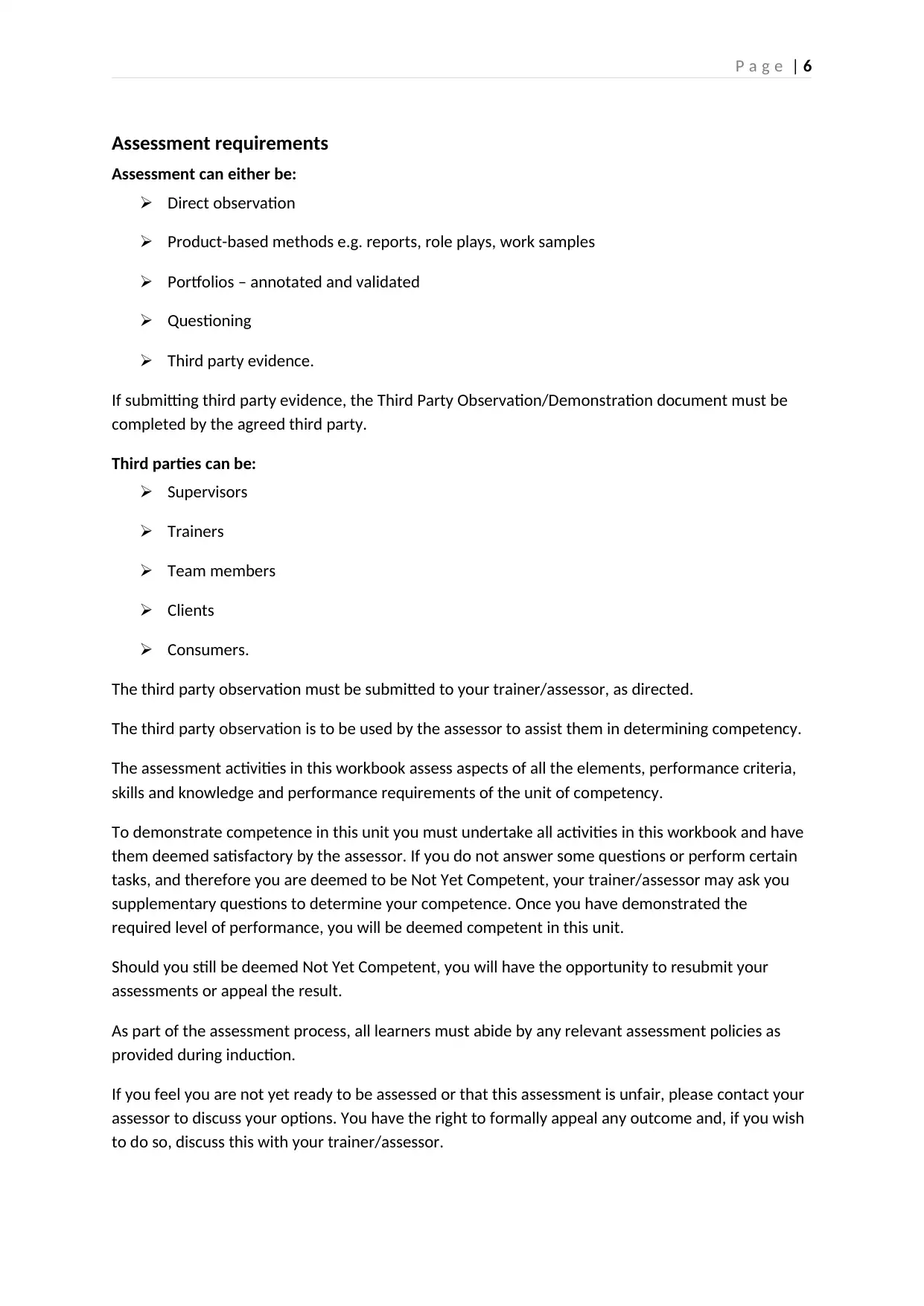
P a g e | 6
Assessment requirements
Assessment can either be:
Direct observation
Product-based methods e.g. reports, role plays, work samples
Portfolios – annotated and validated
Questioning
Third party evidence.
If submitting third party evidence, the Third Party Observation/Demonstration document must be
completed by the agreed third party.
Third parties can be:
Supervisors
Trainers
Team members
Clients
Consumers.
The third party observation must be submitted to your trainer/assessor, as directed.
The third party observation is to be used by the assessor to assist them in determining competency.
The assessment activities in this workbook assess aspects of all the elements, performance criteria,
skills and knowledge and performance requirements of the unit of competency.
To demonstrate competence in this unit you must undertake all activities in this workbook and have
them deemed satisfactory by the assessor. If you do not answer some questions or perform certain
tasks, and therefore you are deemed to be Not Yet Competent, your trainer/assessor may ask you
supplementary questions to determine your competence. Once you have demonstrated the
required level of performance, you will be deemed competent in this unit.
Should you still be deemed Not Yet Competent, you will have the opportunity to resubmit your
assessments or appeal the result.
As part of the assessment process, all learners must abide by any relevant assessment policies as
provided during induction.
If you feel you are not yet ready to be assessed or that this assessment is unfair, please contact your
assessor to discuss your options. You have the right to formally appeal any outcome and, if you wish
to do so, discuss this with your trainer/assessor.
Assessment requirements
Assessment can either be:
Direct observation
Product-based methods e.g. reports, role plays, work samples
Portfolios – annotated and validated
Questioning
Third party evidence.
If submitting third party evidence, the Third Party Observation/Demonstration document must be
completed by the agreed third party.
Third parties can be:
Supervisors
Trainers
Team members
Clients
Consumers.
The third party observation must be submitted to your trainer/assessor, as directed.
The third party observation is to be used by the assessor to assist them in determining competency.
The assessment activities in this workbook assess aspects of all the elements, performance criteria,
skills and knowledge and performance requirements of the unit of competency.
To demonstrate competence in this unit you must undertake all activities in this workbook and have
them deemed satisfactory by the assessor. If you do not answer some questions or perform certain
tasks, and therefore you are deemed to be Not Yet Competent, your trainer/assessor may ask you
supplementary questions to determine your competence. Once you have demonstrated the
required level of performance, you will be deemed competent in this unit.
Should you still be deemed Not Yet Competent, you will have the opportunity to resubmit your
assessments or appeal the result.
As part of the assessment process, all learners must abide by any relevant assessment policies as
provided during induction.
If you feel you are not yet ready to be assessed or that this assessment is unfair, please contact your
assessor to discuss your options. You have the right to formally appeal any outcome and, if you wish
to do so, discuss this with your trainer/assessor.
Paraphrase This Document
Need a fresh take? Get an instant paraphrase of this document with our AI Paraphraser

P a g e | 7
Candidate Details
Assessment – CHCDIV002: Promote Aboriginal and/or Torres Strait Islander cultural
safety
Please complete the following activities and hand in to your trainer/assessor for marking. This forms
part of your assessment for CHCDIV002: Promote Aboriginal and/or Torres Strait Islander cultural
safety.
Name: _____________________________________________________________
Address: _____________________________________________________________
_____________________________________________________________
Email: _____________________________________________________________
Employer: _____________________________________________________________
Declaration
I declare that no part of this assessment has been copied from another person’s work with the
exception of where I have listed or referenced documents or work and that no part of this
assessment has been written for me by another person. I also understand the assessment
instructions and requirements and consent to being assessed.
Signed: ____________________________________________________________
Date: ____________________________________________________________
If activities have been completed as part of a small group or in pairs, details of the learners
involved should be provided below:
This activity workbook has been completed by the following persons and we acknowledge that it
was a fair team effort where everyone contributed equally to the work completed. We declare that
no part of this assessment has been copied from another person’s work with the exception of where
we have listed or referenced documents or work and that no part of this assessment has been
written for us by another person.
Learner 1: ____________________________________________________________
Signed: ____________________________________________________________
Learner 2: ____________________________________________________________
Signed: ____________________________________________________________
Learner 3: ____________________________________________________________
Signed: ____________________________________________________________
Candidate Details
Assessment – CHCDIV002: Promote Aboriginal and/or Torres Strait Islander cultural
safety
Please complete the following activities and hand in to your trainer/assessor for marking. This forms
part of your assessment for CHCDIV002: Promote Aboriginal and/or Torres Strait Islander cultural
safety.
Name: _____________________________________________________________
Address: _____________________________________________________________
_____________________________________________________________
Email: _____________________________________________________________
Employer: _____________________________________________________________
Declaration
I declare that no part of this assessment has been copied from another person’s work with the
exception of where I have listed or referenced documents or work and that no part of this
assessment has been written for me by another person. I also understand the assessment
instructions and requirements and consent to being assessed.
Signed: ____________________________________________________________
Date: ____________________________________________________________
If activities have been completed as part of a small group or in pairs, details of the learners
involved should be provided below:
This activity workbook has been completed by the following persons and we acknowledge that it
was a fair team effort where everyone contributed equally to the work completed. We declare that
no part of this assessment has been copied from another person’s work with the exception of where
we have listed or referenced documents or work and that no part of this assessment has been
written for us by another person.
Learner 1: ____________________________________________________________
Signed: ____________________________________________________________
Learner 2: ____________________________________________________________
Signed: ____________________________________________________________
Learner 3: ____________________________________________________________
Signed: ____________________________________________________________

P a g e | 8
Observation/Demonstration
Throughout this unit, you will be expected to show your competency of the elements through
observations or demonstrations. Your trainer/assessor will have a list of demonstrations you must
complete or tasks to be observed. The observations and demonstrations will be completed as well as
the activities found in this workbook.
An explanation of observations and demonstrations:
Observation is on-the-job
The observation will usually require:
Performing a work based skill or task
Interaction with colleagues and/or customers.
Demonstration is off-the-job
A demonstration will require:
Performing a skill or task that is asked of you
Undertaking a simulation exercise.
Your trainer/assessor will inform you of which one of the above they would like you to do. The
observation/demonstration will cover one of the unit’s elements.
The observation/demonstration will take place either in the workplace or the training environment,
depending on the task to be undertaken and whether it is an observation or demonstration. Your
trainer/assessor will ensure you are provided with the correct equipment and/or materials to
complete the task. They will also inform you of how long you have to complete the task.
You should be able to demonstrate the skills, knowledge and performance criteria required for
competency in this unit, as seen in the Learner Guide.
Observation/Demonstration
Throughout this unit, you will be expected to show your competency of the elements through
observations or demonstrations. Your trainer/assessor will have a list of demonstrations you must
complete or tasks to be observed. The observations and demonstrations will be completed as well as
the activities found in this workbook.
An explanation of observations and demonstrations:
Observation is on-the-job
The observation will usually require:
Performing a work based skill or task
Interaction with colleagues and/or customers.
Demonstration is off-the-job
A demonstration will require:
Performing a skill or task that is asked of you
Undertaking a simulation exercise.
Your trainer/assessor will inform you of which one of the above they would like you to do. The
observation/demonstration will cover one of the unit’s elements.
The observation/demonstration will take place either in the workplace or the training environment,
depending on the task to be undertaken and whether it is an observation or demonstration. Your
trainer/assessor will ensure you are provided with the correct equipment and/or materials to
complete the task. They will also inform you of how long you have to complete the task.
You should be able to demonstrate the skills, knowledge and performance criteria required for
competency in this unit, as seen in the Learner Guide.
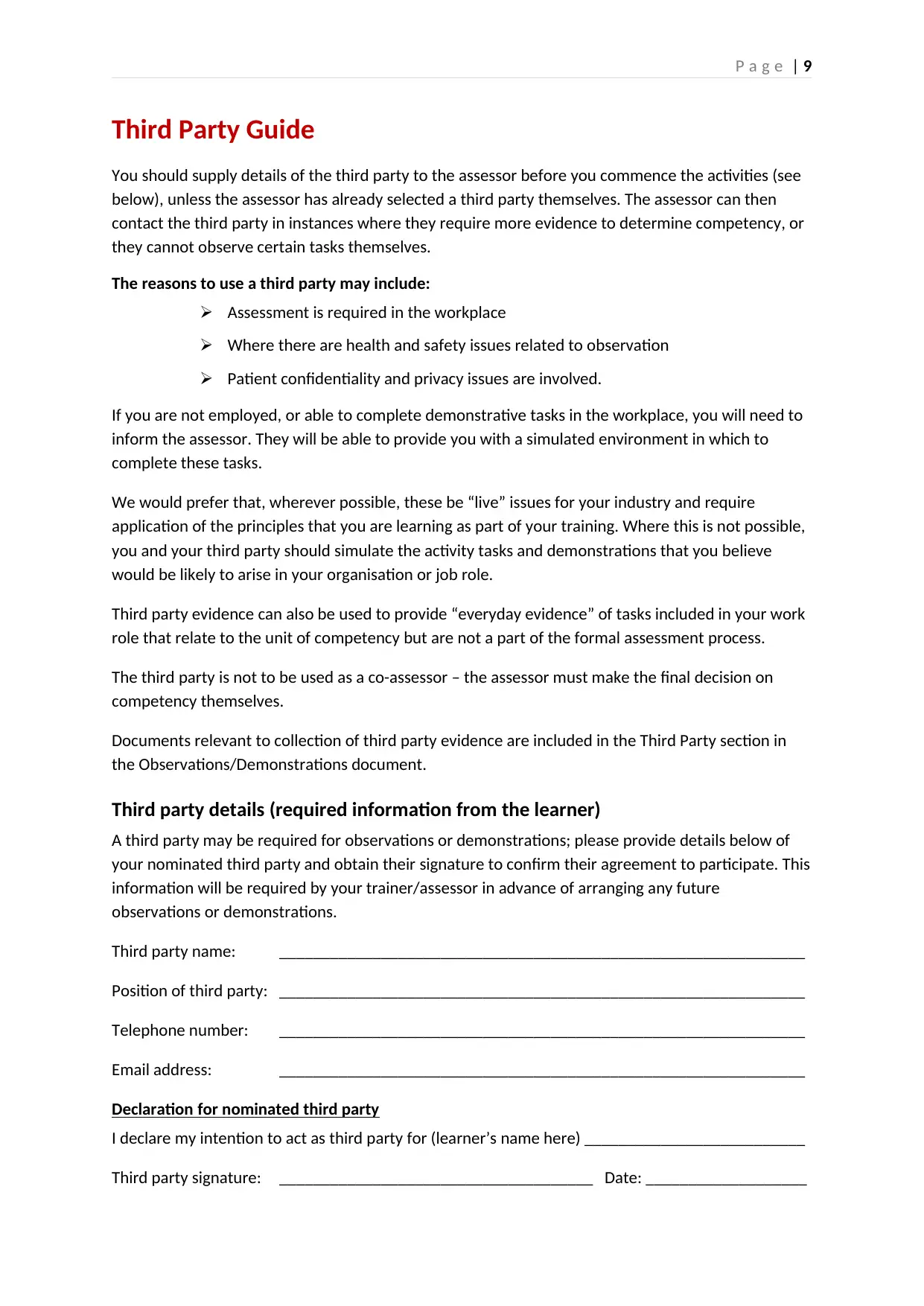
P a g e | 9
Third Party Guide
You should supply details of the third party to the assessor before you commence the activities (see
below), unless the assessor has already selected a third party themselves. The assessor can then
contact the third party in instances where they require more evidence to determine competency, or
they cannot observe certain tasks themselves.
The reasons to use a third party may include:
Assessment is required in the workplace
Where there are health and safety issues related to observation
Patient confidentiality and privacy issues are involved.
If you are not employed, or able to complete demonstrative tasks in the workplace, you will need to
inform the assessor. They will be able to provide you with a simulated environment in which to
complete these tasks.
We would prefer that, wherever possible, these be “live” issues for your industry and require
application of the principles that you are learning as part of your training. Where this is not possible,
you and your third party should simulate the activity tasks and demonstrations that you believe
would be likely to arise in your organisation or job role.
Third party evidence can also be used to provide “everyday evidence” of tasks included in your work
role that relate to the unit of competency but are not a part of the formal assessment process.
The third party is not to be used as a co-assessor – the assessor must make the final decision on
competency themselves.
Documents relevant to collection of third party evidence are included in the Third Party section in
the Observations/Demonstrations document.
Third party details (required information from the learner)
A third party may be required for observations or demonstrations; please provide details below of
your nominated third party and obtain their signature to confirm their agreement to participate. This
information will be required by your trainer/assessor in advance of arranging any future
observations or demonstrations.
Third party name: ______________________________________________________________
Position of third party: ______________________________________________________________
Telephone number: ______________________________________________________________
Email address: ______________________________________________________________
Declaration for nominated third party
I declare my intention to act as third party for (learner’s name here) __________________________
Third party signature: _____________________________________ Date: ___________________
Third Party Guide
You should supply details of the third party to the assessor before you commence the activities (see
below), unless the assessor has already selected a third party themselves. The assessor can then
contact the third party in instances where they require more evidence to determine competency, or
they cannot observe certain tasks themselves.
The reasons to use a third party may include:
Assessment is required in the workplace
Where there are health and safety issues related to observation
Patient confidentiality and privacy issues are involved.
If you are not employed, or able to complete demonstrative tasks in the workplace, you will need to
inform the assessor. They will be able to provide you with a simulated environment in which to
complete these tasks.
We would prefer that, wherever possible, these be “live” issues for your industry and require
application of the principles that you are learning as part of your training. Where this is not possible,
you and your third party should simulate the activity tasks and demonstrations that you believe
would be likely to arise in your organisation or job role.
Third party evidence can also be used to provide “everyday evidence” of tasks included in your work
role that relate to the unit of competency but are not a part of the formal assessment process.
The third party is not to be used as a co-assessor – the assessor must make the final decision on
competency themselves.
Documents relevant to collection of third party evidence are included in the Third Party section in
the Observations/Demonstrations document.
Third party details (required information from the learner)
A third party may be required for observations or demonstrations; please provide details below of
your nominated third party and obtain their signature to confirm their agreement to participate. This
information will be required by your trainer/assessor in advance of arranging any future
observations or demonstrations.
Third party name: ______________________________________________________________
Position of third party: ______________________________________________________________
Telephone number: ______________________________________________________________
Email address: ______________________________________________________________
Declaration for nominated third party
I declare my intention to act as third party for (learner’s name here) __________________________
Third party signature: _____________________________________ Date: ___________________
Secure Best Marks with AI Grader
Need help grading? Try our AI Grader for instant feedback on your assignments.
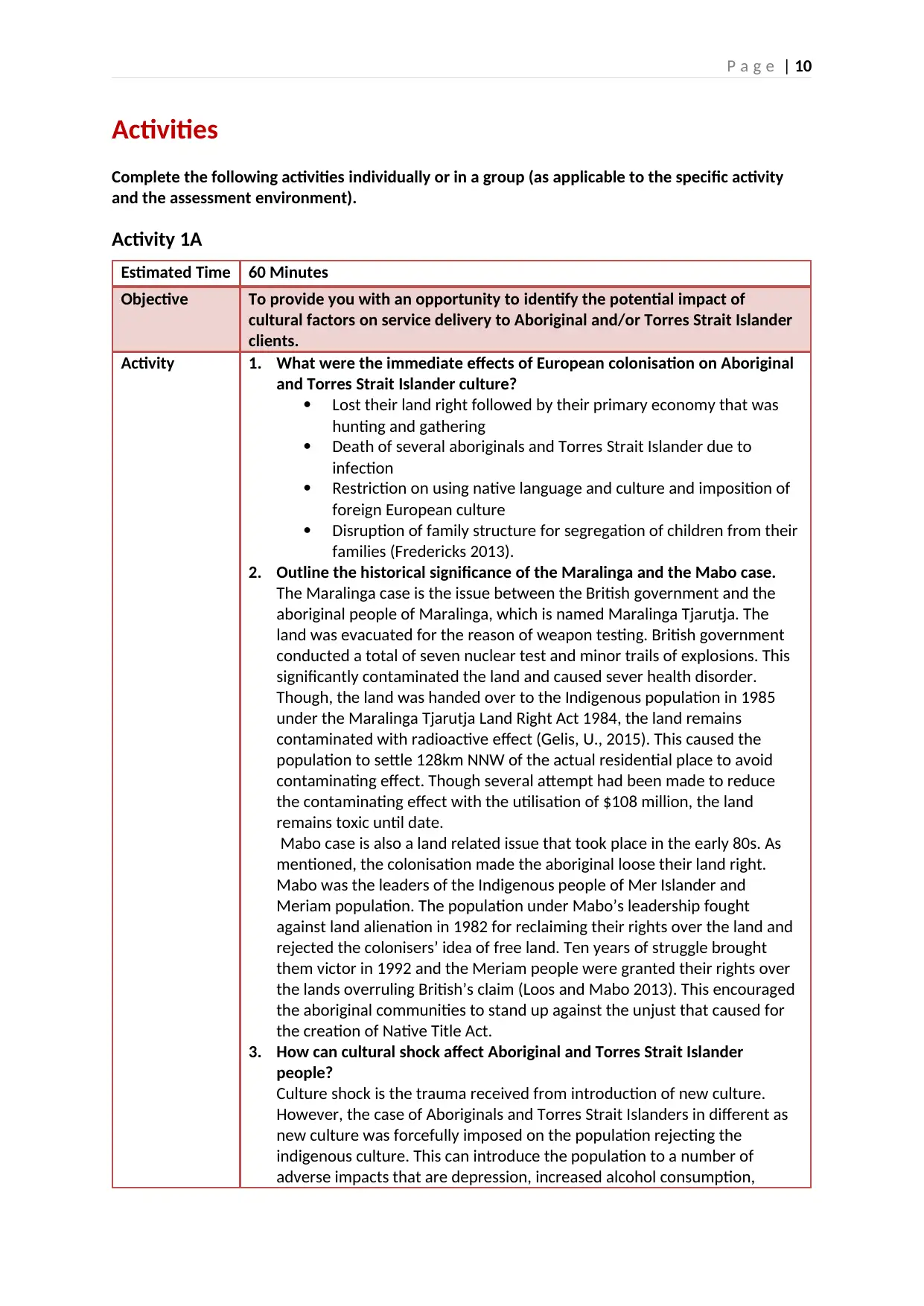
P a g e | 10
Activities
Complete the following activities individually or in a group (as applicable to the specific activity
and the assessment environment).
Activity 1A
Estimated Time 60 Minutes
Objective To provide you with an opportunity to identify the potential impact of
cultural factors on service delivery to Aboriginal and/or Torres Strait Islander
clients.
Activity 1. What were the immediate effects of European colonisation on Aboriginal
and Torres Strait Islander culture?
Lost their land right followed by their primary economy that was
hunting and gathering
Death of several aboriginals and Torres Strait Islander due to
infection
Restriction on using native language and culture and imposition of
foreign European culture
Disruption of family structure for segregation of children from their
families (Fredericks 2013).
2. Outline the historical significance of the Maralinga and the Mabo case.
The Maralinga case is the issue between the British government and the
aboriginal people of Maralinga, which is named Maralinga Tjarutja. The
land was evacuated for the reason of weapon testing. British government
conducted a total of seven nuclear test and minor trails of explosions. This
significantly contaminated the land and caused sever health disorder.
Though, the land was handed over to the Indigenous population in 1985
under the Maralinga Tjarutja Land Right Act 1984, the land remains
contaminated with radioactive effect (Gelis, U., 2015). This caused the
population to settle 128km NNW of the actual residential place to avoid
contaminating effect. Though several attempt had been made to reduce
the contaminating effect with the utilisation of $108 million, the land
remains toxic until date.
Mabo case is also a land related issue that took place in the early 80s. As
mentioned, the colonisation made the aboriginal loose their land right.
Mabo was the leaders of the Indigenous people of Mer Islander and
Meriam population. The population under Mabo’s leadership fought
against land alienation in 1982 for reclaiming their rights over the land and
rejected the colonisers’ idea of free land. Ten years of struggle brought
them victor in 1992 and the Meriam people were granted their rights over
the lands overruling British’s claim (Loos and Mabo 2013). This encouraged
the aboriginal communities to stand up against the unjust that caused for
the creation of Native Title Act.
3. How can cultural shock affect Aboriginal and Torres Strait Islander
people?
Culture shock is the trauma received from introduction of new culture.
However, the case of Aboriginals and Torres Strait Islanders in different as
new culture was forcefully imposed on the population rejecting the
indigenous culture. This can introduce the population to a number of
adverse impacts that are depression, increased alcohol consumption,
Activities
Complete the following activities individually or in a group (as applicable to the specific activity
and the assessment environment).
Activity 1A
Estimated Time 60 Minutes
Objective To provide you with an opportunity to identify the potential impact of
cultural factors on service delivery to Aboriginal and/or Torres Strait Islander
clients.
Activity 1. What were the immediate effects of European colonisation on Aboriginal
and Torres Strait Islander culture?
Lost their land right followed by their primary economy that was
hunting and gathering
Death of several aboriginals and Torres Strait Islander due to
infection
Restriction on using native language and culture and imposition of
foreign European culture
Disruption of family structure for segregation of children from their
families (Fredericks 2013).
2. Outline the historical significance of the Maralinga and the Mabo case.
The Maralinga case is the issue between the British government and the
aboriginal people of Maralinga, which is named Maralinga Tjarutja. The
land was evacuated for the reason of weapon testing. British government
conducted a total of seven nuclear test and minor trails of explosions. This
significantly contaminated the land and caused sever health disorder.
Though, the land was handed over to the Indigenous population in 1985
under the Maralinga Tjarutja Land Right Act 1984, the land remains
contaminated with radioactive effect (Gelis, U., 2015). This caused the
population to settle 128km NNW of the actual residential place to avoid
contaminating effect. Though several attempt had been made to reduce
the contaminating effect with the utilisation of $108 million, the land
remains toxic until date.
Mabo case is also a land related issue that took place in the early 80s. As
mentioned, the colonisation made the aboriginal loose their land right.
Mabo was the leaders of the Indigenous people of Mer Islander and
Meriam population. The population under Mabo’s leadership fought
against land alienation in 1982 for reclaiming their rights over the land and
rejected the colonisers’ idea of free land. Ten years of struggle brought
them victor in 1992 and the Meriam people were granted their rights over
the lands overruling British’s claim (Loos and Mabo 2013). This encouraged
the aboriginal communities to stand up against the unjust that caused for
the creation of Native Title Act.
3. How can cultural shock affect Aboriginal and Torres Strait Islander
people?
Culture shock is the trauma received from introduction of new culture.
However, the case of Aboriginals and Torres Strait Islanders in different as
new culture was forcefully imposed on the population rejecting the
indigenous culture. This can introduce the population to a number of
adverse impacts that are depression, increased alcohol consumption,
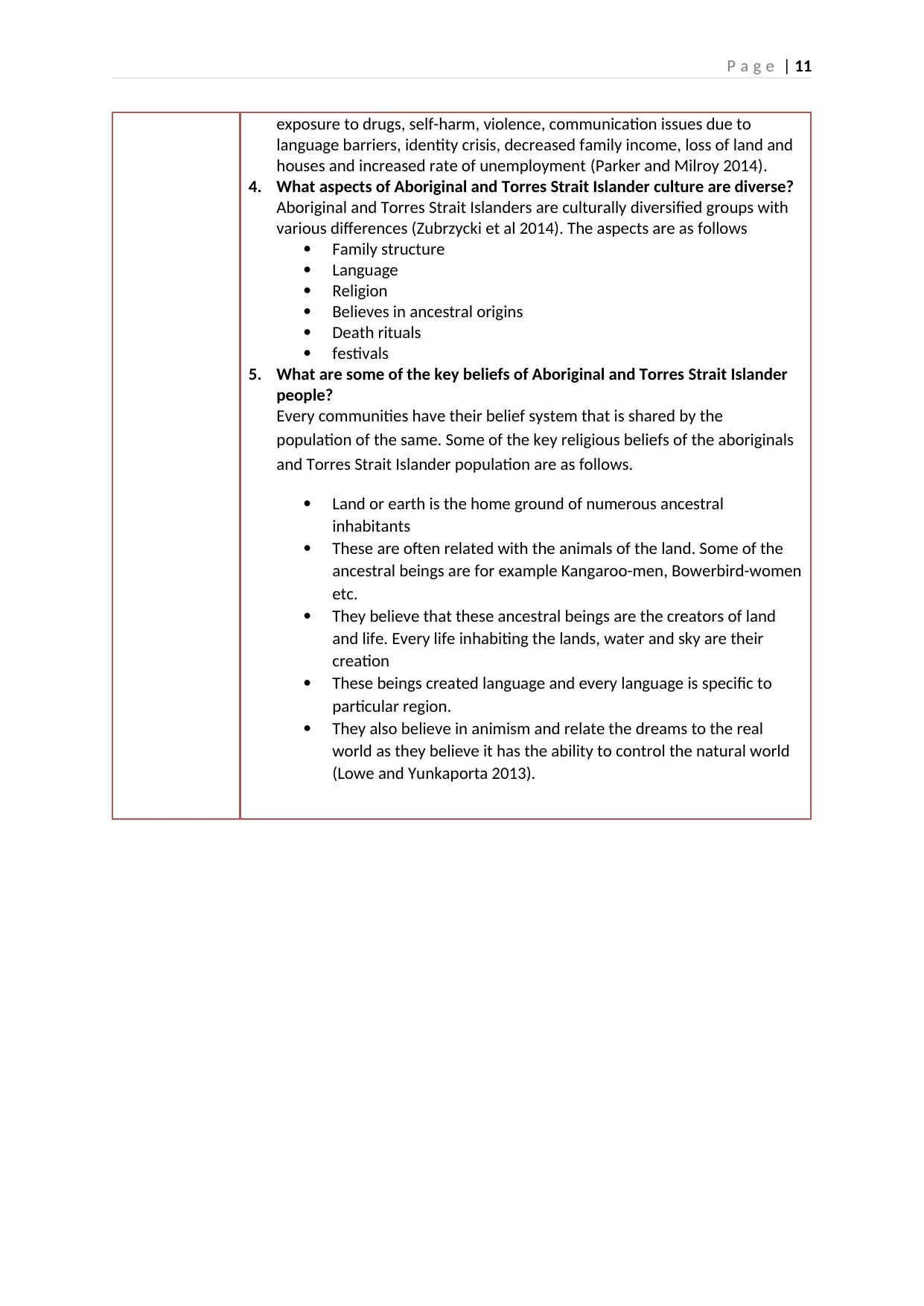
P a g e | 11
exposure to drugs, self-harm, violence, communication issues due to
language barriers, identity crisis, decreased family income, loss of land and
houses and increased rate of unemployment (Parker and Milroy 2014).
4. What aspects of Aboriginal and Torres Strait Islander culture are diverse?
Aboriginal and Torres Strait Islanders are culturally diversified groups with
various differences (Zubrzycki et al 2014). The aspects are as follows
Family structure
Language
Religion
Believes in ancestral origins
Death rituals
festivals
5. What are some of the key beliefs of Aboriginal and Torres Strait Islander
people?
Every communities have their belief system that is shared by the
population of the same. Some of the key religious beliefs of the aboriginals
and Torres Strait Islander population are as follows.
Land or earth is the home ground of numerous ancestral
inhabitants
These are often related with the animals of the land. Some of the
ancestral beings are for example Kangaroo-men, Bowerbird-women
etc.
They believe that these ancestral beings are the creators of land
and life. Every life inhabiting the lands, water and sky are their
creation
These beings created language and every language is specific to
particular region.
They also believe in animism and relate the dreams to the real
world as they believe it has the ability to control the natural world
(Lowe and Yunkaporta 2013).
exposure to drugs, self-harm, violence, communication issues due to
language barriers, identity crisis, decreased family income, loss of land and
houses and increased rate of unemployment (Parker and Milroy 2014).
4. What aspects of Aboriginal and Torres Strait Islander culture are diverse?
Aboriginal and Torres Strait Islanders are culturally diversified groups with
various differences (Zubrzycki et al 2014). The aspects are as follows
Family structure
Language
Religion
Believes in ancestral origins
Death rituals
festivals
5. What are some of the key beliefs of Aboriginal and Torres Strait Islander
people?
Every communities have their belief system that is shared by the
population of the same. Some of the key religious beliefs of the aboriginals
and Torres Strait Islander population are as follows.
Land or earth is the home ground of numerous ancestral
inhabitants
These are often related with the animals of the land. Some of the
ancestral beings are for example Kangaroo-men, Bowerbird-women
etc.
They believe that these ancestral beings are the creators of land
and life. Every life inhabiting the lands, water and sky are their
creation
These beings created language and every language is specific to
particular region.
They also believe in animism and relate the dreams to the real
world as they believe it has the ability to control the natural world
(Lowe and Yunkaporta 2013).
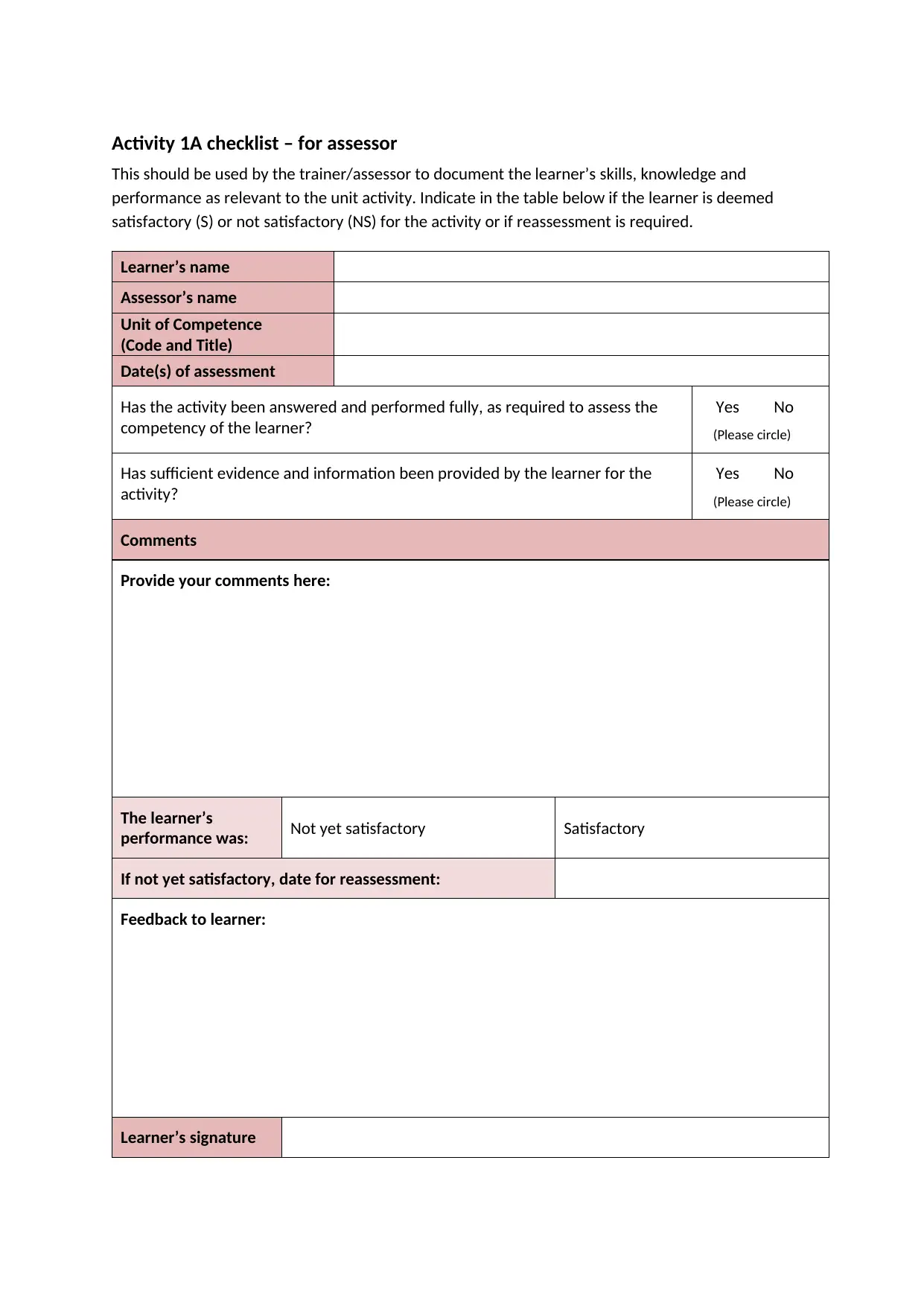
Activity 1A checklist – for assessor
This should be used by the trainer/assessor to document the learner’s skills, knowledge and
performance as relevant to the unit activity. Indicate in the table below if the learner is deemed
satisfactory (S) or not satisfactory (NS) for the activity or if reassessment is required.
Learner’s name
Assessor’s name
Unit of Competence
(Code and Title)
Date(s) of assessment
Has the activity been answered and performed fully, as required to assess the
competency of the learner?
Yes No
(Please circle)
Has sufficient evidence and information been provided by the learner for the
activity?
Yes No
(Please circle)
Comments
Provide your comments here:
The learner’s
performance was: Not yet satisfactory Satisfactory
If not yet satisfactory, date for reassessment:
Feedback to learner:
Learner’s signature
This should be used by the trainer/assessor to document the learner’s skills, knowledge and
performance as relevant to the unit activity. Indicate in the table below if the learner is deemed
satisfactory (S) or not satisfactory (NS) for the activity or if reassessment is required.
Learner’s name
Assessor’s name
Unit of Competence
(Code and Title)
Date(s) of assessment
Has the activity been answered and performed fully, as required to assess the
competency of the learner?
Yes No
(Please circle)
Has sufficient evidence and information been provided by the learner for the
activity?
Yes No
(Please circle)
Comments
Provide your comments here:
The learner’s
performance was: Not yet satisfactory Satisfactory
If not yet satisfactory, date for reassessment:
Feedback to learner:
Learner’s signature
Paraphrase This Document
Need a fresh take? Get an instant paraphrase of this document with our AI Paraphraser
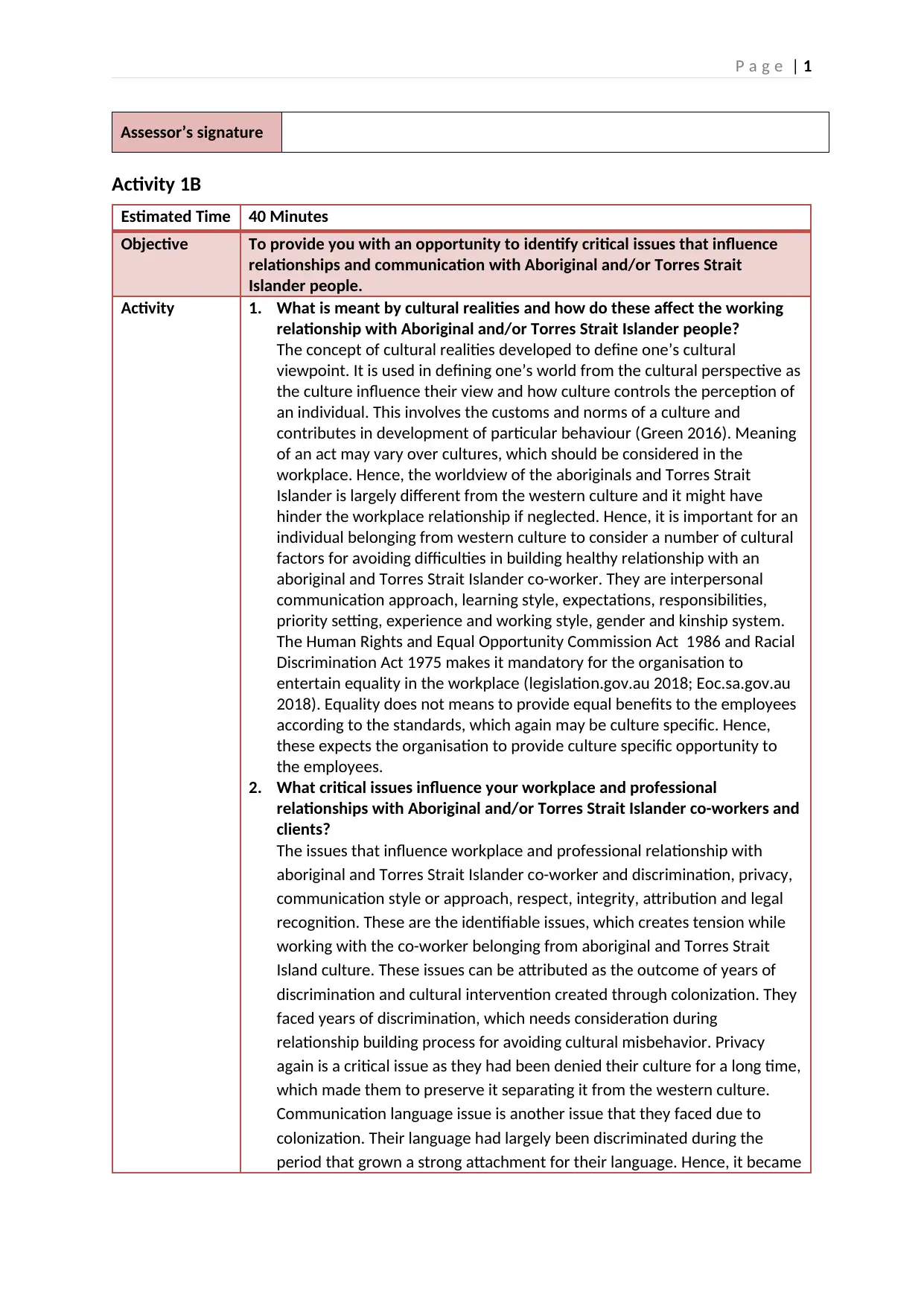
P a g e | 1
Assessor’s signature
Activity 1B
Estimated Time 40 Minutes
Objective To provide you with an opportunity to identify critical issues that influence
relationships and communication with Aboriginal and/or Torres Strait
Islander people.
Activity 1. What is meant by cultural realities and how do these affect the working
relationship with Aboriginal and/or Torres Strait Islander people?
The concept of cultural realities developed to define one’s cultural
viewpoint. It is used in defining one’s world from the cultural perspective as
the culture influence their view and how culture controls the perception of
an individual. This involves the customs and norms of a culture and
contributes in development of particular behaviour (Green 2016). Meaning
of an act may vary over cultures, which should be considered in the
workplace. Hence, the worldview of the aboriginals and Torres Strait
Islander is largely different from the western culture and it might have
hinder the workplace relationship if neglected. Hence, it is important for an
individual belonging from western culture to consider a number of cultural
factors for avoiding difficulties in building healthy relationship with an
aboriginal and Torres Strait Islander co-worker. They are interpersonal
communication approach, learning style, expectations, responsibilities,
priority setting, experience and working style, gender and kinship system.
The Human Rights and Equal Opportunity Commission Act 1986 and Racial
Discrimination Act 1975 makes it mandatory for the organisation to
entertain equality in the workplace (legislation.gov.au 2018; Eoc.sa.gov.au
2018). Equality does not means to provide equal benefits to the employees
according to the standards, which again may be culture specific. Hence,
these expects the organisation to provide culture specific opportunity to
the employees.
2. What critical issues influence your workplace and professional
relationships with Aboriginal and/or Torres Strait Islander co-workers and
clients?
The issues that influence workplace and professional relationship with
aboriginal and Torres Strait Islander co-worker and discrimination, privacy,
communication style or approach, respect, integrity, attribution and legal
recognition. These are the identifiable issues, which creates tension while
working with the co-worker belonging from aboriginal and Torres Strait
Island culture. These issues can be attributed as the outcome of years of
discrimination and cultural intervention created through colonization. They
faced years of discrimination, which needs consideration during
relationship building process for avoiding cultural misbehavior. Privacy
again is a critical issue as they had been denied their culture for a long time,
which made them to preserve it separating it from the western culture.
Communication language issue is another issue that they faced due to
colonization. Their language had largely been discriminated during the
period that grown a strong attachment for their language. Hence, it became
Assessor’s signature
Activity 1B
Estimated Time 40 Minutes
Objective To provide you with an opportunity to identify critical issues that influence
relationships and communication with Aboriginal and/or Torres Strait
Islander people.
Activity 1. What is meant by cultural realities and how do these affect the working
relationship with Aboriginal and/or Torres Strait Islander people?
The concept of cultural realities developed to define one’s cultural
viewpoint. It is used in defining one’s world from the cultural perspective as
the culture influence their view and how culture controls the perception of
an individual. This involves the customs and norms of a culture and
contributes in development of particular behaviour (Green 2016). Meaning
of an act may vary over cultures, which should be considered in the
workplace. Hence, the worldview of the aboriginals and Torres Strait
Islander is largely different from the western culture and it might have
hinder the workplace relationship if neglected. Hence, it is important for an
individual belonging from western culture to consider a number of cultural
factors for avoiding difficulties in building healthy relationship with an
aboriginal and Torres Strait Islander co-worker. They are interpersonal
communication approach, learning style, expectations, responsibilities,
priority setting, experience and working style, gender and kinship system.
The Human Rights and Equal Opportunity Commission Act 1986 and Racial
Discrimination Act 1975 makes it mandatory for the organisation to
entertain equality in the workplace (legislation.gov.au 2018; Eoc.sa.gov.au
2018). Equality does not means to provide equal benefits to the employees
according to the standards, which again may be culture specific. Hence,
these expects the organisation to provide culture specific opportunity to
the employees.
2. What critical issues influence your workplace and professional
relationships with Aboriginal and/or Torres Strait Islander co-workers and
clients?
The issues that influence workplace and professional relationship with
aboriginal and Torres Strait Islander co-worker and discrimination, privacy,
communication style or approach, respect, integrity, attribution and legal
recognition. These are the identifiable issues, which creates tension while
working with the co-worker belonging from aboriginal and Torres Strait
Island culture. These issues can be attributed as the outcome of years of
discrimination and cultural intervention created through colonization. They
faced years of discrimination, which needs consideration during
relationship building process for avoiding cultural misbehavior. Privacy
again is a critical issue as they had been denied their culture for a long time,
which made them to preserve it separating it from the western culture.
Communication language issue is another issue that they faced due to
colonization. Their language had largely been discriminated during the
period that grown a strong attachment for their language. Hence, it became
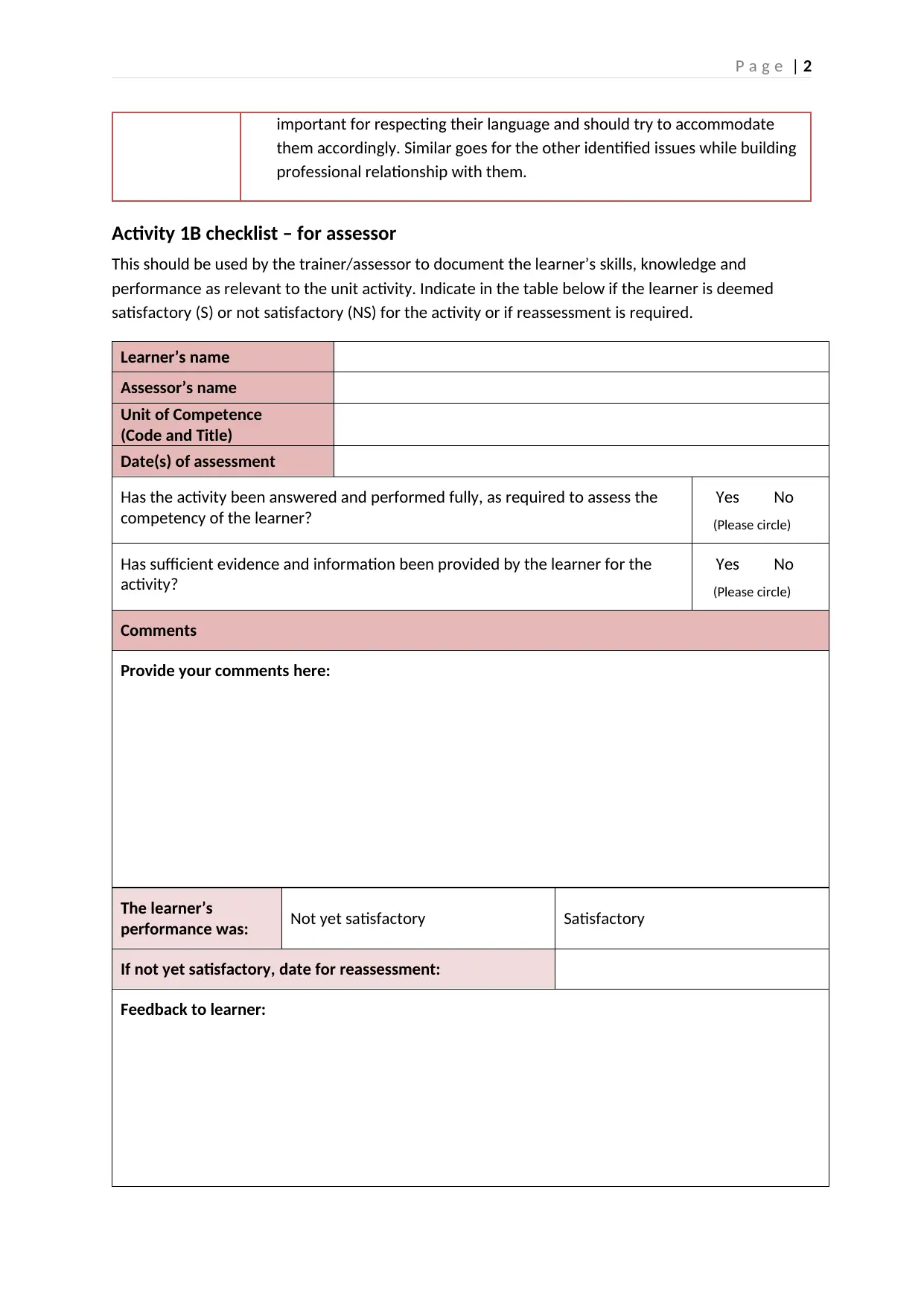
P a g e | 2
important for respecting their language and should try to accommodate
them accordingly. Similar goes for the other identified issues while building
professional relationship with them.
Activity 1B checklist – for assessor
This should be used by the trainer/assessor to document the learner’s skills, knowledge and
performance as relevant to the unit activity. Indicate in the table below if the learner is deemed
satisfactory (S) or not satisfactory (NS) for the activity or if reassessment is required.
Learner’s name
Assessor’s name
Unit of Competence
(Code and Title)
Date(s) of assessment
Has the activity been answered and performed fully, as required to assess the
competency of the learner?
Yes No
(Please circle)
Has sufficient evidence and information been provided by the learner for the
activity?
Yes No
(Please circle)
Comments
Provide your comments here:
The learner’s
performance was: Not yet satisfactory Satisfactory
If not yet satisfactory, date for reassessment:
Feedback to learner:
important for respecting their language and should try to accommodate
them accordingly. Similar goes for the other identified issues while building
professional relationship with them.
Activity 1B checklist – for assessor
This should be used by the trainer/assessor to document the learner’s skills, knowledge and
performance as relevant to the unit activity. Indicate in the table below if the learner is deemed
satisfactory (S) or not satisfactory (NS) for the activity or if reassessment is required.
Learner’s name
Assessor’s name
Unit of Competence
(Code and Title)
Date(s) of assessment
Has the activity been answered and performed fully, as required to assess the
competency of the learner?
Yes No
(Please circle)
Has sufficient evidence and information been provided by the learner for the
activity?
Yes No
(Please circle)
Comments
Provide your comments here:
The learner’s
performance was: Not yet satisfactory Satisfactory
If not yet satisfactory, date for reassessment:
Feedback to learner:
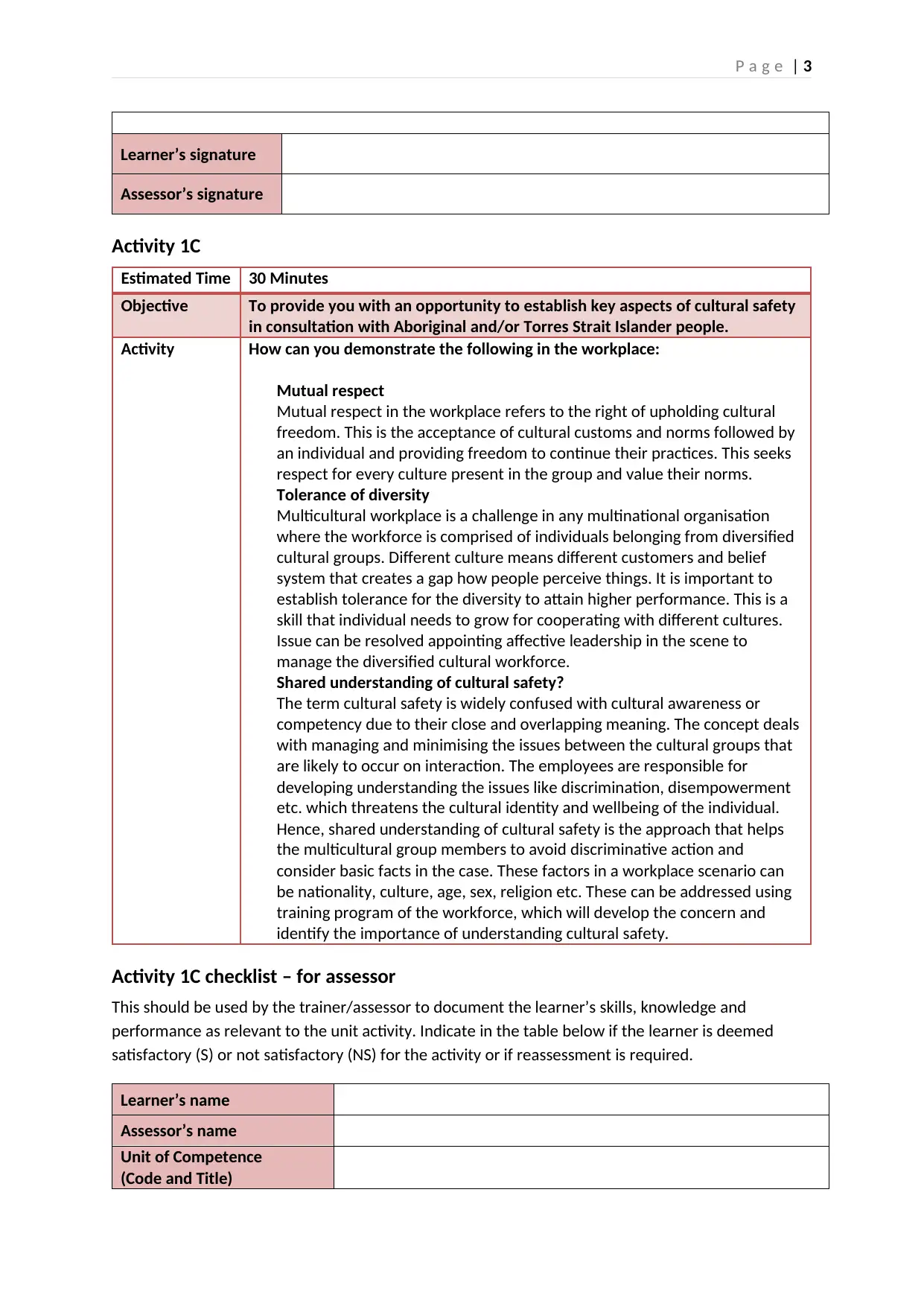
P a g e | 3
Learner’s signature
Assessor’s signature
Activity 1C
Estimated Time 30 Minutes
Objective To provide you with an opportunity to establish key aspects of cultural safety
in consultation with Aboriginal and/or Torres Strait Islander people.
Activity How can you demonstrate the following in the workplace:
Mutual respect
Mutual respect in the workplace refers to the right of upholding cultural
freedom. This is the acceptance of cultural customs and norms followed by
an individual and providing freedom to continue their practices. This seeks
respect for every culture present in the group and value their norms.
Tolerance of diversity
Multicultural workplace is a challenge in any multinational organisation
where the workforce is comprised of individuals belonging from diversified
cultural groups. Different culture means different customers and belief
system that creates a gap how people perceive things. It is important to
establish tolerance for the diversity to attain higher performance. This is a
skill that individual needs to grow for cooperating with different cultures.
Issue can be resolved appointing affective leadership in the scene to
manage the diversified cultural workforce.
Shared understanding of cultural safety?
The term cultural safety is widely confused with cultural awareness or
competency due to their close and overlapping meaning. The concept deals
with managing and minimising the issues between the cultural groups that
are likely to occur on interaction. The employees are responsible for
developing understanding the issues like discrimination, disempowerment
etc. which threatens the cultural identity and wellbeing of the individual.
Hence, shared understanding of cultural safety is the approach that helps
the multicultural group members to avoid discriminative action and
consider basic facts in the case. These factors in a workplace scenario can
be nationality, culture, age, sex, religion etc. These can be addressed using
training program of the workforce, which will develop the concern and
identify the importance of understanding cultural safety.
Activity 1C checklist – for assessor
This should be used by the trainer/assessor to document the learner’s skills, knowledge and
performance as relevant to the unit activity. Indicate in the table below if the learner is deemed
satisfactory (S) or not satisfactory (NS) for the activity or if reassessment is required.
Learner’s name
Assessor’s name
Unit of Competence
(Code and Title)
Learner’s signature
Assessor’s signature
Activity 1C
Estimated Time 30 Minutes
Objective To provide you with an opportunity to establish key aspects of cultural safety
in consultation with Aboriginal and/or Torres Strait Islander people.
Activity How can you demonstrate the following in the workplace:
Mutual respect
Mutual respect in the workplace refers to the right of upholding cultural
freedom. This is the acceptance of cultural customs and norms followed by
an individual and providing freedom to continue their practices. This seeks
respect for every culture present in the group and value their norms.
Tolerance of diversity
Multicultural workplace is a challenge in any multinational organisation
where the workforce is comprised of individuals belonging from diversified
cultural groups. Different culture means different customers and belief
system that creates a gap how people perceive things. It is important to
establish tolerance for the diversity to attain higher performance. This is a
skill that individual needs to grow for cooperating with different cultures.
Issue can be resolved appointing affective leadership in the scene to
manage the diversified cultural workforce.
Shared understanding of cultural safety?
The term cultural safety is widely confused with cultural awareness or
competency due to their close and overlapping meaning. The concept deals
with managing and minimising the issues between the cultural groups that
are likely to occur on interaction. The employees are responsible for
developing understanding the issues like discrimination, disempowerment
etc. which threatens the cultural identity and wellbeing of the individual.
Hence, shared understanding of cultural safety is the approach that helps
the multicultural group members to avoid discriminative action and
consider basic facts in the case. These factors in a workplace scenario can
be nationality, culture, age, sex, religion etc. These can be addressed using
training program of the workforce, which will develop the concern and
identify the importance of understanding cultural safety.
Activity 1C checklist – for assessor
This should be used by the trainer/assessor to document the learner’s skills, knowledge and
performance as relevant to the unit activity. Indicate in the table below if the learner is deemed
satisfactory (S) or not satisfactory (NS) for the activity or if reassessment is required.
Learner’s name
Assessor’s name
Unit of Competence
(Code and Title)
Secure Best Marks with AI Grader
Need help grading? Try our AI Grader for instant feedback on your assignments.
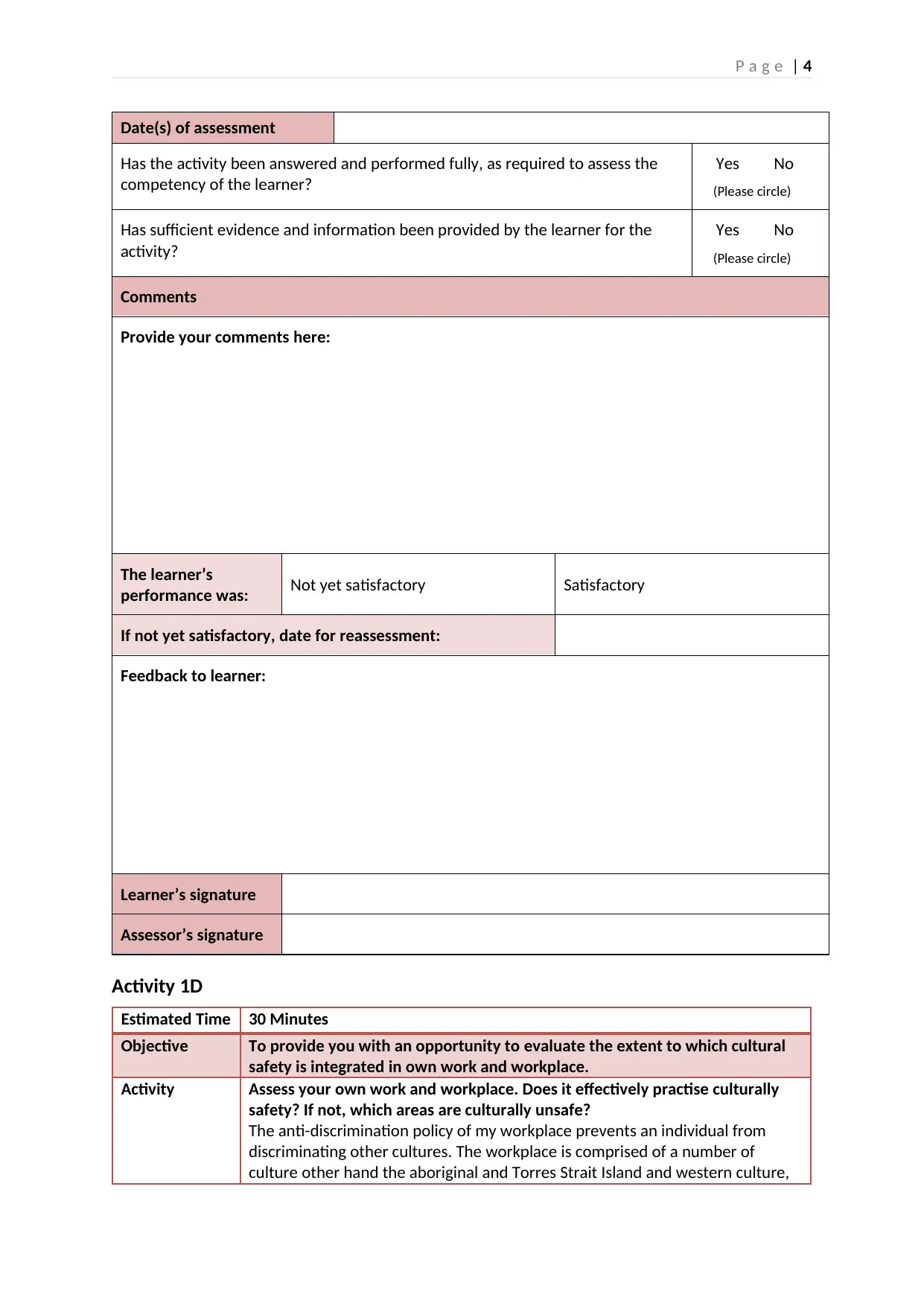
P a g e | 4
Date(s) of assessment
Has the activity been answered and performed fully, as required to assess the
competency of the learner?
Yes No
(Please circle)
Has sufficient evidence and information been provided by the learner for the
activity?
Yes No
(Please circle)
Comments
Provide your comments here:
The learner’s
performance was: Not yet satisfactory Satisfactory
If not yet satisfactory, date for reassessment:
Feedback to learner:
Learner’s signature
Assessor’s signature
Activity 1D
Estimated Time 30 Minutes
Objective To provide you with an opportunity to evaluate the extent to which cultural
safety is integrated in own work and workplace.
Activity Assess your own work and workplace. Does it effectively practise culturally
safety? If not, which areas are culturally unsafe?
The anti-discrimination policy of my workplace prevents an individual from
discriminating other cultures. The workplace is comprised of a number of
culture other hand the aboriginal and Torres Strait Island and western culture,
Date(s) of assessment
Has the activity been answered and performed fully, as required to assess the
competency of the learner?
Yes No
(Please circle)
Has sufficient evidence and information been provided by the learner for the
activity?
Yes No
(Please circle)
Comments
Provide your comments here:
The learner’s
performance was: Not yet satisfactory Satisfactory
If not yet satisfactory, date for reassessment:
Feedback to learner:
Learner’s signature
Assessor’s signature
Activity 1D
Estimated Time 30 Minutes
Objective To provide you with an opportunity to evaluate the extent to which cultural
safety is integrated in own work and workplace.
Activity Assess your own work and workplace. Does it effectively practise culturally
safety? If not, which areas are culturally unsafe?
The anti-discrimination policy of my workplace prevents an individual from
discriminating other cultures. The workplace is comprised of a number of
culture other hand the aboriginal and Torres Strait Island and western culture,
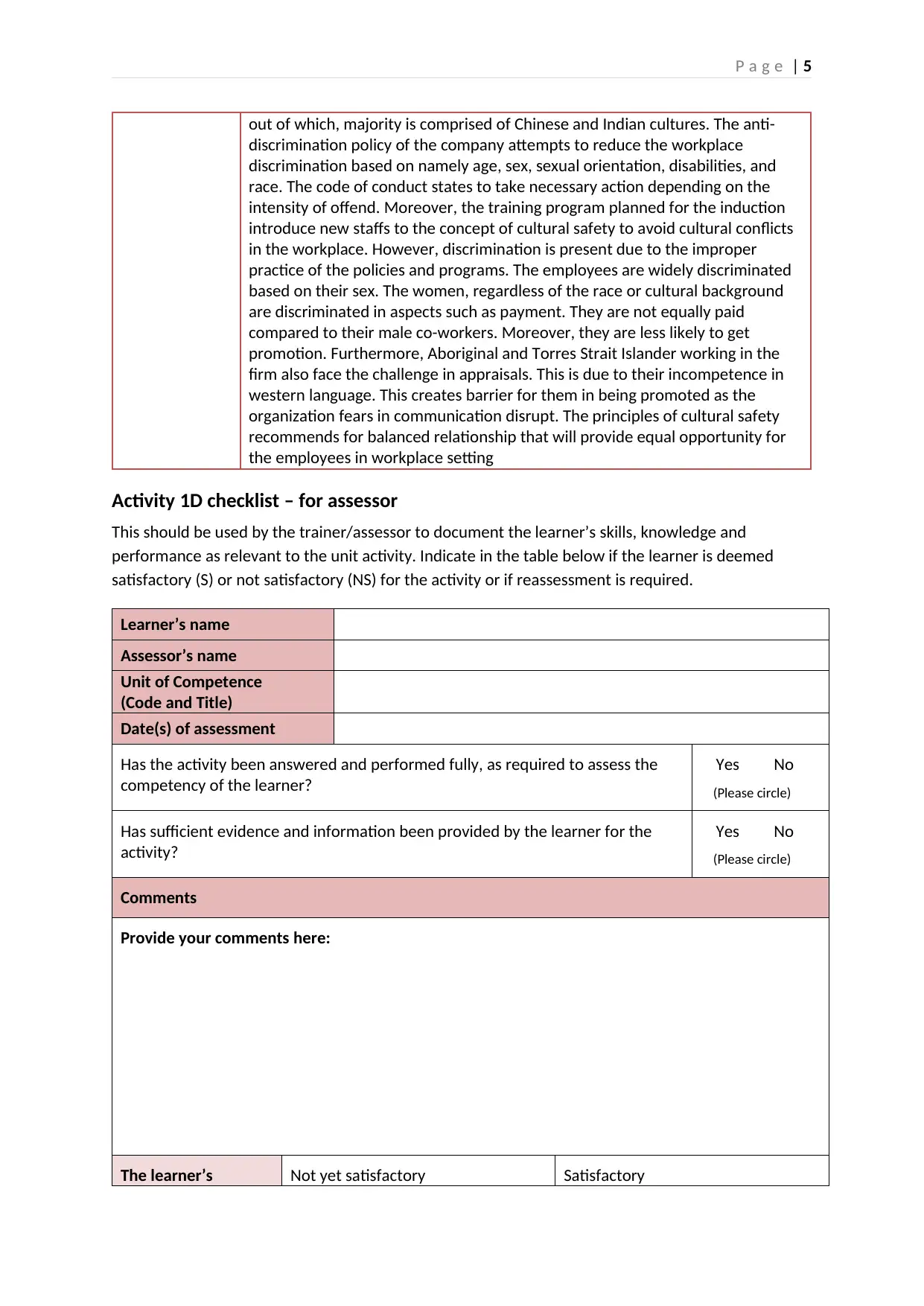
P a g e | 5
out of which, majority is comprised of Chinese and Indian cultures. The anti-
discrimination policy of the company attempts to reduce the workplace
discrimination based on namely age, sex, sexual orientation, disabilities, and
race. The code of conduct states to take necessary action depending on the
intensity of offend. Moreover, the training program planned for the induction
introduce new staffs to the concept of cultural safety to avoid cultural conflicts
in the workplace. However, discrimination is present due to the improper
practice of the policies and programs. The employees are widely discriminated
based on their sex. The women, regardless of the race or cultural background
are discriminated in aspects such as payment. They are not equally paid
compared to their male co-workers. Moreover, they are less likely to get
promotion. Furthermore, Aboriginal and Torres Strait Islander working in the
firm also face the challenge in appraisals. This is due to their incompetence in
western language. This creates barrier for them in being promoted as the
organization fears in communication disrupt. The principles of cultural safety
recommends for balanced relationship that will provide equal opportunity for
the employees in workplace setting
Activity 1D checklist – for assessor
This should be used by the trainer/assessor to document the learner’s skills, knowledge and
performance as relevant to the unit activity. Indicate in the table below if the learner is deemed
satisfactory (S) or not satisfactory (NS) for the activity or if reassessment is required.
Learner’s name
Assessor’s name
Unit of Competence
(Code and Title)
Date(s) of assessment
Has the activity been answered and performed fully, as required to assess the
competency of the learner?
Yes No
(Please circle)
Has sufficient evidence and information been provided by the learner for the
activity?
Yes No
(Please circle)
Comments
Provide your comments here:
The learner’s Not yet satisfactory Satisfactory
out of which, majority is comprised of Chinese and Indian cultures. The anti-
discrimination policy of the company attempts to reduce the workplace
discrimination based on namely age, sex, sexual orientation, disabilities, and
race. The code of conduct states to take necessary action depending on the
intensity of offend. Moreover, the training program planned for the induction
introduce new staffs to the concept of cultural safety to avoid cultural conflicts
in the workplace. However, discrimination is present due to the improper
practice of the policies and programs. The employees are widely discriminated
based on their sex. The women, regardless of the race or cultural background
are discriminated in aspects such as payment. They are not equally paid
compared to their male co-workers. Moreover, they are less likely to get
promotion. Furthermore, Aboriginal and Torres Strait Islander working in the
firm also face the challenge in appraisals. This is due to their incompetence in
western language. This creates barrier for them in being promoted as the
organization fears in communication disrupt. The principles of cultural safety
recommends for balanced relationship that will provide equal opportunity for
the employees in workplace setting
Activity 1D checklist – for assessor
This should be used by the trainer/assessor to document the learner’s skills, knowledge and
performance as relevant to the unit activity. Indicate in the table below if the learner is deemed
satisfactory (S) or not satisfactory (NS) for the activity or if reassessment is required.
Learner’s name
Assessor’s name
Unit of Competence
(Code and Title)
Date(s) of assessment
Has the activity been answered and performed fully, as required to assess the
competency of the learner?
Yes No
(Please circle)
Has sufficient evidence and information been provided by the learner for the
activity?
Yes No
(Please circle)
Comments
Provide your comments here:
The learner’s Not yet satisfactory Satisfactory
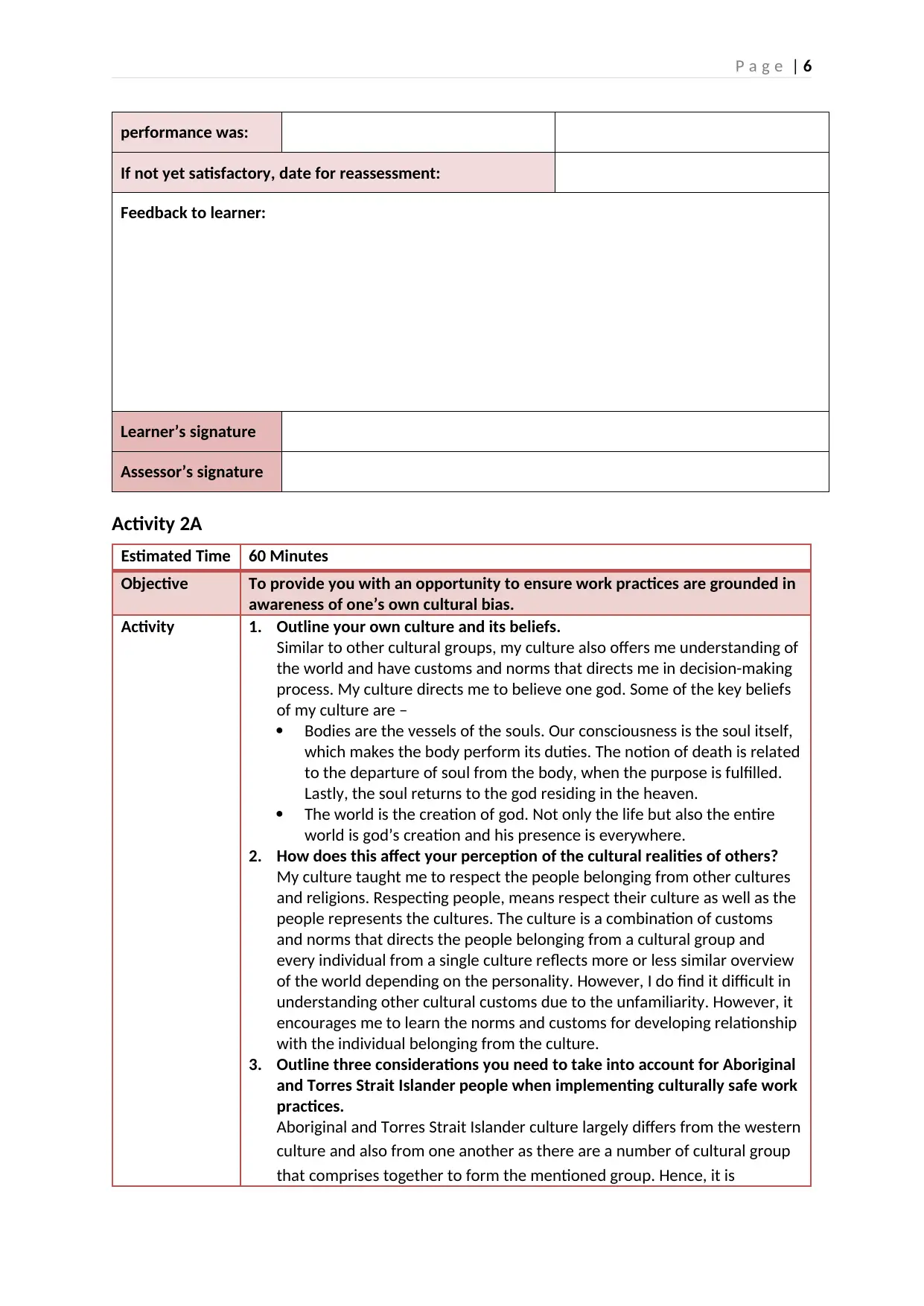
P a g e | 6
performance was:
If not yet satisfactory, date for reassessment:
Feedback to learner:
Learner’s signature
Assessor’s signature
Activity 2A
Estimated Time 60 Minutes
Objective To provide you with an opportunity to ensure work practices are grounded in
awareness of one’s own cultural bias.
Activity 1. Outline your own culture and its beliefs.
Similar to other cultural groups, my culture also offers me understanding of
the world and have customs and norms that directs me in decision-making
process. My culture directs me to believe one god. Some of the key beliefs
of my culture are –
Bodies are the vessels of the souls. Our consciousness is the soul itself,
which makes the body perform its duties. The notion of death is related
to the departure of soul from the body, when the purpose is fulfilled.
Lastly, the soul returns to the god residing in the heaven.
The world is the creation of god. Not only the life but also the entire
world is god’s creation and his presence is everywhere.
2. How does this affect your perception of the cultural realities of others?
My culture taught me to respect the people belonging from other cultures
and religions. Respecting people, means respect their culture as well as the
people represents the cultures. The culture is a combination of customs
and norms that directs the people belonging from a cultural group and
every individual from a single culture reflects more or less similar overview
of the world depending on the personality. However, I do find it difficult in
understanding other cultural customs due to the unfamiliarity. However, it
encourages me to learn the norms and customs for developing relationship
with the individual belonging from the culture.
3. Outline three considerations you need to take into account for Aboriginal
and Torres Strait Islander people when implementing culturally safe work
practices.
Aboriginal and Torres Strait Islander culture largely differs from the western
culture and also from one another as there are a number of cultural group
that comprises together to form the mentioned group. Hence, it is
performance was:
If not yet satisfactory, date for reassessment:
Feedback to learner:
Learner’s signature
Assessor’s signature
Activity 2A
Estimated Time 60 Minutes
Objective To provide you with an opportunity to ensure work practices are grounded in
awareness of one’s own cultural bias.
Activity 1. Outline your own culture and its beliefs.
Similar to other cultural groups, my culture also offers me understanding of
the world and have customs and norms that directs me in decision-making
process. My culture directs me to believe one god. Some of the key beliefs
of my culture are –
Bodies are the vessels of the souls. Our consciousness is the soul itself,
which makes the body perform its duties. The notion of death is related
to the departure of soul from the body, when the purpose is fulfilled.
Lastly, the soul returns to the god residing in the heaven.
The world is the creation of god. Not only the life but also the entire
world is god’s creation and his presence is everywhere.
2. How does this affect your perception of the cultural realities of others?
My culture taught me to respect the people belonging from other cultures
and religions. Respecting people, means respect their culture as well as the
people represents the cultures. The culture is a combination of customs
and norms that directs the people belonging from a cultural group and
every individual from a single culture reflects more or less similar overview
of the world depending on the personality. However, I do find it difficult in
understanding other cultural customs due to the unfamiliarity. However, it
encourages me to learn the norms and customs for developing relationship
with the individual belonging from the culture.
3. Outline three considerations you need to take into account for Aboriginal
and Torres Strait Islander people when implementing culturally safe work
practices.
Aboriginal and Torres Strait Islander culture largely differs from the western
culture and also from one another as there are a number of cultural group
that comprises together to form the mentioned group. Hence, it is
Paraphrase This Document
Need a fresh take? Get an instant paraphrase of this document with our AI Paraphraser
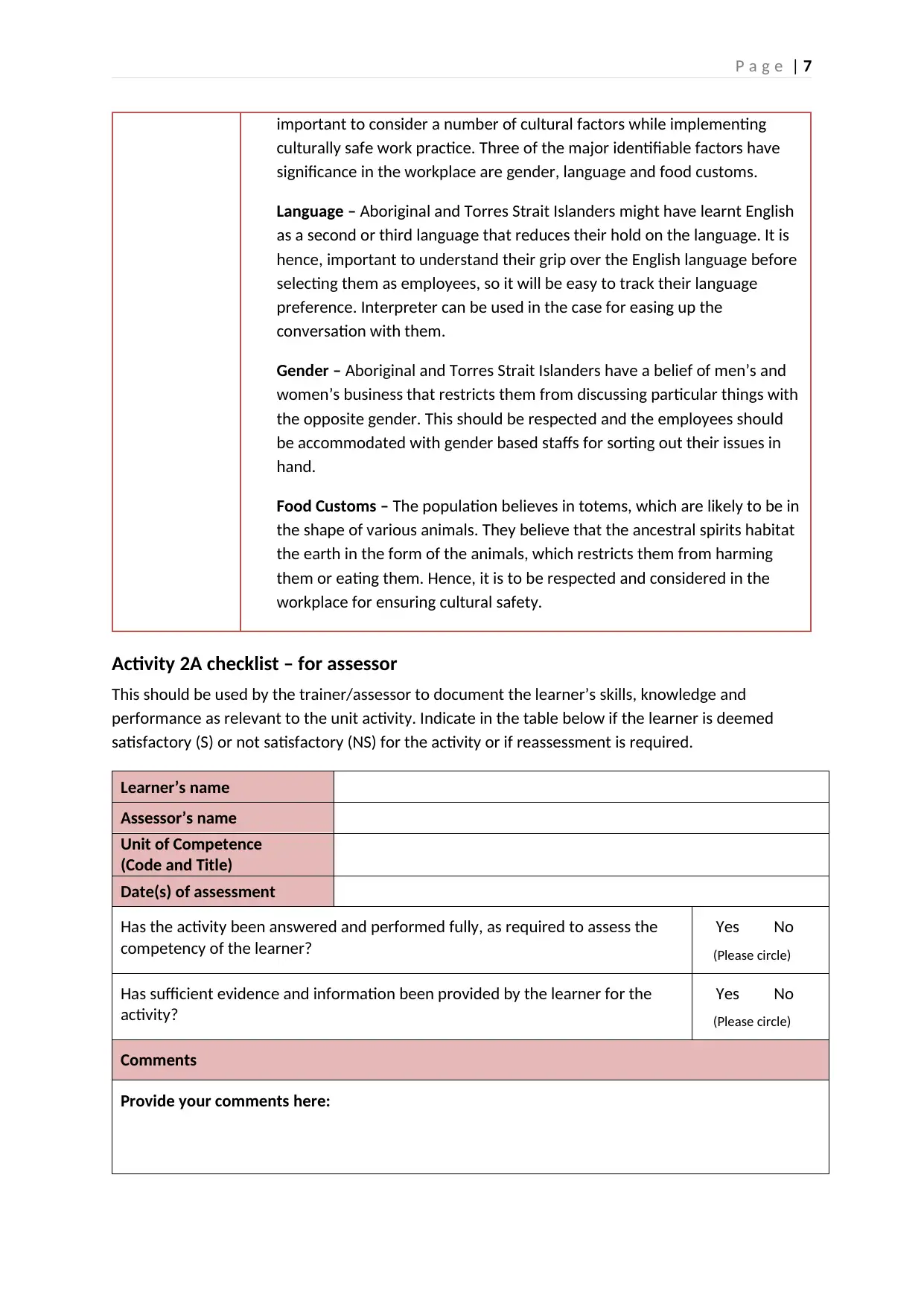
P a g e | 7
important to consider a number of cultural factors while implementing
culturally safe work practice. Three of the major identifiable factors have
significance in the workplace are gender, language and food customs.
Language – Aboriginal and Torres Strait Islanders might have learnt English
as a second or third language that reduces their hold on the language. It is
hence, important to understand their grip over the English language before
selecting them as employees, so it will be easy to track their language
preference. Interpreter can be used in the case for easing up the
conversation with them.
Gender – Aboriginal and Torres Strait Islanders have a belief of men’s and
women’s business that restricts them from discussing particular things with
the opposite gender. This should be respected and the employees should
be accommodated with gender based staffs for sorting out their issues in
hand.
Food Customs – The population believes in totems, which are likely to be in
the shape of various animals. They believe that the ancestral spirits habitat
the earth in the form of the animals, which restricts them from harming
them or eating them. Hence, it is to be respected and considered in the
workplace for ensuring cultural safety.
Activity 2A checklist – for assessor
This should be used by the trainer/assessor to document the learner’s skills, knowledge and
performance as relevant to the unit activity. Indicate in the table below if the learner is deemed
satisfactory (S) or not satisfactory (NS) for the activity or if reassessment is required.
Learner’s name
Assessor’s name
Unit of Competence
(Code and Title)
Date(s) of assessment
Has the activity been answered and performed fully, as required to assess the
competency of the learner?
Yes No
(Please circle)
Has sufficient evidence and information been provided by the learner for the
activity?
Yes No
(Please circle)
Comments
Provide your comments here:
important to consider a number of cultural factors while implementing
culturally safe work practice. Three of the major identifiable factors have
significance in the workplace are gender, language and food customs.
Language – Aboriginal and Torres Strait Islanders might have learnt English
as a second or third language that reduces their hold on the language. It is
hence, important to understand their grip over the English language before
selecting them as employees, so it will be easy to track their language
preference. Interpreter can be used in the case for easing up the
conversation with them.
Gender – Aboriginal and Torres Strait Islanders have a belief of men’s and
women’s business that restricts them from discussing particular things with
the opposite gender. This should be respected and the employees should
be accommodated with gender based staffs for sorting out their issues in
hand.
Food Customs – The population believes in totems, which are likely to be in
the shape of various animals. They believe that the ancestral spirits habitat
the earth in the form of the animals, which restricts them from harming
them or eating them. Hence, it is to be respected and considered in the
workplace for ensuring cultural safety.
Activity 2A checklist – for assessor
This should be used by the trainer/assessor to document the learner’s skills, knowledge and
performance as relevant to the unit activity. Indicate in the table below if the learner is deemed
satisfactory (S) or not satisfactory (NS) for the activity or if reassessment is required.
Learner’s name
Assessor’s name
Unit of Competence
(Code and Title)
Date(s) of assessment
Has the activity been answered and performed fully, as required to assess the
competency of the learner?
Yes No
(Please circle)
Has sufficient evidence and information been provided by the learner for the
activity?
Yes No
(Please circle)
Comments
Provide your comments here:
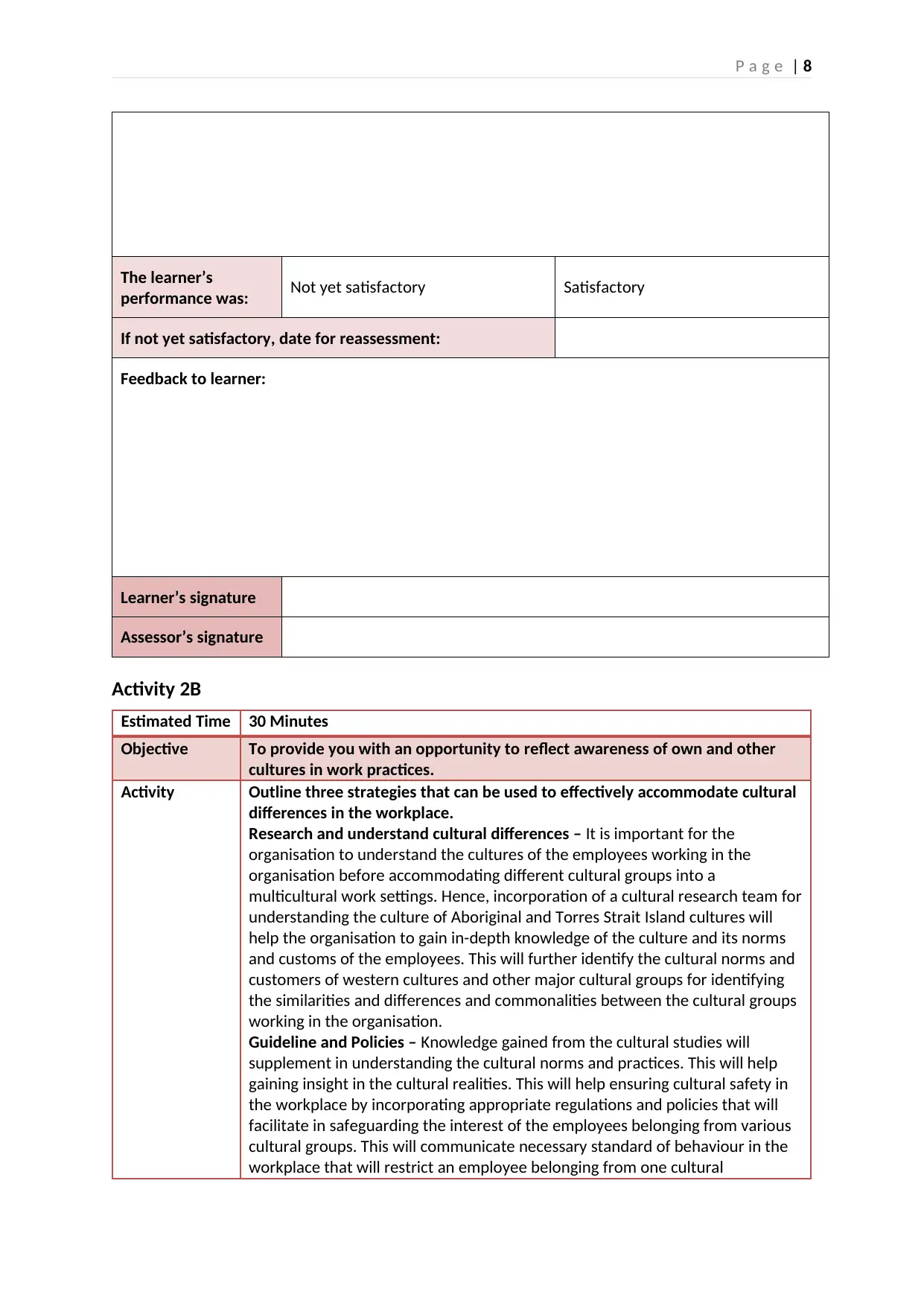
P a g e | 8
The learner’s
performance was: Not yet satisfactory Satisfactory
If not yet satisfactory, date for reassessment:
Feedback to learner:
Learner’s signature
Assessor’s signature
Activity 2B
Estimated Time 30 Minutes
Objective To provide you with an opportunity to reflect awareness of own and other
cultures in work practices.
Activity Outline three strategies that can be used to effectively accommodate cultural
differences in the workplace.
Research and understand cultural differences – It is important for the
organisation to understand the cultures of the employees working in the
organisation before accommodating different cultural groups into a
multicultural work settings. Hence, incorporation of a cultural research team for
understanding the culture of Aboriginal and Torres Strait Island cultures will
help the organisation to gain in-depth knowledge of the culture and its norms
and customs of the employees. This will further identify the cultural norms and
customers of western cultures and other major cultural groups for identifying
the similarities and differences and commonalities between the cultural groups
working in the organisation.
Guideline and Policies – Knowledge gained from the cultural studies will
supplement in understanding the cultural norms and practices. This will help
gaining insight in the cultural realities. This will help ensuring cultural safety in
the workplace by incorporating appropriate regulations and policies that will
facilitate in safeguarding the interest of the employees belonging from various
cultural groups. This will communicate necessary standard of behaviour in the
workplace that will restrict an employee belonging from one cultural
The learner’s
performance was: Not yet satisfactory Satisfactory
If not yet satisfactory, date for reassessment:
Feedback to learner:
Learner’s signature
Assessor’s signature
Activity 2B
Estimated Time 30 Minutes
Objective To provide you with an opportunity to reflect awareness of own and other
cultures in work practices.
Activity Outline three strategies that can be used to effectively accommodate cultural
differences in the workplace.
Research and understand cultural differences – It is important for the
organisation to understand the cultures of the employees working in the
organisation before accommodating different cultural groups into a
multicultural work settings. Hence, incorporation of a cultural research team for
understanding the culture of Aboriginal and Torres Strait Island cultures will
help the organisation to gain in-depth knowledge of the culture and its norms
and customs of the employees. This will further identify the cultural norms and
customers of western cultures and other major cultural groups for identifying
the similarities and differences and commonalities between the cultural groups
working in the organisation.
Guideline and Policies – Knowledge gained from the cultural studies will
supplement in understanding the cultural norms and practices. This will help
gaining insight in the cultural realities. This will help ensuring cultural safety in
the workplace by incorporating appropriate regulations and policies that will
facilitate in safeguarding the interest of the employees belonging from various
cultural groups. This will communicate necessary standard of behaviour in the
workplace that will restrict an employee belonging from one cultural
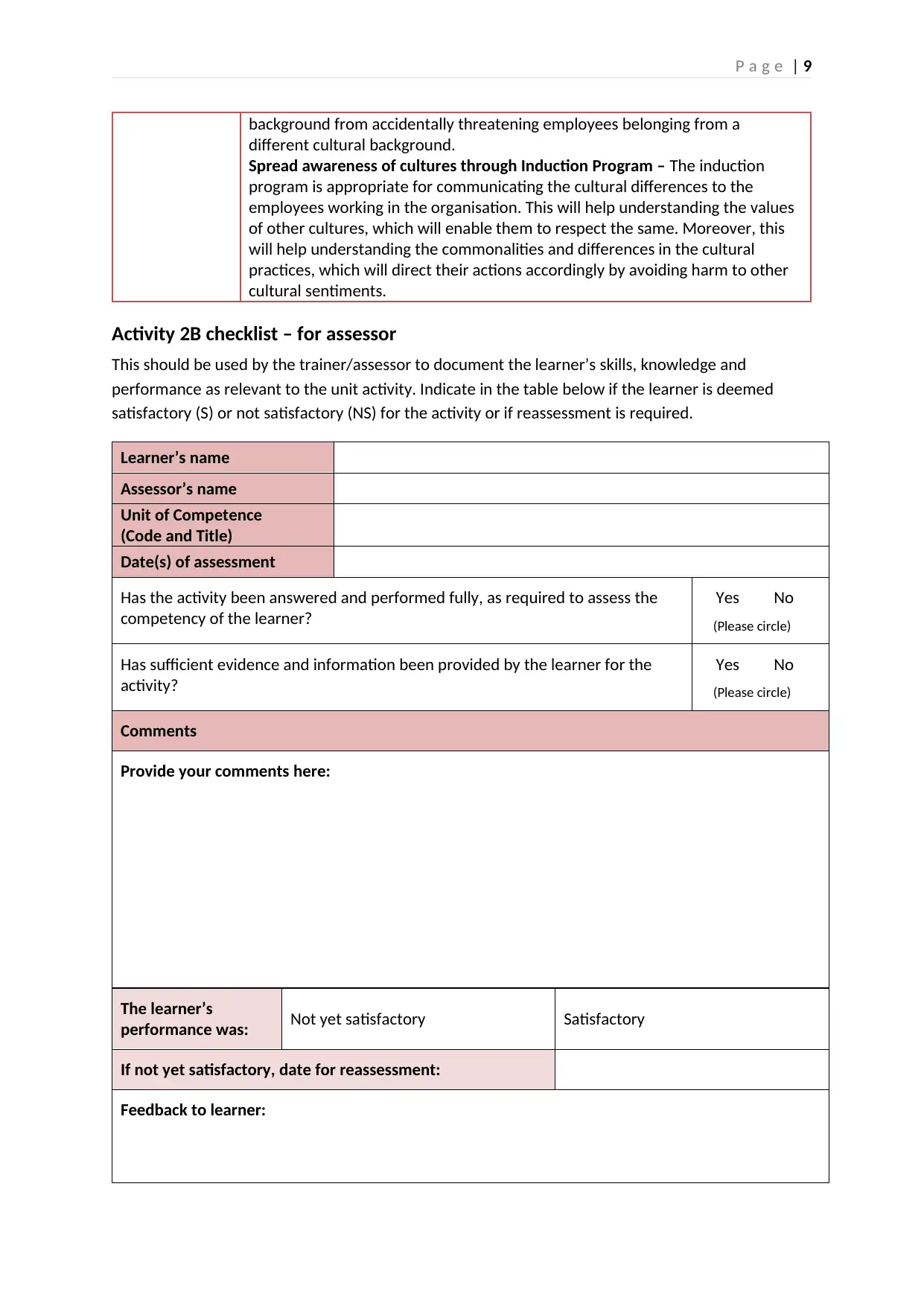
P a g e | 9
background from accidentally threatening employees belonging from a
different cultural background.
Spread awareness of cultures through Induction Program – The induction
program is appropriate for communicating the cultural differences to the
employees working in the organisation. This will help understanding the values
of other cultures, which will enable them to respect the same. Moreover, this
will help understanding the commonalities and differences in the cultural
practices, which will direct their actions accordingly by avoiding harm to other
cultural sentiments.
Activity 2B checklist – for assessor
This should be used by the trainer/assessor to document the learner’s skills, knowledge and
performance as relevant to the unit activity. Indicate in the table below if the learner is deemed
satisfactory (S) or not satisfactory (NS) for the activity or if reassessment is required.
Learner’s name
Assessor’s name
Unit of Competence
(Code and Title)
Date(s) of assessment
Has the activity been answered and performed fully, as required to assess the
competency of the learner?
Yes No
(Please circle)
Has sufficient evidence and information been provided by the learner for the
activity?
Yes No
(Please circle)
Comments
Provide your comments here:
The learner’s
performance was: Not yet satisfactory Satisfactory
If not yet satisfactory, date for reassessment:
Feedback to learner:
background from accidentally threatening employees belonging from a
different cultural background.
Spread awareness of cultures through Induction Program – The induction
program is appropriate for communicating the cultural differences to the
employees working in the organisation. This will help understanding the values
of other cultures, which will enable them to respect the same. Moreover, this
will help understanding the commonalities and differences in the cultural
practices, which will direct their actions accordingly by avoiding harm to other
cultural sentiments.
Activity 2B checklist – for assessor
This should be used by the trainer/assessor to document the learner’s skills, knowledge and
performance as relevant to the unit activity. Indicate in the table below if the learner is deemed
satisfactory (S) or not satisfactory (NS) for the activity or if reassessment is required.
Learner’s name
Assessor’s name
Unit of Competence
(Code and Title)
Date(s) of assessment
Has the activity been answered and performed fully, as required to assess the
competency of the learner?
Yes No
(Please circle)
Has sufficient evidence and information been provided by the learner for the
activity?
Yes No
(Please circle)
Comments
Provide your comments here:
The learner’s
performance was: Not yet satisfactory Satisfactory
If not yet satisfactory, date for reassessment:
Feedback to learner:
Secure Best Marks with AI Grader
Need help grading? Try our AI Grader for instant feedback on your assignments.
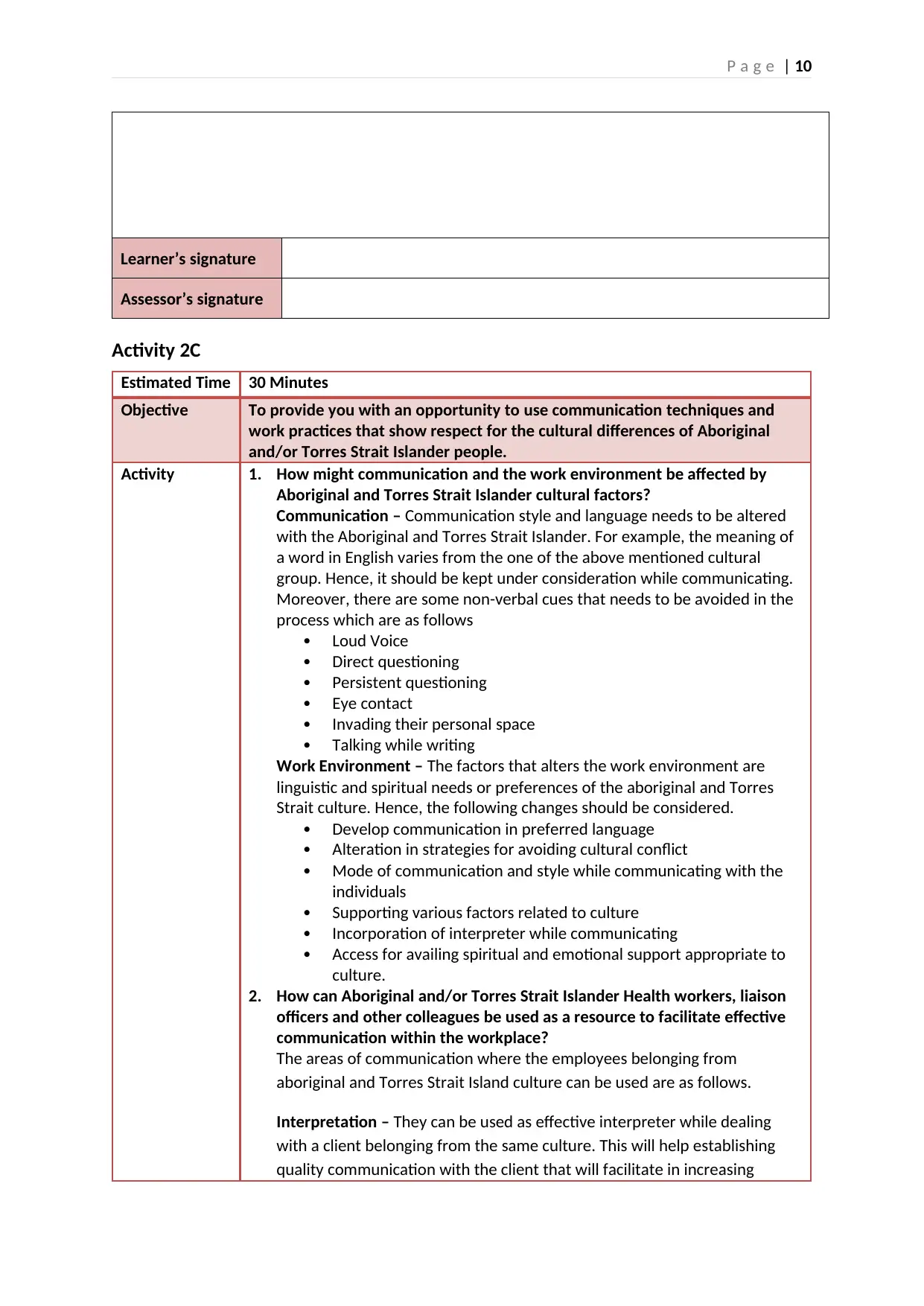
P a g e | 10
Learner’s signature
Assessor’s signature
Activity 2C
Estimated Time 30 Minutes
Objective To provide you with an opportunity to use communication techniques and
work practices that show respect for the cultural differences of Aboriginal
and/or Torres Strait Islander people.
Activity 1. How might communication and the work environment be affected by
Aboriginal and Torres Strait Islander cultural factors?
Communication – Communication style and language needs to be altered
with the Aboriginal and Torres Strait Islander. For example, the meaning of
a word in English varies from the one of the above mentioned cultural
group. Hence, it should be kept under consideration while communicating.
Moreover, there are some non-verbal cues that needs to be avoided in the
process which are as follows
Loud Voice
Direct questioning
Persistent questioning
Eye contact
Invading their personal space
Talking while writing
Work Environment – The factors that alters the work environment are
linguistic and spiritual needs or preferences of the aboriginal and Torres
Strait culture. Hence, the following changes should be considered.
Develop communication in preferred language
Alteration in strategies for avoiding cultural conflict
Mode of communication and style while communicating with the
individuals
Supporting various factors related to culture
Incorporation of interpreter while communicating
Access for availing spiritual and emotional support appropriate to
culture.
2. How can Aboriginal and/or Torres Strait Islander Health workers, liaison
officers and other colleagues be used as a resource to facilitate effective
communication within the workplace?
The areas of communication where the employees belonging from
aboriginal and Torres Strait Island culture can be used are as follows.
Interpretation – They can be used as effective interpreter while dealing
with a client belonging from the same culture. This will help establishing
quality communication with the client that will facilitate in increasing
Learner’s signature
Assessor’s signature
Activity 2C
Estimated Time 30 Minutes
Objective To provide you with an opportunity to use communication techniques and
work practices that show respect for the cultural differences of Aboriginal
and/or Torres Strait Islander people.
Activity 1. How might communication and the work environment be affected by
Aboriginal and Torres Strait Islander cultural factors?
Communication – Communication style and language needs to be altered
with the Aboriginal and Torres Strait Islander. For example, the meaning of
a word in English varies from the one of the above mentioned cultural
group. Hence, it should be kept under consideration while communicating.
Moreover, there are some non-verbal cues that needs to be avoided in the
process which are as follows
Loud Voice
Direct questioning
Persistent questioning
Eye contact
Invading their personal space
Talking while writing
Work Environment – The factors that alters the work environment are
linguistic and spiritual needs or preferences of the aboriginal and Torres
Strait culture. Hence, the following changes should be considered.
Develop communication in preferred language
Alteration in strategies for avoiding cultural conflict
Mode of communication and style while communicating with the
individuals
Supporting various factors related to culture
Incorporation of interpreter while communicating
Access for availing spiritual and emotional support appropriate to
culture.
2. How can Aboriginal and/or Torres Strait Islander Health workers, liaison
officers and other colleagues be used as a resource to facilitate effective
communication within the workplace?
The areas of communication where the employees belonging from
aboriginal and Torres Strait Island culture can be used are as follows.
Interpretation – They can be used as effective interpreter while dealing
with a client belonging from the same culture. This will help establishing
quality communication with the client that will facilitate in increasing

P a g e | 11
relationship with them
Local knowledge and Experience – The knowledge and experience from
the locality held by the particular set of employees can help exploring the
needs and remedies for the need of the population. This will help in
providing greater satisfaction to the customers.
Consultation and Feedback – They can be consulted in certain matter and
their feedbacks on the same will help making efficient decisions that will
increase the organizational communication system.
Activity 2C checklist – for assessor
This should be used by the trainer/assessor to document the learner’s skills, knowledge and
performance as relevant to the unit activity. Indicate in the table below if the learner is deemed
satisfactory (S) or not satisfactory (NS) for the activity or if reassessment is required.
Learner’s name
Assessor’s name
Unit of Competence
(Code and Title)
Date(s) of assessment
Has the activity been answered and performed fully, as required to assess the
competency of the learner?
Yes No
(Please circle)
Has sufficient evidence and information been provided by the learner for the
activity?
Yes No
(Please circle)
Comments
Provide your comments here:
The learner’s
performance was: Not yet satisfactory Satisfactory
If not yet satisfactory, date for reassessment:
Feedback to learner:
relationship with them
Local knowledge and Experience – The knowledge and experience from
the locality held by the particular set of employees can help exploring the
needs and remedies for the need of the population. This will help in
providing greater satisfaction to the customers.
Consultation and Feedback – They can be consulted in certain matter and
their feedbacks on the same will help making efficient decisions that will
increase the organizational communication system.
Activity 2C checklist – for assessor
This should be used by the trainer/assessor to document the learner’s skills, knowledge and
performance as relevant to the unit activity. Indicate in the table below if the learner is deemed
satisfactory (S) or not satisfactory (NS) for the activity or if reassessment is required.
Learner’s name
Assessor’s name
Unit of Competence
(Code and Title)
Date(s) of assessment
Has the activity been answered and performed fully, as required to assess the
competency of the learner?
Yes No
(Please circle)
Has sufficient evidence and information been provided by the learner for the
activity?
Yes No
(Please circle)
Comments
Provide your comments here:
The learner’s
performance was: Not yet satisfactory Satisfactory
If not yet satisfactory, date for reassessment:
Feedback to learner:

P a g e | 12
Learner’s signature
Assessor’s signature
Activity 2D
Estimated Time 40 Minutes
Objective To provide you with an opportunity to engage with Aboriginal and/or Torres
Strait Islander interpreters and colleagues as cultural brokers, according to
situation needs.
Activity 1. What is meant by the term "cultural broker"?
The term cultural broker refers to the individual bridges two different
cultures. This is closely related to the duty of an interpreter by largely
varies from it as the interpreter only works as a translator, which facilitates
in understanding the language of an alien culture and helps in
communicating without having knowledge over the language. Cultural
broker on the other hand works as a mediator and helps not only in
developing effective communication but also in reducing conflict as the
individual holds in-depth knowledge of both the cultures and helps solving
the issues.
2. Where can you find interpreter resources in Australia and what level
should they be?
A number of sources offers interpreters in Australia, depending on the purpose.
The Translating and Interpreting Service is provided by the nation to the
residents and citizens who find difficulties in speaking English. Business
organisations can find interpreters in various sources that includes –
Australian Institute of Interpreters and Translators Incorporated
Translating and Interpreting Service
National Accreditation Authority for Translators and Interpreters
However, the level of the interpreter needs to be verified before hiring as it
is expected from the business organisations to use Professional Interpreters
in their operations. However, it is possible to adjust the level depending on
the availability of the same. The second level of choice for the
incorporation is the Paraprofessional Interpreter.
3. How can you resolve difficulties, differences or misunderstandings using
the following strategies:
Negotiation of culturally appropriate guidelines
Culturally appropriate guideline aims to satisfy the need of cultural safety
by safeguarding the values of different culture. Employees are to abide by
the codes, which reduces the chances of generating issues by harming
other cultural values.
Learner’s signature
Assessor’s signature
Activity 2D
Estimated Time 40 Minutes
Objective To provide you with an opportunity to engage with Aboriginal and/or Torres
Strait Islander interpreters and colleagues as cultural brokers, according to
situation needs.
Activity 1. What is meant by the term "cultural broker"?
The term cultural broker refers to the individual bridges two different
cultures. This is closely related to the duty of an interpreter by largely
varies from it as the interpreter only works as a translator, which facilitates
in understanding the language of an alien culture and helps in
communicating without having knowledge over the language. Cultural
broker on the other hand works as a mediator and helps not only in
developing effective communication but also in reducing conflict as the
individual holds in-depth knowledge of both the cultures and helps solving
the issues.
2. Where can you find interpreter resources in Australia and what level
should they be?
A number of sources offers interpreters in Australia, depending on the purpose.
The Translating and Interpreting Service is provided by the nation to the
residents and citizens who find difficulties in speaking English. Business
organisations can find interpreters in various sources that includes –
Australian Institute of Interpreters and Translators Incorporated
Translating and Interpreting Service
National Accreditation Authority for Translators and Interpreters
However, the level of the interpreter needs to be verified before hiring as it
is expected from the business organisations to use Professional Interpreters
in their operations. However, it is possible to adjust the level depending on
the availability of the same. The second level of choice for the
incorporation is the Paraprofessional Interpreter.
3. How can you resolve difficulties, differences or misunderstandings using
the following strategies:
Negotiation of culturally appropriate guidelines
Culturally appropriate guideline aims to satisfy the need of cultural safety
by safeguarding the values of different culture. Employees are to abide by
the codes, which reduces the chances of generating issues by harming
other cultural values.
Paraphrase This Document
Need a fresh take? Get an instant paraphrase of this document with our AI Paraphraser
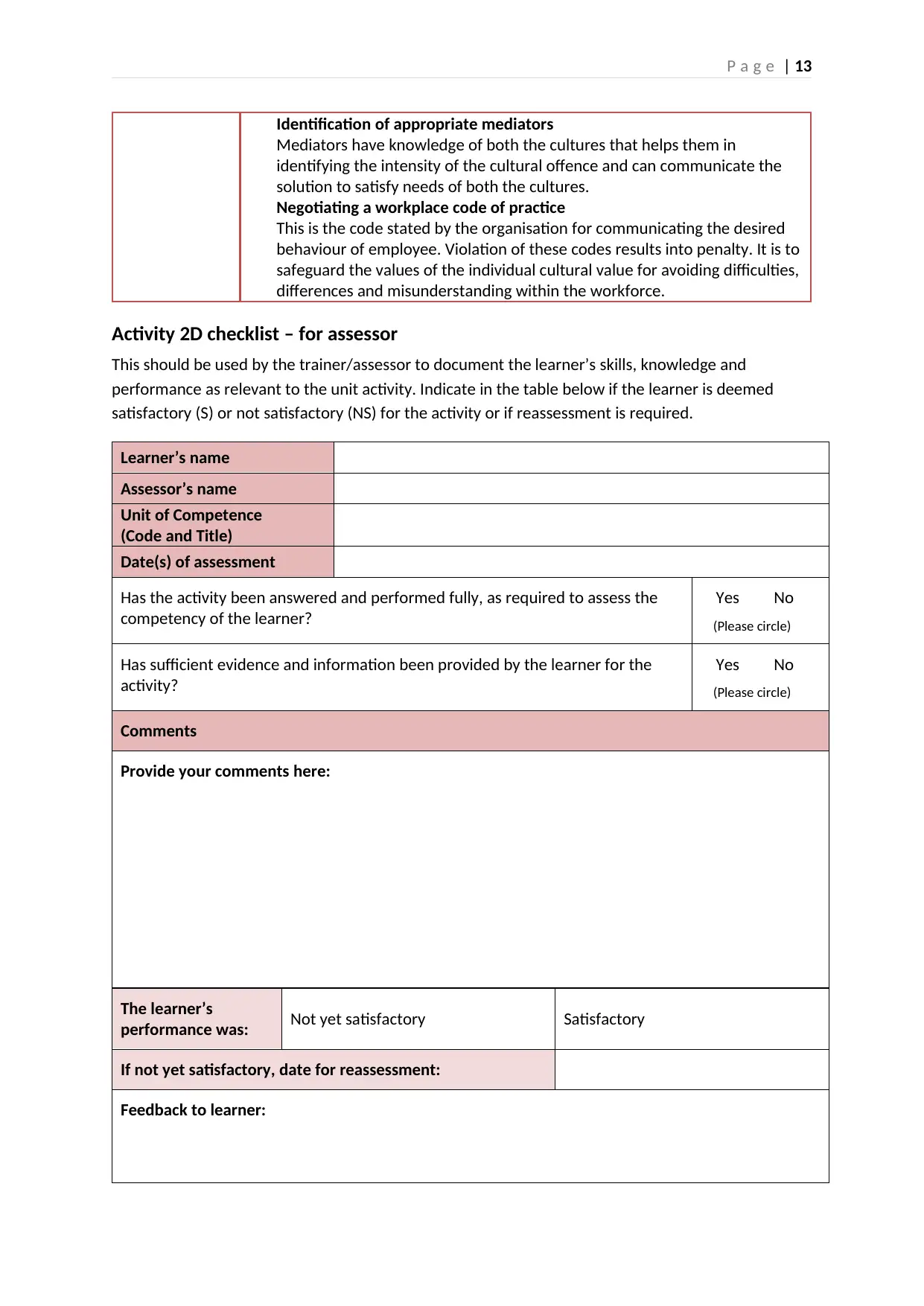
P a g e | 13
Identification of appropriate mediators
Mediators have knowledge of both the cultures that helps them in
identifying the intensity of the cultural offence and can communicate the
solution to satisfy needs of both the cultures.
Negotiating a workplace code of practice
This is the code stated by the organisation for communicating the desired
behaviour of employee. Violation of these codes results into penalty. It is to
safeguard the values of the individual cultural value for avoiding difficulties,
differences and misunderstanding within the workforce.
Activity 2D checklist – for assessor
This should be used by the trainer/assessor to document the learner’s skills, knowledge and
performance as relevant to the unit activity. Indicate in the table below if the learner is deemed
satisfactory (S) or not satisfactory (NS) for the activity or if reassessment is required.
Learner’s name
Assessor’s name
Unit of Competence
(Code and Title)
Date(s) of assessment
Has the activity been answered and performed fully, as required to assess the
competency of the learner?
Yes No
(Please circle)
Has sufficient evidence and information been provided by the learner for the
activity?
Yes No
(Please circle)
Comments
Provide your comments here:
The learner’s
performance was: Not yet satisfactory Satisfactory
If not yet satisfactory, date for reassessment:
Feedback to learner:
Identification of appropriate mediators
Mediators have knowledge of both the cultures that helps them in
identifying the intensity of the cultural offence and can communicate the
solution to satisfy needs of both the cultures.
Negotiating a workplace code of practice
This is the code stated by the organisation for communicating the desired
behaviour of employee. Violation of these codes results into penalty. It is to
safeguard the values of the individual cultural value for avoiding difficulties,
differences and misunderstanding within the workforce.
Activity 2D checklist – for assessor
This should be used by the trainer/assessor to document the learner’s skills, knowledge and
performance as relevant to the unit activity. Indicate in the table below if the learner is deemed
satisfactory (S) or not satisfactory (NS) for the activity or if reassessment is required.
Learner’s name
Assessor’s name
Unit of Competence
(Code and Title)
Date(s) of assessment
Has the activity been answered and performed fully, as required to assess the
competency of the learner?
Yes No
(Please circle)
Has sufficient evidence and information been provided by the learner for the
activity?
Yes No
(Please circle)
Comments
Provide your comments here:
The learner’s
performance was: Not yet satisfactory Satisfactory
If not yet satisfactory, date for reassessment:
Feedback to learner:

P a g e | 14
Learner’s signature
Assessor’s signature
Activity 3A
Estimated Time 90 Minutes
Objective To provide you with an opportunity to support the development of effective
partnerships between staff, Aboriginal and/or Torres Strait Islander people
and their communities.
Activity 1. Outline two of the resources you can use to facilitate effective service
delivery in a cross-cultural context.
A number of resources can be employed that can facilitate in effective
services delivery in a cross-cultural context. However, the most effective
ones are incorporation of people with appropriate cultural knowledge and
workplace policies.
People with appropriate cultural knowledge – These are the people who
have in-depth cultural knowledge and can facilitate in understanding the
customs and norms of the culture. Developing greater understanding of the
culture will allow the organisation to better manage the culturally diverse
workforce. These people can be individual from specific culture with
knowledge of their worldview, cultural experts with understanding of the
culture concerned and the interpreters with fluency in language of the
respective cultures. Incorporation of these resources in the organisation
will help understanding about the culture, which will again help in
organising the suitable workplace environment for accommodating the
employees belonging from aboriginal and Torres Strait culture. Moreover, it
will help communicating with bot the employees and clients of the
organisation, hence delivering greater value.
Workplace Policies – Incorporation of appropriate workplace policies
depending on the cultural knowledge gather will help in increasing cultural
safety for the aboriginal and Torres Strait Islanders and also the western
population. This will communicate behaviour expected from the employees
to respect other cultures for securing cultural realism. Moreover, this will
allow the indigenous population to work within the organisation without
compromising their cultural norms and customs, which will facilitate in
delivering effective service in the cross-cultural context. The policies can
include dress code in accordance with cultural background, ethical
behaviour, verbal and non-verbal behaviour, relationship development in
the cross-cultural workforce etc.
2. Outline three strategies for developing and maintaining effective
relationships with Aboriginal and/or Torres Strait Islander co-workers and
clients?
Development and monitoring practices providing cultural safety –
Learner’s signature
Assessor’s signature
Activity 3A
Estimated Time 90 Minutes
Objective To provide you with an opportunity to support the development of effective
partnerships between staff, Aboriginal and/or Torres Strait Islander people
and their communities.
Activity 1. Outline two of the resources you can use to facilitate effective service
delivery in a cross-cultural context.
A number of resources can be employed that can facilitate in effective
services delivery in a cross-cultural context. However, the most effective
ones are incorporation of people with appropriate cultural knowledge and
workplace policies.
People with appropriate cultural knowledge – These are the people who
have in-depth cultural knowledge and can facilitate in understanding the
customs and norms of the culture. Developing greater understanding of the
culture will allow the organisation to better manage the culturally diverse
workforce. These people can be individual from specific culture with
knowledge of their worldview, cultural experts with understanding of the
culture concerned and the interpreters with fluency in language of the
respective cultures. Incorporation of these resources in the organisation
will help understanding about the culture, which will again help in
organising the suitable workplace environment for accommodating the
employees belonging from aboriginal and Torres Strait culture. Moreover, it
will help communicating with bot the employees and clients of the
organisation, hence delivering greater value.
Workplace Policies – Incorporation of appropriate workplace policies
depending on the cultural knowledge gather will help in increasing cultural
safety for the aboriginal and Torres Strait Islanders and also the western
population. This will communicate behaviour expected from the employees
to respect other cultures for securing cultural realism. Moreover, this will
allow the indigenous population to work within the organisation without
compromising their cultural norms and customs, which will facilitate in
delivering effective service in the cross-cultural context. The policies can
include dress code in accordance with cultural background, ethical
behaviour, verbal and non-verbal behaviour, relationship development in
the cross-cultural workforce etc.
2. Outline three strategies for developing and maintaining effective
relationships with Aboriginal and/or Torres Strait Islander co-workers and
clients?
Development and monitoring practices providing cultural safety –
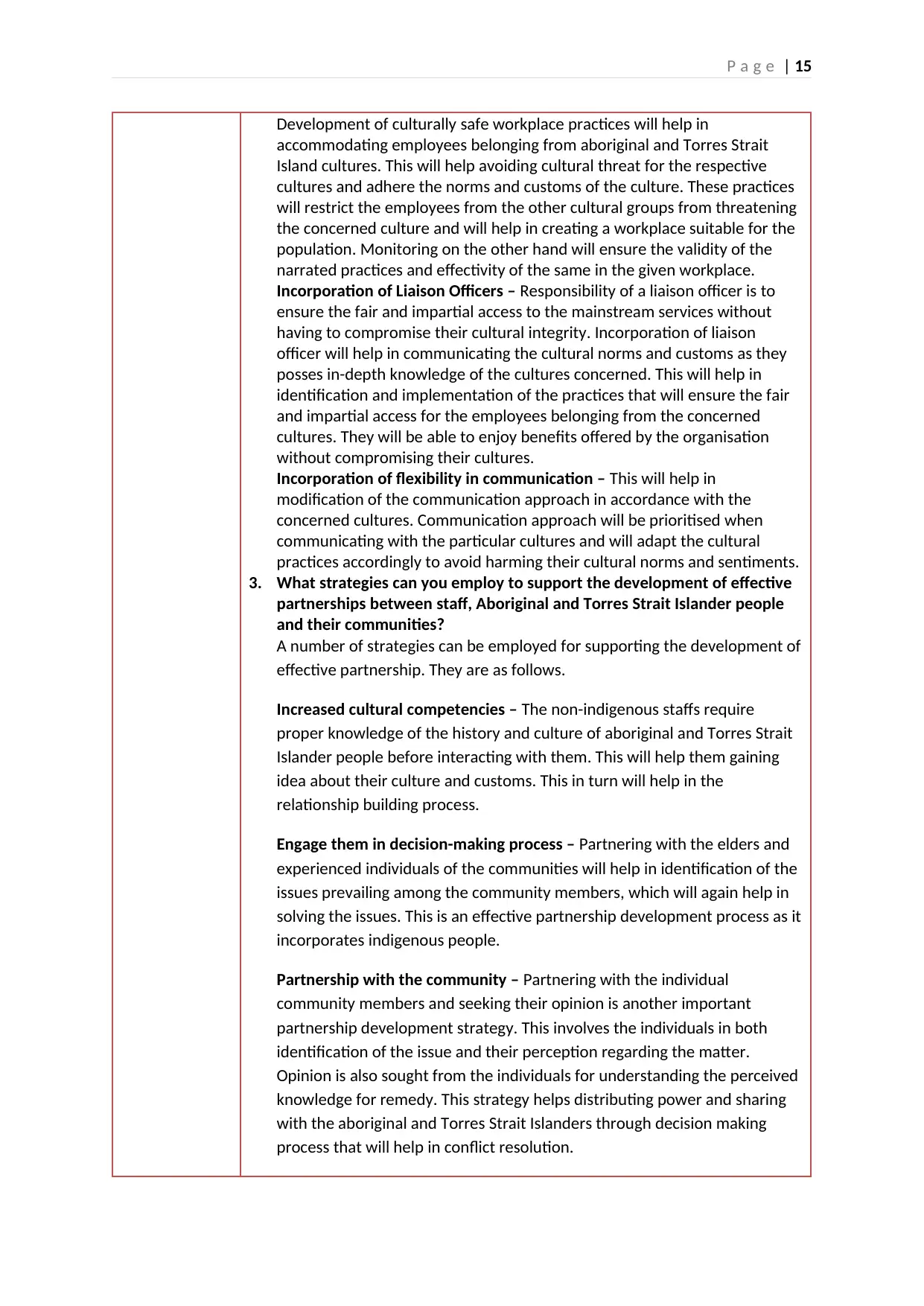
P a g e | 15
Development of culturally safe workplace practices will help in
accommodating employees belonging from aboriginal and Torres Strait
Island cultures. This will help avoiding cultural threat for the respective
cultures and adhere the norms and customs of the culture. These practices
will restrict the employees from the other cultural groups from threatening
the concerned culture and will help in creating a workplace suitable for the
population. Monitoring on the other hand will ensure the validity of the
narrated practices and effectivity of the same in the given workplace.
Incorporation of Liaison Officers – Responsibility of a liaison officer is to
ensure the fair and impartial access to the mainstream services without
having to compromise their cultural integrity. Incorporation of liaison
officer will help in communicating the cultural norms and customs as they
posses in-depth knowledge of the cultures concerned. This will help in
identification and implementation of the practices that will ensure the fair
and impartial access for the employees belonging from the concerned
cultures. They will be able to enjoy benefits offered by the organisation
without compromising their cultures.
Incorporation of flexibility in communication – This will help in
modification of the communication approach in accordance with the
concerned cultures. Communication approach will be prioritised when
communicating with the particular cultures and will adapt the cultural
practices accordingly to avoid harming their cultural norms and sentiments.
3. What strategies can you employ to support the development of effective
partnerships between staff, Aboriginal and Torres Strait Islander people
and their communities?
A number of strategies can be employed for supporting the development of
effective partnership. They are as follows.
Increased cultural competencies – The non-indigenous staffs require
proper knowledge of the history and culture of aboriginal and Torres Strait
Islander people before interacting with them. This will help them gaining
idea about their culture and customs. This in turn will help in the
relationship building process.
Engage them in decision-making process – Partnering with the elders and
experienced individuals of the communities will help in identification of the
issues prevailing among the community members, which will again help in
solving the issues. This is an effective partnership development process as it
incorporates indigenous people.
Partnership with the community – Partnering with the individual
community members and seeking their opinion is another important
partnership development strategy. This involves the individuals in both
identification of the issue and their perception regarding the matter.
Opinion is also sought from the individuals for understanding the perceived
knowledge for remedy. This strategy helps distributing power and sharing
with the aboriginal and Torres Strait Islanders through decision making
process that will help in conflict resolution.
Development of culturally safe workplace practices will help in
accommodating employees belonging from aboriginal and Torres Strait
Island cultures. This will help avoiding cultural threat for the respective
cultures and adhere the norms and customs of the culture. These practices
will restrict the employees from the other cultural groups from threatening
the concerned culture and will help in creating a workplace suitable for the
population. Monitoring on the other hand will ensure the validity of the
narrated practices and effectivity of the same in the given workplace.
Incorporation of Liaison Officers – Responsibility of a liaison officer is to
ensure the fair and impartial access to the mainstream services without
having to compromise their cultural integrity. Incorporation of liaison
officer will help in communicating the cultural norms and customs as they
posses in-depth knowledge of the cultures concerned. This will help in
identification and implementation of the practices that will ensure the fair
and impartial access for the employees belonging from the concerned
cultures. They will be able to enjoy benefits offered by the organisation
without compromising their cultures.
Incorporation of flexibility in communication – This will help in
modification of the communication approach in accordance with the
concerned cultures. Communication approach will be prioritised when
communicating with the particular cultures and will adapt the cultural
practices accordingly to avoid harming their cultural norms and sentiments.
3. What strategies can you employ to support the development of effective
partnerships between staff, Aboriginal and Torres Strait Islander people
and their communities?
A number of strategies can be employed for supporting the development of
effective partnership. They are as follows.
Increased cultural competencies – The non-indigenous staffs require
proper knowledge of the history and culture of aboriginal and Torres Strait
Islander people before interacting with them. This will help them gaining
idea about their culture and customs. This in turn will help in the
relationship building process.
Engage them in decision-making process – Partnering with the elders and
experienced individuals of the communities will help in identification of the
issues prevailing among the community members, which will again help in
solving the issues. This is an effective partnership development process as it
incorporates indigenous people.
Partnership with the community – Partnering with the individual
community members and seeking their opinion is another important
partnership development strategy. This involves the individuals in both
identification of the issue and their perception regarding the matter.
Opinion is also sought from the individuals for understanding the perceived
knowledge for remedy. This strategy helps distributing power and sharing
with the aboriginal and Torres Strait Islanders through decision making
process that will help in conflict resolution.
Secure Best Marks with AI Grader
Need help grading? Try our AI Grader for instant feedback on your assignments.

P a g e | 16
Activity 3A checklist – for assessor
This should be used by the trainer/assessor to document the learner’s skills, knowledge and
performance as relevant to the unit activity. Indicate in the table below if the learner is deemed
satisfactory (S) or not satisfactory (NS) for the activity or if reassessment is required.
Learner’s name
Assessor’s name
Unit of Competence
(Code and Title)
Date(s) of assessment
Has the activity been answered and performed fully, as required to assess the
competency of the learner?
Yes No
(Please circle)
Has sufficient evidence and information been provided by the learner for the
activity?
Yes No
(Please circle)
Comments
Provide your comments here:
The learner’s
performance was: Not yet satisfactory Satisfactory
If not yet satisfactory, date for reassessment:
Feedback to learner:
Learner’s signature
Assessor’s signature
Activity 3A checklist – for assessor
This should be used by the trainer/assessor to document the learner’s skills, knowledge and
performance as relevant to the unit activity. Indicate in the table below if the learner is deemed
satisfactory (S) or not satisfactory (NS) for the activity or if reassessment is required.
Learner’s name
Assessor’s name
Unit of Competence
(Code and Title)
Date(s) of assessment
Has the activity been answered and performed fully, as required to assess the
competency of the learner?
Yes No
(Please circle)
Has sufficient evidence and information been provided by the learner for the
activity?
Yes No
(Please circle)
Comments
Provide your comments here:
The learner’s
performance was: Not yet satisfactory Satisfactory
If not yet satisfactory, date for reassessment:
Feedback to learner:
Learner’s signature
Assessor’s signature
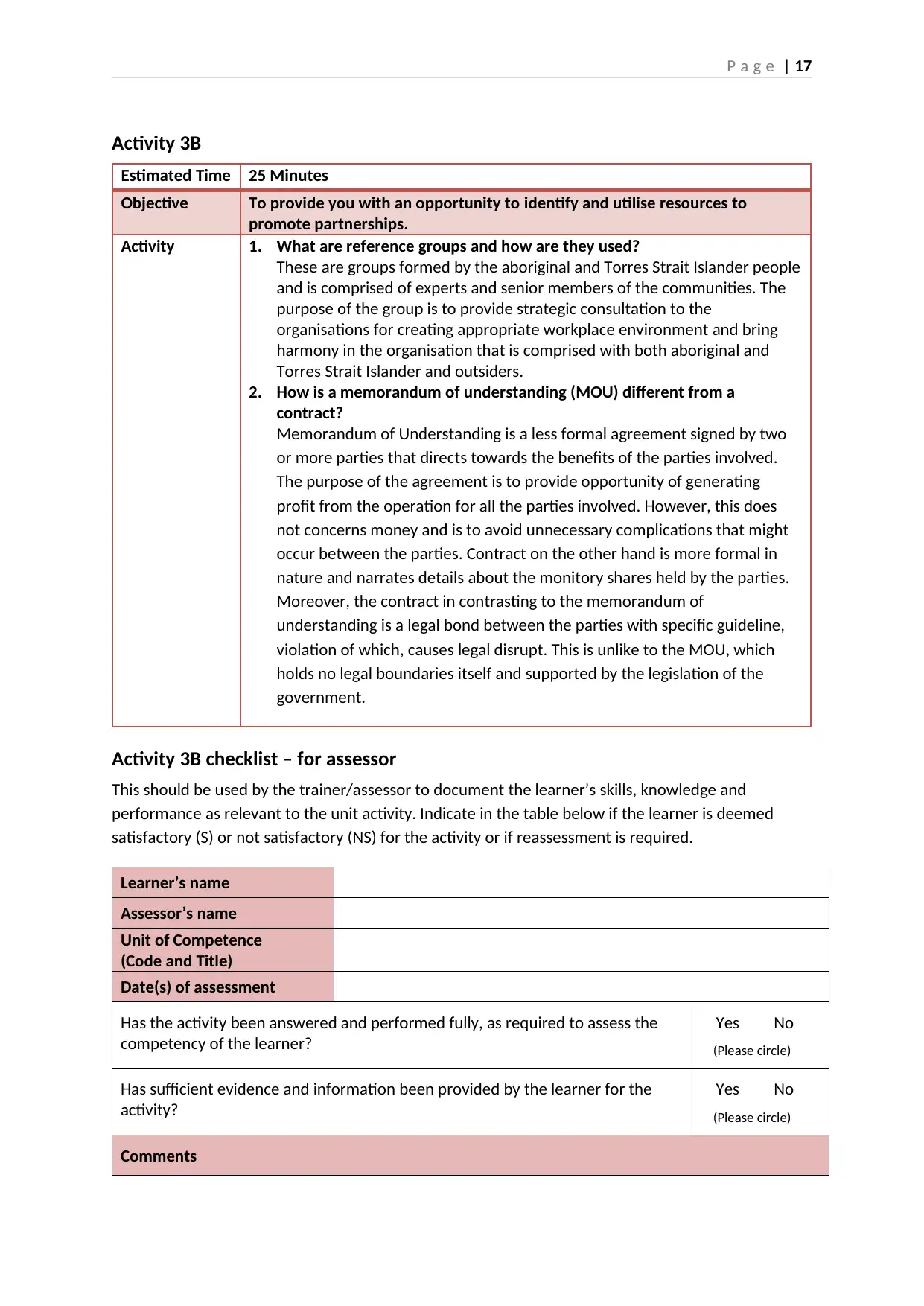
P a g e | 17
Activity 3B
Estimated Time 25 Minutes
Objective To provide you with an opportunity to identify and utilise resources to
promote partnerships.
Activity 1. What are reference groups and how are they used?
These are groups formed by the aboriginal and Torres Strait Islander people
and is comprised of experts and senior members of the communities. The
purpose of the group is to provide strategic consultation to the
organisations for creating appropriate workplace environment and bring
harmony in the organisation that is comprised with both aboriginal and
Torres Strait Islander and outsiders.
2. How is a memorandum of understanding (MOU) different from a
contract?
Memorandum of Understanding is a less formal agreement signed by two
or more parties that directs towards the benefits of the parties involved.
The purpose of the agreement is to provide opportunity of generating
profit from the operation for all the parties involved. However, this does
not concerns money and is to avoid unnecessary complications that might
occur between the parties. Contract on the other hand is more formal in
nature and narrates details about the monitory shares held by the parties.
Moreover, the contract in contrasting to the memorandum of
understanding is a legal bond between the parties with specific guideline,
violation of which, causes legal disrupt. This is unlike to the MOU, which
holds no legal boundaries itself and supported by the legislation of the
government.
Activity 3B checklist – for assessor
This should be used by the trainer/assessor to document the learner’s skills, knowledge and
performance as relevant to the unit activity. Indicate in the table below if the learner is deemed
satisfactory (S) or not satisfactory (NS) for the activity or if reassessment is required.
Learner’s name
Assessor’s name
Unit of Competence
(Code and Title)
Date(s) of assessment
Has the activity been answered and performed fully, as required to assess the
competency of the learner?
Yes No
(Please circle)
Has sufficient evidence and information been provided by the learner for the
activity?
Yes No
(Please circle)
Comments
Activity 3B
Estimated Time 25 Minutes
Objective To provide you with an opportunity to identify and utilise resources to
promote partnerships.
Activity 1. What are reference groups and how are they used?
These are groups formed by the aboriginal and Torres Strait Islander people
and is comprised of experts and senior members of the communities. The
purpose of the group is to provide strategic consultation to the
organisations for creating appropriate workplace environment and bring
harmony in the organisation that is comprised with both aboriginal and
Torres Strait Islander and outsiders.
2. How is a memorandum of understanding (MOU) different from a
contract?
Memorandum of Understanding is a less formal agreement signed by two
or more parties that directs towards the benefits of the parties involved.
The purpose of the agreement is to provide opportunity of generating
profit from the operation for all the parties involved. However, this does
not concerns money and is to avoid unnecessary complications that might
occur between the parties. Contract on the other hand is more formal in
nature and narrates details about the monitory shares held by the parties.
Moreover, the contract in contrasting to the memorandum of
understanding is a legal bond between the parties with specific guideline,
violation of which, causes legal disrupt. This is unlike to the MOU, which
holds no legal boundaries itself and supported by the legislation of the
government.
Activity 3B checklist – for assessor
This should be used by the trainer/assessor to document the learner’s skills, knowledge and
performance as relevant to the unit activity. Indicate in the table below if the learner is deemed
satisfactory (S) or not satisfactory (NS) for the activity or if reassessment is required.
Learner’s name
Assessor’s name
Unit of Competence
(Code and Title)
Date(s) of assessment
Has the activity been answered and performed fully, as required to assess the
competency of the learner?
Yes No
(Please circle)
Has sufficient evidence and information been provided by the learner for the
activity?
Yes No
(Please circle)
Comments
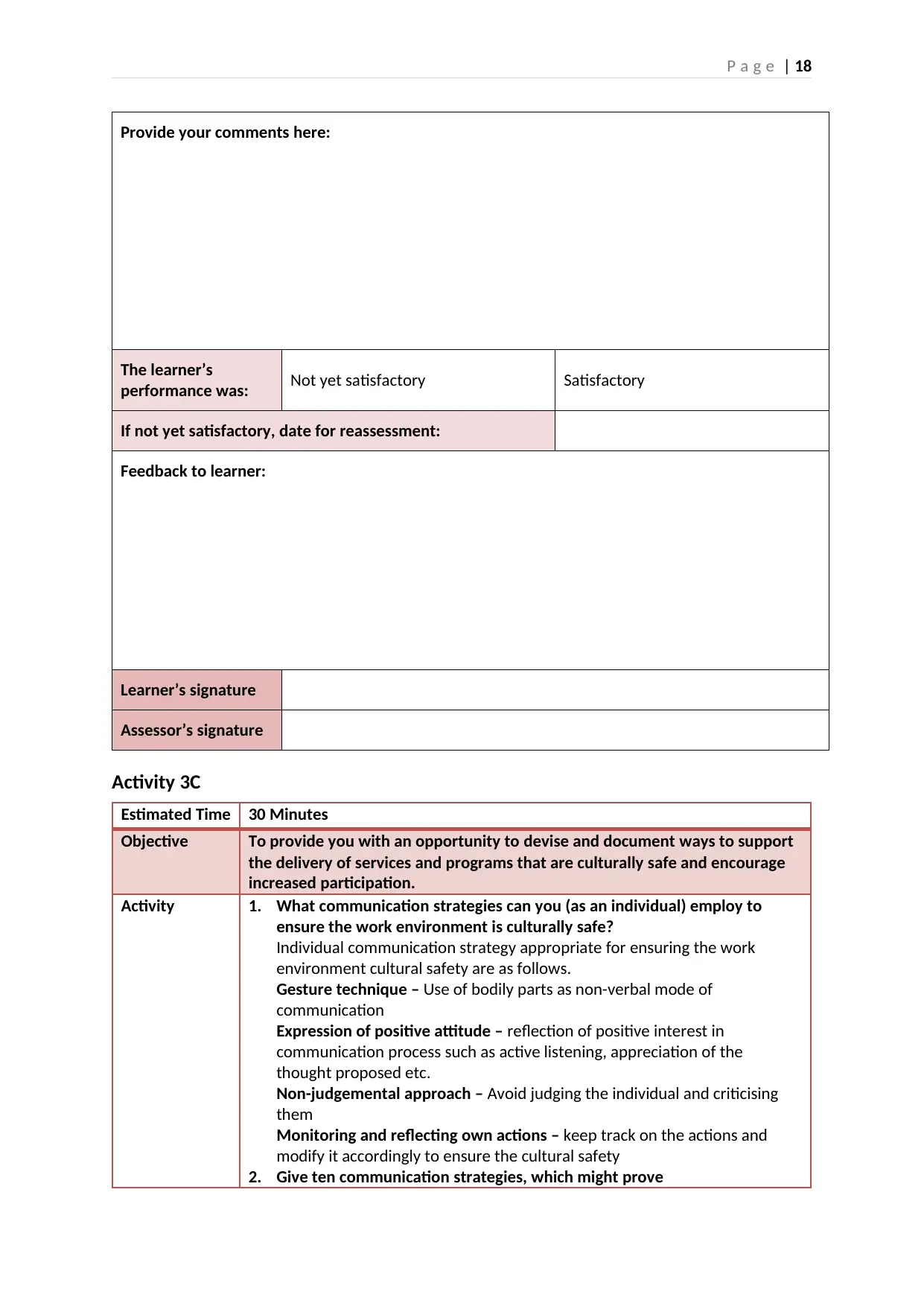
P a g e | 18
Provide your comments here:
The learner’s
performance was: Not yet satisfactory Satisfactory
If not yet satisfactory, date for reassessment:
Feedback to learner:
Learner’s signature
Assessor’s signature
Activity 3C
Estimated Time 30 Minutes
Objective To provide you with an opportunity to devise and document ways to support
the delivery of services and programs that are culturally safe and encourage
increased participation.
Activity 1. What communication strategies can you (as an individual) employ to
ensure the work environment is culturally safe?
Individual communication strategy appropriate for ensuring the work
environment cultural safety are as follows.
Gesture technique – Use of bodily parts as non-verbal mode of
communication
Expression of positive attitude – reflection of positive interest in
communication process such as active listening, appreciation of the
thought proposed etc.
Non-judgemental approach – Avoid judging the individual and criticising
them
Monitoring and reflecting own actions – keep track on the actions and
modify it accordingly to ensure the cultural safety
2. Give ten communication strategies, which might prove
Provide your comments here:
The learner’s
performance was: Not yet satisfactory Satisfactory
If not yet satisfactory, date for reassessment:
Feedback to learner:
Learner’s signature
Assessor’s signature
Activity 3C
Estimated Time 30 Minutes
Objective To provide you with an opportunity to devise and document ways to support
the delivery of services and programs that are culturally safe and encourage
increased participation.
Activity 1. What communication strategies can you (as an individual) employ to
ensure the work environment is culturally safe?
Individual communication strategy appropriate for ensuring the work
environment cultural safety are as follows.
Gesture technique – Use of bodily parts as non-verbal mode of
communication
Expression of positive attitude – reflection of positive interest in
communication process such as active listening, appreciation of the
thought proposed etc.
Non-judgemental approach – Avoid judging the individual and criticising
them
Monitoring and reflecting own actions – keep track on the actions and
modify it accordingly to ensure the cultural safety
2. Give ten communication strategies, which might prove
Paraphrase This Document
Need a fresh take? Get an instant paraphrase of this document with our AI Paraphraser
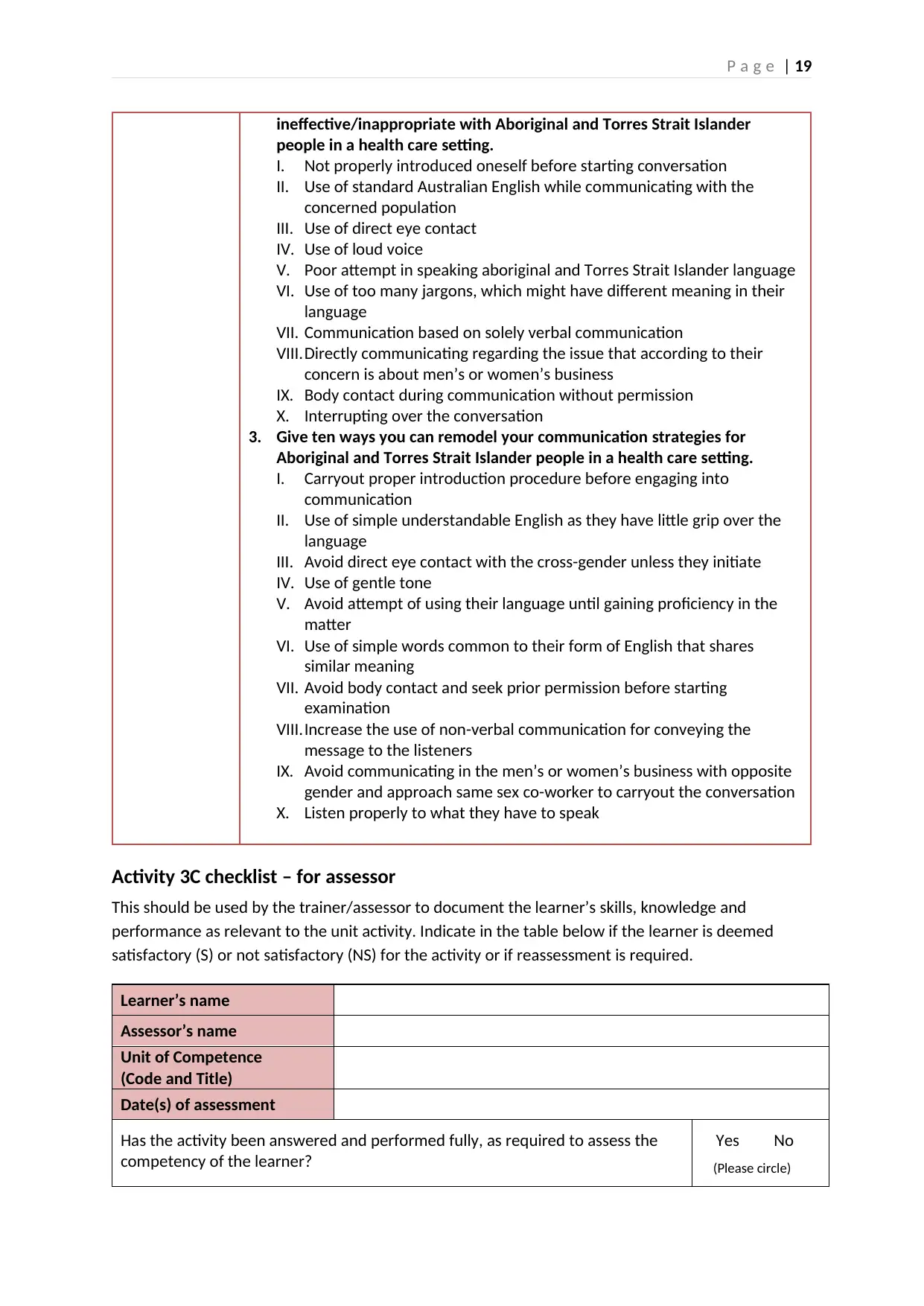
P a g e | 19
ineffective/inappropriate with Aboriginal and Torres Strait Islander
people in a health care setting.
I. Not properly introduced oneself before starting conversation
II. Use of standard Australian English while communicating with the
concerned population
III. Use of direct eye contact
IV. Use of loud voice
V. Poor attempt in speaking aboriginal and Torres Strait Islander language
VI. Use of too many jargons, which might have different meaning in their
language
VII. Communication based on solely verbal communication
VIII.Directly communicating regarding the issue that according to their
concern is about men’s or women’s business
IX. Body contact during communication without permission
X. Interrupting over the conversation
3. Give ten ways you can remodel your communication strategies for
Aboriginal and Torres Strait Islander people in a health care setting.
I. Carryout proper introduction procedure before engaging into
communication
II. Use of simple understandable English as they have little grip over the
language
III. Avoid direct eye contact with the cross-gender unless they initiate
IV. Use of gentle tone
V. Avoid attempt of using their language until gaining proficiency in the
matter
VI. Use of simple words common to their form of English that shares
similar meaning
VII. Avoid body contact and seek prior permission before starting
examination
VIII.Increase the use of non-verbal communication for conveying the
message to the listeners
IX. Avoid communicating in the men’s or women’s business with opposite
gender and approach same sex co-worker to carryout the conversation
X. Listen properly to what they have to speak
Activity 3C checklist – for assessor
This should be used by the trainer/assessor to document the learner’s skills, knowledge and
performance as relevant to the unit activity. Indicate in the table below if the learner is deemed
satisfactory (S) or not satisfactory (NS) for the activity or if reassessment is required.
Learner’s name
Assessor’s name
Unit of Competence
(Code and Title)
Date(s) of assessment
Has the activity been answered and performed fully, as required to assess the
competency of the learner?
Yes No
(Please circle)
ineffective/inappropriate with Aboriginal and Torres Strait Islander
people in a health care setting.
I. Not properly introduced oneself before starting conversation
II. Use of standard Australian English while communicating with the
concerned population
III. Use of direct eye contact
IV. Use of loud voice
V. Poor attempt in speaking aboriginal and Torres Strait Islander language
VI. Use of too many jargons, which might have different meaning in their
language
VII. Communication based on solely verbal communication
VIII.Directly communicating regarding the issue that according to their
concern is about men’s or women’s business
IX. Body contact during communication without permission
X. Interrupting over the conversation
3. Give ten ways you can remodel your communication strategies for
Aboriginal and Torres Strait Islander people in a health care setting.
I. Carryout proper introduction procedure before engaging into
communication
II. Use of simple understandable English as they have little grip over the
language
III. Avoid direct eye contact with the cross-gender unless they initiate
IV. Use of gentle tone
V. Avoid attempt of using their language until gaining proficiency in the
matter
VI. Use of simple words common to their form of English that shares
similar meaning
VII. Avoid body contact and seek prior permission before starting
examination
VIII.Increase the use of non-verbal communication for conveying the
message to the listeners
IX. Avoid communicating in the men’s or women’s business with opposite
gender and approach same sex co-worker to carryout the conversation
X. Listen properly to what they have to speak
Activity 3C checklist – for assessor
This should be used by the trainer/assessor to document the learner’s skills, knowledge and
performance as relevant to the unit activity. Indicate in the table below if the learner is deemed
satisfactory (S) or not satisfactory (NS) for the activity or if reassessment is required.
Learner’s name
Assessor’s name
Unit of Competence
(Code and Title)
Date(s) of assessment
Has the activity been answered and performed fully, as required to assess the
competency of the learner?
Yes No
(Please circle)
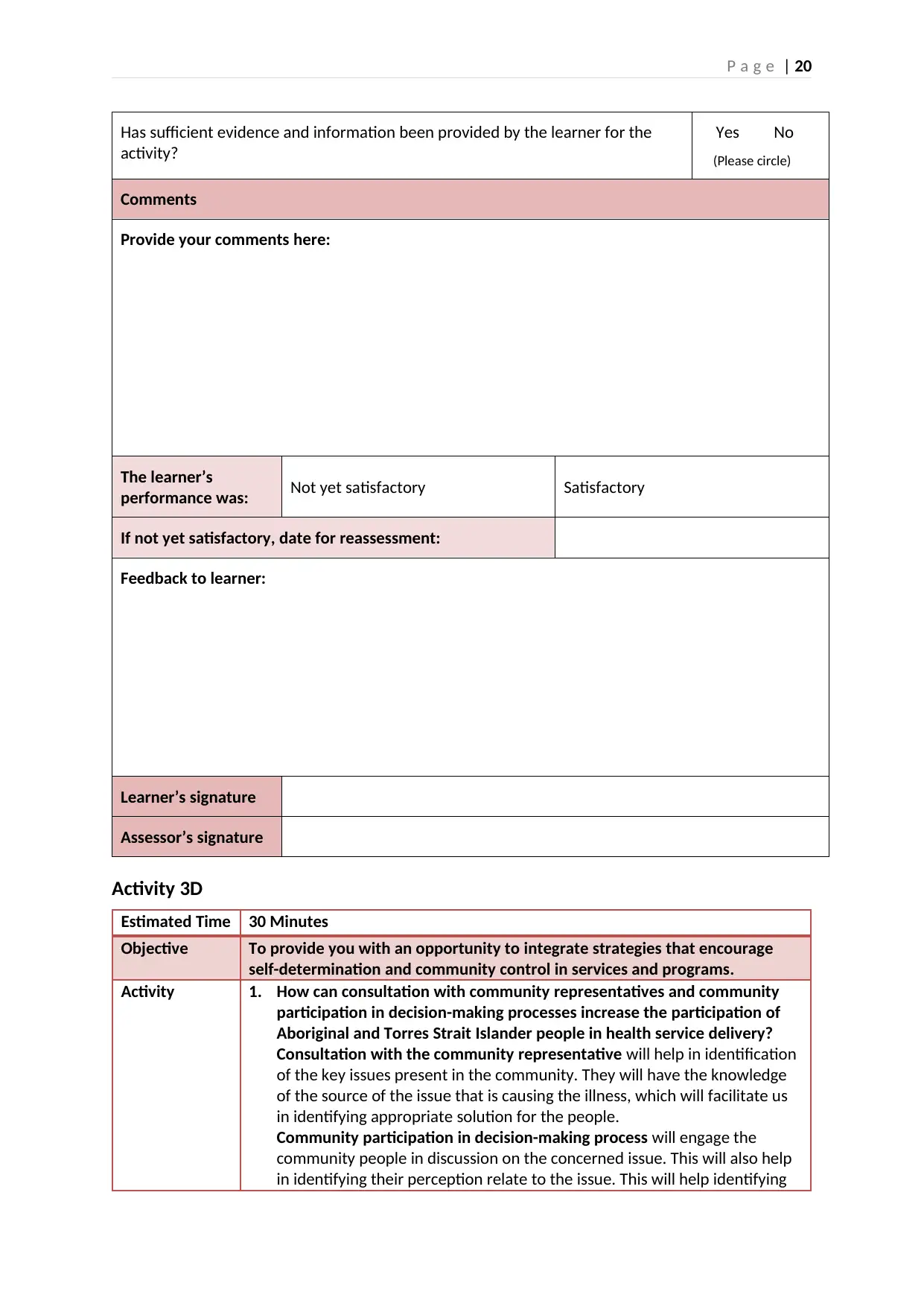
P a g e | 20
Has sufficient evidence and information been provided by the learner for the
activity?
Yes No
(Please circle)
Comments
Provide your comments here:
The learner’s
performance was: Not yet satisfactory Satisfactory
If not yet satisfactory, date for reassessment:
Feedback to learner:
Learner’s signature
Assessor’s signature
Activity 3D
Estimated Time 30 Minutes
Objective To provide you with an opportunity to integrate strategies that encourage
self-determination and community control in services and programs.
Activity 1. How can consultation with community representatives and community
participation in decision-making processes increase the participation of
Aboriginal and Torres Strait Islander people in health service delivery?
Consultation with the community representative will help in identification
of the key issues present in the community. They will have the knowledge
of the source of the issue that is causing the illness, which will facilitate us
in identifying appropriate solution for the people.
Community participation in decision-making process will engage the
community people in discussion on the concerned issue. This will also help
in identifying their perception relate to the issue. This will help identifying
Has sufficient evidence and information been provided by the learner for the
activity?
Yes No
(Please circle)
Comments
Provide your comments here:
The learner’s
performance was: Not yet satisfactory Satisfactory
If not yet satisfactory, date for reassessment:
Feedback to learner:
Learner’s signature
Assessor’s signature
Activity 3D
Estimated Time 30 Minutes
Objective To provide you with an opportunity to integrate strategies that encourage
self-determination and community control in services and programs.
Activity 1. How can consultation with community representatives and community
participation in decision-making processes increase the participation of
Aboriginal and Torres Strait Islander people in health service delivery?
Consultation with the community representative will help in identification
of the key issues present in the community. They will have the knowledge
of the source of the issue that is causing the illness, which will facilitate us
in identifying appropriate solution for the people.
Community participation in decision-making process will engage the
community people in discussion on the concerned issue. This will also help
in identifying their perception relate to the issue. This will help identifying
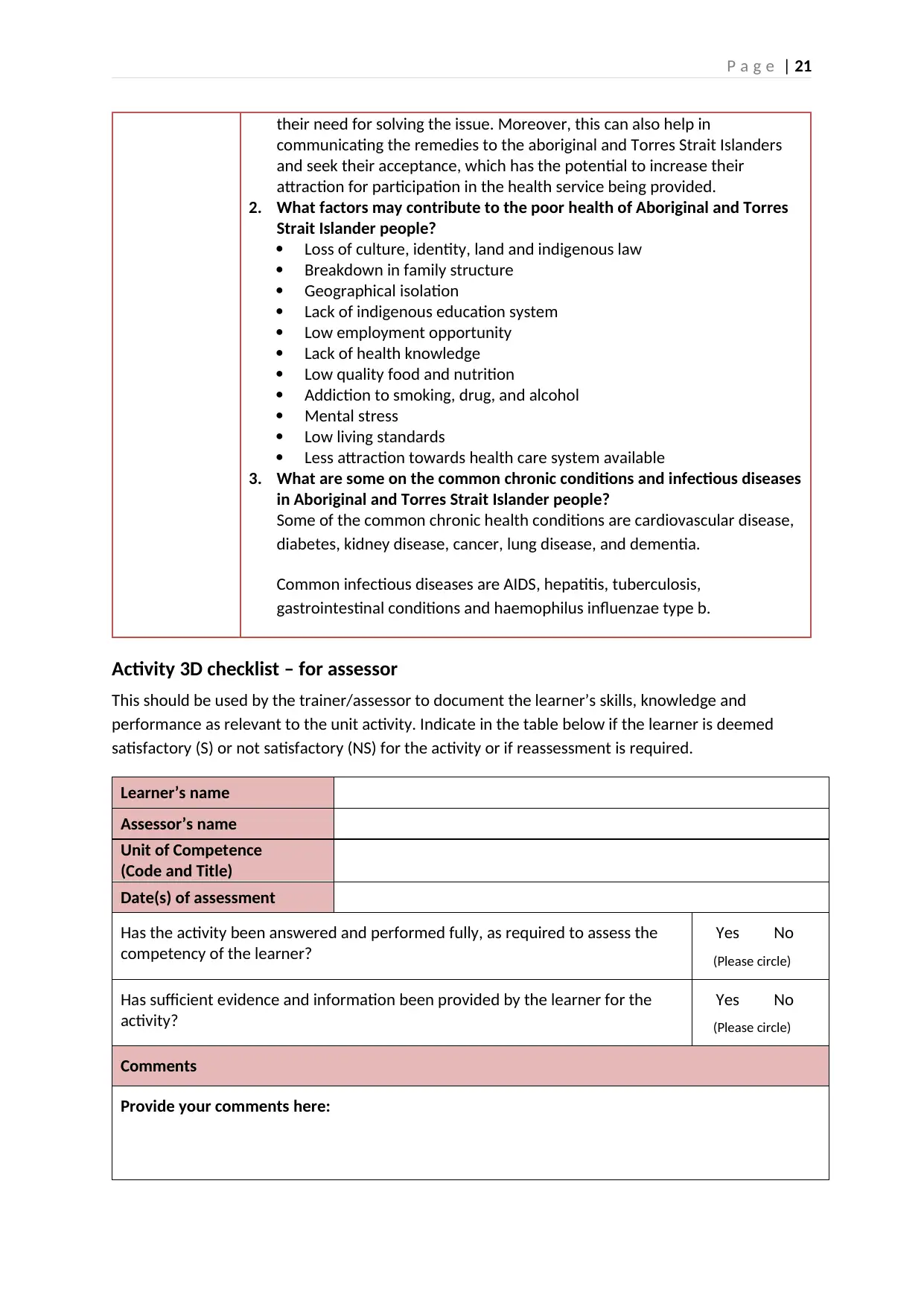
P a g e | 21
their need for solving the issue. Moreover, this can also help in
communicating the remedies to the aboriginal and Torres Strait Islanders
and seek their acceptance, which has the potential to increase their
attraction for participation in the health service being provided.
2. What factors may contribute to the poor health of Aboriginal and Torres
Strait Islander people?
Loss of culture, identity, land and indigenous law
Breakdown in family structure
Geographical isolation
Lack of indigenous education system
Low employment opportunity
Lack of health knowledge
Low quality food and nutrition
Addiction to smoking, drug, and alcohol
Mental stress
Low living standards
Less attraction towards health care system available
3. What are some on the common chronic conditions and infectious diseases
in Aboriginal and Torres Strait Islander people?
Some of the common chronic health conditions are cardiovascular disease,
diabetes, kidney disease, cancer, lung disease, and dementia.
Common infectious diseases are AIDS, hepatitis, tuberculosis,
gastrointestinal conditions and haemophilus influenzae type b.
Activity 3D checklist – for assessor
This should be used by the trainer/assessor to document the learner’s skills, knowledge and
performance as relevant to the unit activity. Indicate in the table below if the learner is deemed
satisfactory (S) or not satisfactory (NS) for the activity or if reassessment is required.
Learner’s name
Assessor’s name
Unit of Competence
(Code and Title)
Date(s) of assessment
Has the activity been answered and performed fully, as required to assess the
competency of the learner?
Yes No
(Please circle)
Has sufficient evidence and information been provided by the learner for the
activity?
Yes No
(Please circle)
Comments
Provide your comments here:
their need for solving the issue. Moreover, this can also help in
communicating the remedies to the aboriginal and Torres Strait Islanders
and seek their acceptance, which has the potential to increase their
attraction for participation in the health service being provided.
2. What factors may contribute to the poor health of Aboriginal and Torres
Strait Islander people?
Loss of culture, identity, land and indigenous law
Breakdown in family structure
Geographical isolation
Lack of indigenous education system
Low employment opportunity
Lack of health knowledge
Low quality food and nutrition
Addiction to smoking, drug, and alcohol
Mental stress
Low living standards
Less attraction towards health care system available
3. What are some on the common chronic conditions and infectious diseases
in Aboriginal and Torres Strait Islander people?
Some of the common chronic health conditions are cardiovascular disease,
diabetes, kidney disease, cancer, lung disease, and dementia.
Common infectious diseases are AIDS, hepatitis, tuberculosis,
gastrointestinal conditions and haemophilus influenzae type b.
Activity 3D checklist – for assessor
This should be used by the trainer/assessor to document the learner’s skills, knowledge and
performance as relevant to the unit activity. Indicate in the table below if the learner is deemed
satisfactory (S) or not satisfactory (NS) for the activity or if reassessment is required.
Learner’s name
Assessor’s name
Unit of Competence
(Code and Title)
Date(s) of assessment
Has the activity been answered and performed fully, as required to assess the
competency of the learner?
Yes No
(Please circle)
Has sufficient evidence and information been provided by the learner for the
activity?
Yes No
(Please circle)
Comments
Provide your comments here:
Secure Best Marks with AI Grader
Need help grading? Try our AI Grader for instant feedback on your assignments.
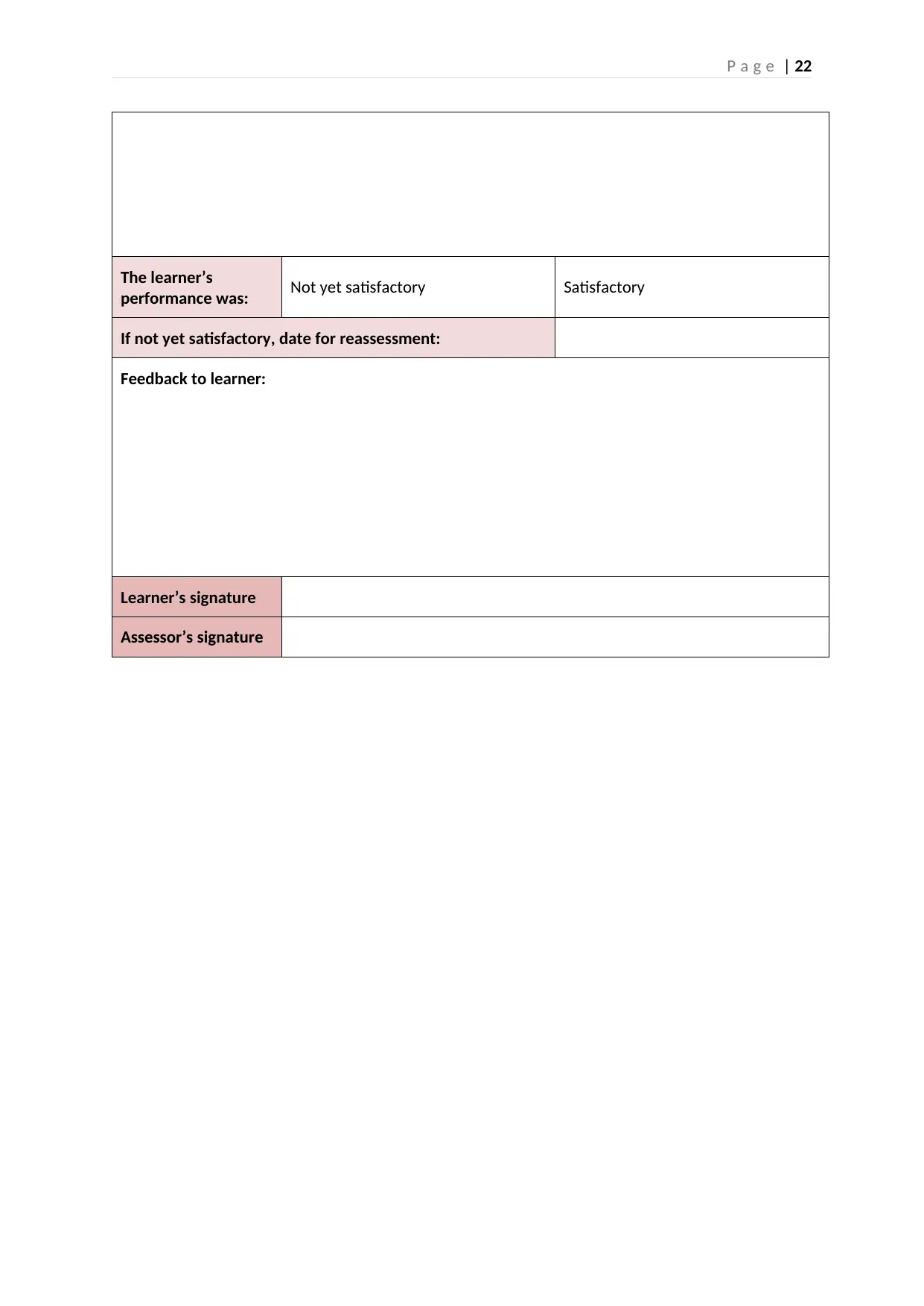
P a g e | 22
The learner’s
performance was: Not yet satisfactory Satisfactory
If not yet satisfactory, date for reassessment:
Feedback to learner:
Learner’s signature
Assessor’s signature
The learner’s
performance was: Not yet satisfactory Satisfactory
If not yet satisfactory, date for reassessment:
Feedback to learner:
Learner’s signature
Assessor’s signature
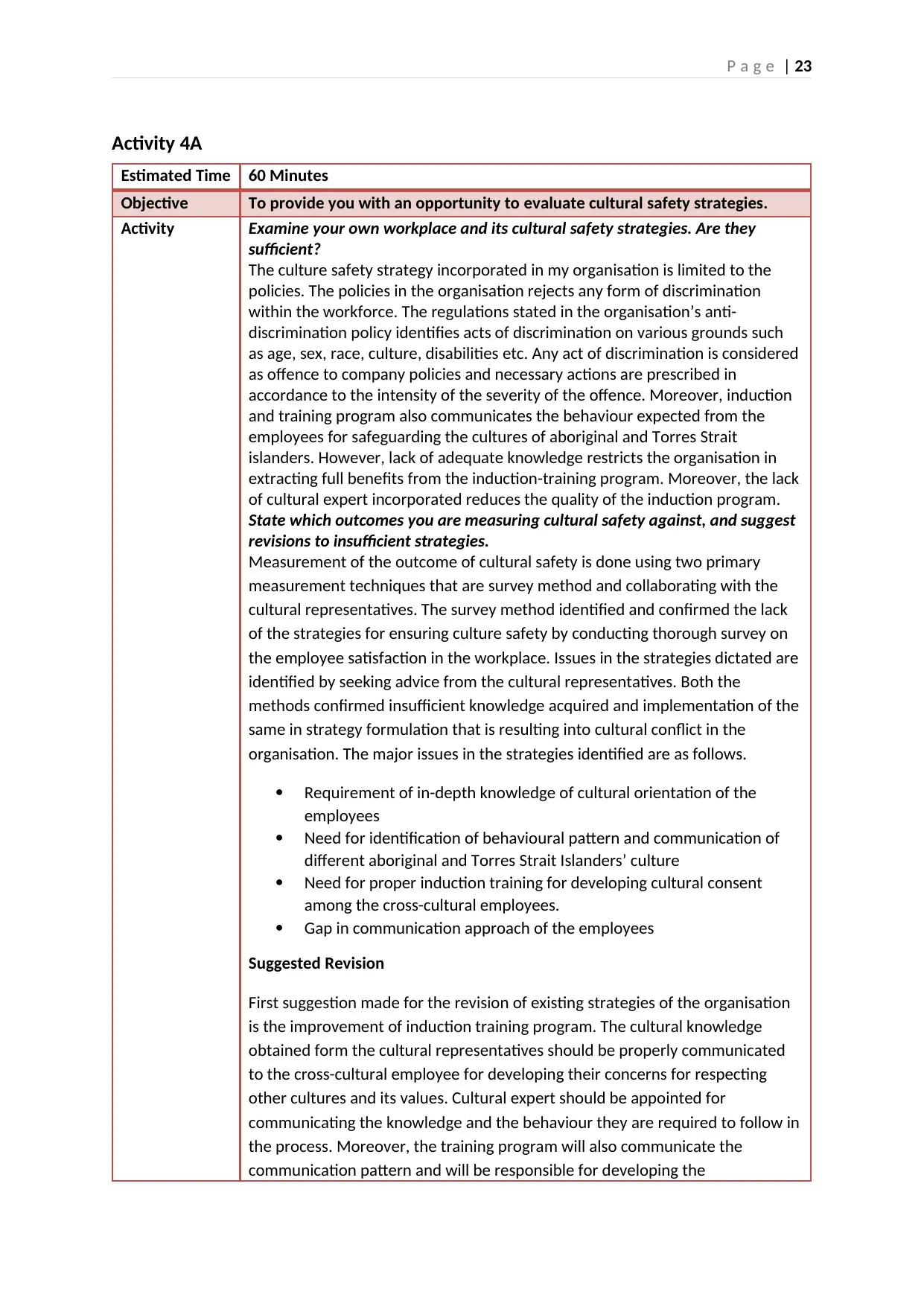
P a g e | 23
Activity 4A
Estimated Time 60 Minutes
Objective To provide you with an opportunity to evaluate cultural safety strategies.
Activity Examine your own workplace and its cultural safety strategies. Are they
sufficient?
The culture safety strategy incorporated in my organisation is limited to the
policies. The policies in the organisation rejects any form of discrimination
within the workforce. The regulations stated in the organisation’s anti-
discrimination policy identifies acts of discrimination on various grounds such
as age, sex, race, culture, disabilities etc. Any act of discrimination is considered
as offence to company policies and necessary actions are prescribed in
accordance to the intensity of the severity of the offence. Moreover, induction
and training program also communicates the behaviour expected from the
employees for safeguarding the cultures of aboriginal and Torres Strait
islanders. However, lack of adequate knowledge restricts the organisation in
extracting full benefits from the induction-training program. Moreover, the lack
of cultural expert incorporated reduces the quality of the induction program.
State which outcomes you are measuring cultural safety against, and suggest
revisions to insufficient strategies.
Measurement of the outcome of cultural safety is done using two primary
measurement techniques that are survey method and collaborating with the
cultural representatives. The survey method identified and confirmed the lack
of the strategies for ensuring culture safety by conducting thorough survey on
the employee satisfaction in the workplace. Issues in the strategies dictated are
identified by seeking advice from the cultural representatives. Both the
methods confirmed insufficient knowledge acquired and implementation of the
same in strategy formulation that is resulting into cultural conflict in the
organisation. The major issues in the strategies identified are as follows.
Requirement of in-depth knowledge of cultural orientation of the
employees
Need for identification of behavioural pattern and communication of
different aboriginal and Torres Strait Islanders’ culture
Need for proper induction training for developing cultural consent
among the cross-cultural employees.
Gap in communication approach of the employees
Suggested Revision
First suggestion made for the revision of existing strategies of the organisation
is the improvement of induction training program. The cultural knowledge
obtained form the cultural representatives should be properly communicated
to the cross-cultural employee for developing their concerns for respecting
other cultures and its values. Cultural expert should be appointed for
communicating the knowledge and the behaviour they are required to follow in
the process. Moreover, the training program will also communicate the
communication pattern and will be responsible for developing the
Activity 4A
Estimated Time 60 Minutes
Objective To provide you with an opportunity to evaluate cultural safety strategies.
Activity Examine your own workplace and its cultural safety strategies. Are they
sufficient?
The culture safety strategy incorporated in my organisation is limited to the
policies. The policies in the organisation rejects any form of discrimination
within the workforce. The regulations stated in the organisation’s anti-
discrimination policy identifies acts of discrimination on various grounds such
as age, sex, race, culture, disabilities etc. Any act of discrimination is considered
as offence to company policies and necessary actions are prescribed in
accordance to the intensity of the severity of the offence. Moreover, induction
and training program also communicates the behaviour expected from the
employees for safeguarding the cultures of aboriginal and Torres Strait
islanders. However, lack of adequate knowledge restricts the organisation in
extracting full benefits from the induction-training program. Moreover, the lack
of cultural expert incorporated reduces the quality of the induction program.
State which outcomes you are measuring cultural safety against, and suggest
revisions to insufficient strategies.
Measurement of the outcome of cultural safety is done using two primary
measurement techniques that are survey method and collaborating with the
cultural representatives. The survey method identified and confirmed the lack
of the strategies for ensuring culture safety by conducting thorough survey on
the employee satisfaction in the workplace. Issues in the strategies dictated are
identified by seeking advice from the cultural representatives. Both the
methods confirmed insufficient knowledge acquired and implementation of the
same in strategy formulation that is resulting into cultural conflict in the
organisation. The major issues in the strategies identified are as follows.
Requirement of in-depth knowledge of cultural orientation of the
employees
Need for identification of behavioural pattern and communication of
different aboriginal and Torres Strait Islanders’ culture
Need for proper induction training for developing cultural consent
among the cross-cultural employees.
Gap in communication approach of the employees
Suggested Revision
First suggestion made for the revision of existing strategies of the organisation
is the improvement of induction training program. The cultural knowledge
obtained form the cultural representatives should be properly communicated
to the cross-cultural employee for developing their concerns for respecting
other cultures and its values. Cultural expert should be appointed for
communicating the knowledge and the behaviour they are required to follow in
the process. Moreover, the training program will also communicate the
communication pattern and will be responsible for developing the
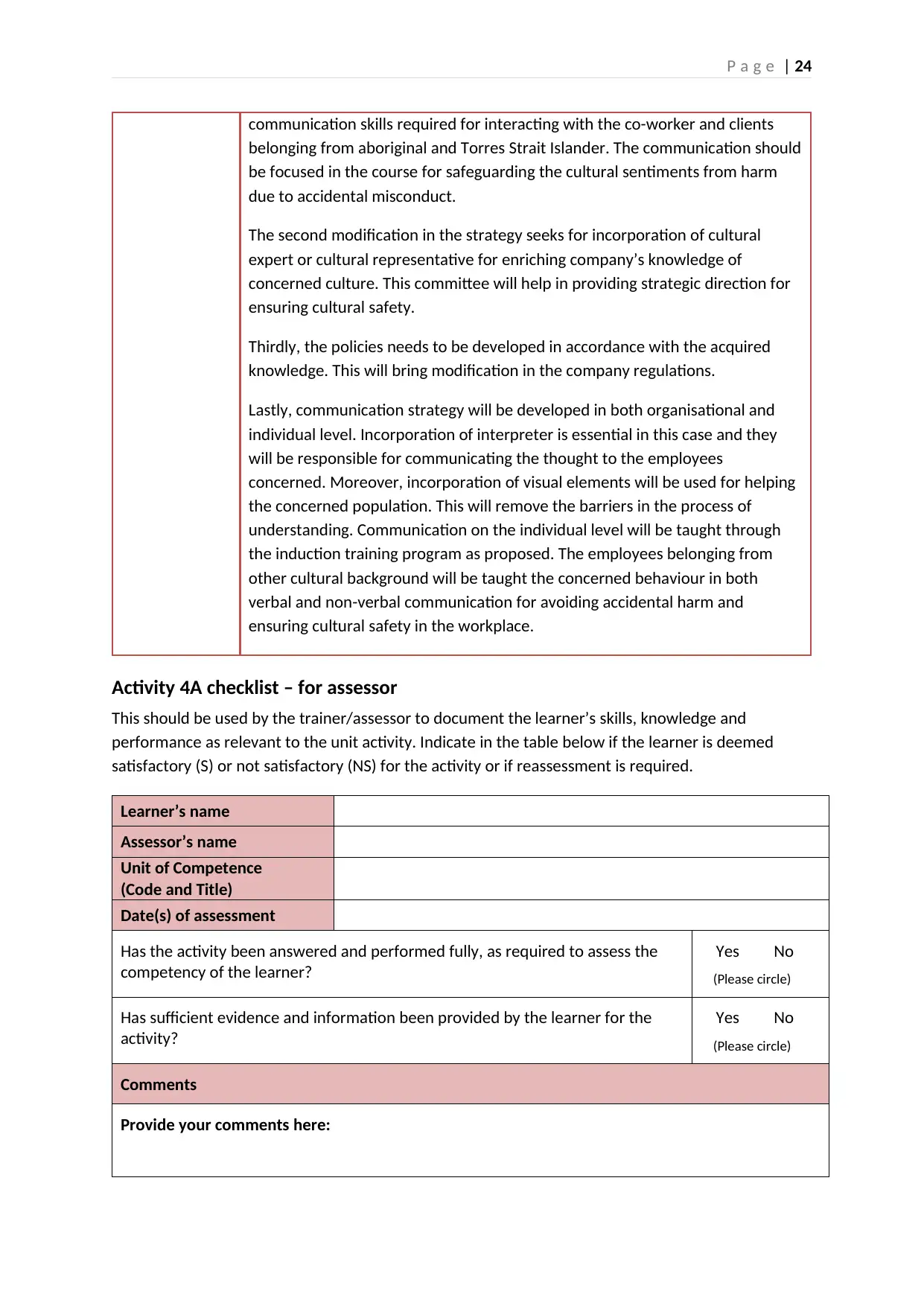
P a g e | 24
communication skills required for interacting with the co-worker and clients
belonging from aboriginal and Torres Strait Islander. The communication should
be focused in the course for safeguarding the cultural sentiments from harm
due to accidental misconduct.
The second modification in the strategy seeks for incorporation of cultural
expert or cultural representative for enriching company’s knowledge of
concerned culture. This committee will help in providing strategic direction for
ensuring cultural safety.
Thirdly, the policies needs to be developed in accordance with the acquired
knowledge. This will bring modification in the company regulations.
Lastly, communication strategy will be developed in both organisational and
individual level. Incorporation of interpreter is essential in this case and they
will be responsible for communicating the thought to the employees
concerned. Moreover, incorporation of visual elements will be used for helping
the concerned population. This will remove the barriers in the process of
understanding. Communication on the individual level will be taught through
the induction training program as proposed. The employees belonging from
other cultural background will be taught the concerned behaviour in both
verbal and non-verbal communication for avoiding accidental harm and
ensuring cultural safety in the workplace.
Activity 4A checklist – for assessor
This should be used by the trainer/assessor to document the learner’s skills, knowledge and
performance as relevant to the unit activity. Indicate in the table below if the learner is deemed
satisfactory (S) or not satisfactory (NS) for the activity or if reassessment is required.
Learner’s name
Assessor’s name
Unit of Competence
(Code and Title)
Date(s) of assessment
Has the activity been answered and performed fully, as required to assess the
competency of the learner?
Yes No
(Please circle)
Has sufficient evidence and information been provided by the learner for the
activity?
Yes No
(Please circle)
Comments
Provide your comments here:
communication skills required for interacting with the co-worker and clients
belonging from aboriginal and Torres Strait Islander. The communication should
be focused in the course for safeguarding the cultural sentiments from harm
due to accidental misconduct.
The second modification in the strategy seeks for incorporation of cultural
expert or cultural representative for enriching company’s knowledge of
concerned culture. This committee will help in providing strategic direction for
ensuring cultural safety.
Thirdly, the policies needs to be developed in accordance with the acquired
knowledge. This will bring modification in the company regulations.
Lastly, communication strategy will be developed in both organisational and
individual level. Incorporation of interpreter is essential in this case and they
will be responsible for communicating the thought to the employees
concerned. Moreover, incorporation of visual elements will be used for helping
the concerned population. This will remove the barriers in the process of
understanding. Communication on the individual level will be taught through
the induction training program as proposed. The employees belonging from
other cultural background will be taught the concerned behaviour in both
verbal and non-verbal communication for avoiding accidental harm and
ensuring cultural safety in the workplace.
Activity 4A checklist – for assessor
This should be used by the trainer/assessor to document the learner’s skills, knowledge and
performance as relevant to the unit activity. Indicate in the table below if the learner is deemed
satisfactory (S) or not satisfactory (NS) for the activity or if reassessment is required.
Learner’s name
Assessor’s name
Unit of Competence
(Code and Title)
Date(s) of assessment
Has the activity been answered and performed fully, as required to assess the
competency of the learner?
Yes No
(Please circle)
Has sufficient evidence and information been provided by the learner for the
activity?
Yes No
(Please circle)
Comments
Provide your comments here:
Paraphrase This Document
Need a fresh take? Get an instant paraphrase of this document with our AI Paraphraser
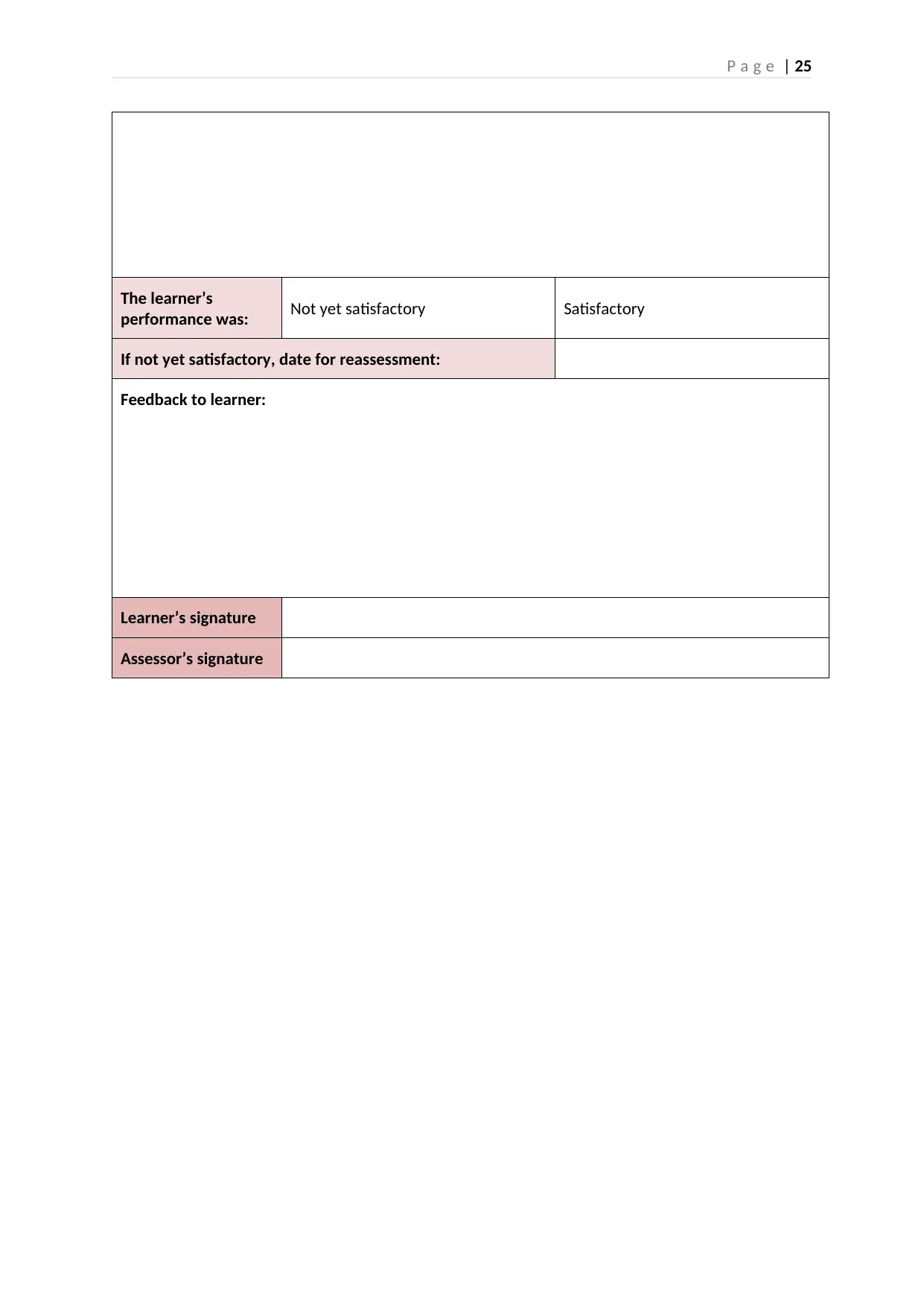
P a g e | 25
The learner’s
performance was: Not yet satisfactory Satisfactory
If not yet satisfactory, date for reassessment:
Feedback to learner:
Learner’s signature
Assessor’s signature
The learner’s
performance was: Not yet satisfactory Satisfactory
If not yet satisfactory, date for reassessment:
Feedback to learner:
Learner’s signature
Assessor’s signature

P a g e | 26
Summative Assessments
The summative assessments are the major activities designed to assess your skills, knowledge and
performance, as required to show competency in this unit. These activities should be completed
after finishing the Learner Guide. You should complete these as stated below and as instructed by
your trainer/assessor.
Skills, knowledge and performance may be termed as:
Skills – skill requirements, required skills, essential skills, foundation skills
Knowledge – knowledge requirements, required knowledge, essential knowledge,
knowledge evidence
Performance – evidence requirements, critical aspects of assessment, performance
evidence.
Section A: Skills Activity
The Skills Activity is designed to be a series of demonstrative tasks that should be assessed by
observation (by the assessor or third party, depending on the circumstances).
It will demonstrate all of the skills required for this unit of competency – your assessor will provide
further instructions to you, if necessary.
Section B: Knowledge Activity (Q & A)
The Knowledge Activity is designed to be a verbal questionnaire where the assessor asks you a series
of questions to confirm your competency for all of the required knowledge in the unit of
competency.
Section C: Performance Activity
The Performance Activity is designed to be a practical activity performed either in the workplace or a
simulated environment. You should demonstrate the required practical tasks for the unit of
competency and be observed by the assessor and/or third party, as applicable to the situation. If the
third party is required to observe you, you will need to make the required arrangements with them.
If necessary for the activities, you should attached completed written answers, portfolios or any
evidence of competency to this workbook.
Summative Assessments
The summative assessments are the major activities designed to assess your skills, knowledge and
performance, as required to show competency in this unit. These activities should be completed
after finishing the Learner Guide. You should complete these as stated below and as instructed by
your trainer/assessor.
Skills, knowledge and performance may be termed as:
Skills – skill requirements, required skills, essential skills, foundation skills
Knowledge – knowledge requirements, required knowledge, essential knowledge,
knowledge evidence
Performance – evidence requirements, critical aspects of assessment, performance
evidence.
Section A: Skills Activity
The Skills Activity is designed to be a series of demonstrative tasks that should be assessed by
observation (by the assessor or third party, depending on the circumstances).
It will demonstrate all of the skills required for this unit of competency – your assessor will provide
further instructions to you, if necessary.
Section B: Knowledge Activity (Q & A)
The Knowledge Activity is designed to be a verbal questionnaire where the assessor asks you a series
of questions to confirm your competency for all of the required knowledge in the unit of
competency.
Section C: Performance Activity
The Performance Activity is designed to be a practical activity performed either in the workplace or a
simulated environment. You should demonstrate the required practical tasks for the unit of
competency and be observed by the assessor and/or third party, as applicable to the situation. If the
third party is required to observe you, you will need to make the required arrangements with them.
If necessary for the activities, you should attached completed written answers, portfolios or any
evidence of competency to this workbook.
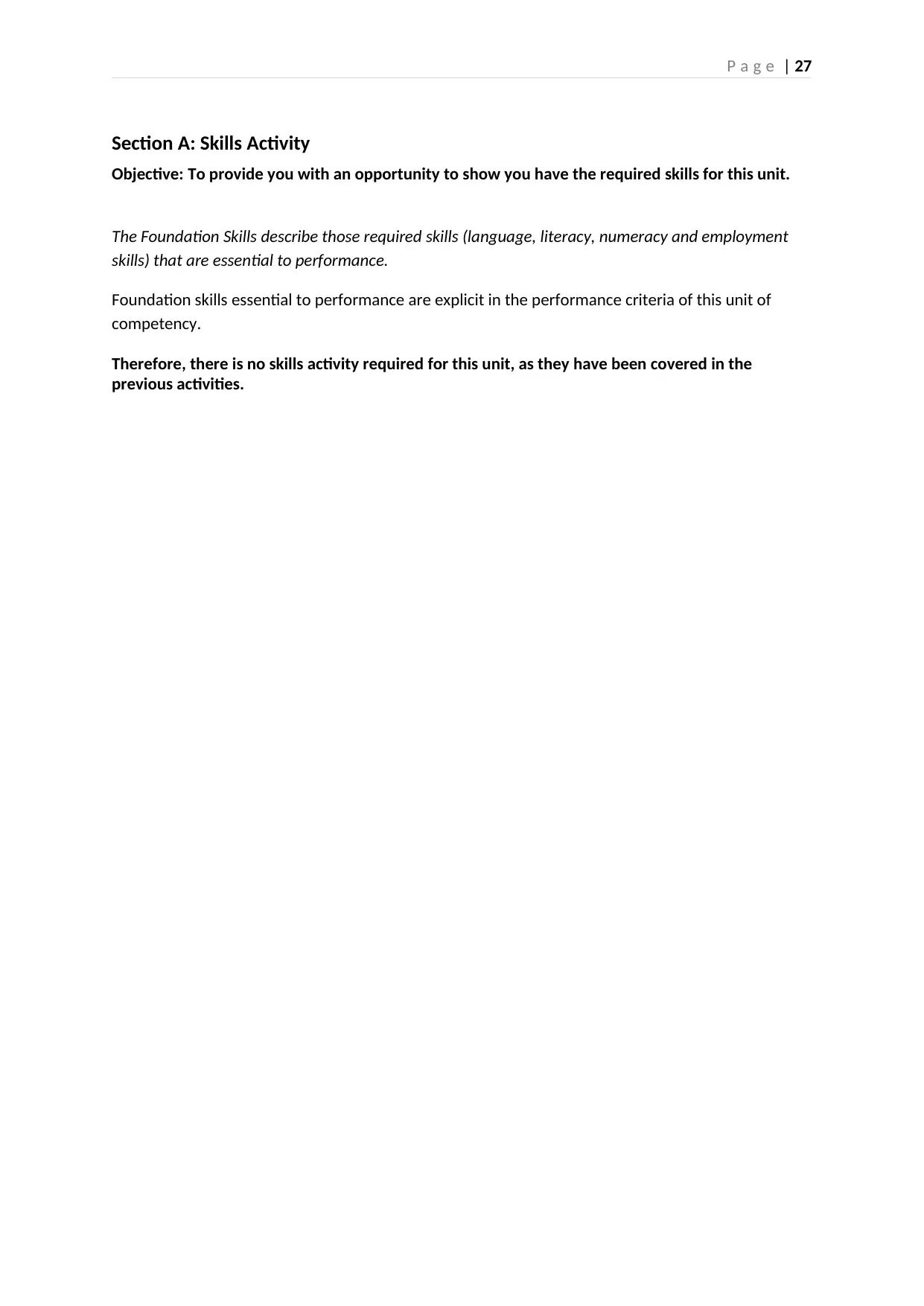
P a g e | 27
Section A: Skills Activity
Objective: To provide you with an opportunity to show you have the required skills for this unit.
The Foundation Skills describe those required skills (language, literacy, numeracy and employment
skills) that are essential to performance.
Foundation skills essential to performance are explicit in the performance criteria of this unit of
competency.
Therefore, there is no skills activity required for this unit, as they have been covered in the
previous activities.
Section A: Skills Activity
Objective: To provide you with an opportunity to show you have the required skills for this unit.
The Foundation Skills describe those required skills (language, literacy, numeracy and employment
skills) that are essential to performance.
Foundation skills essential to performance are explicit in the performance criteria of this unit of
competency.
Therefore, there is no skills activity required for this unit, as they have been covered in the
previous activities.
Secure Best Marks with AI Grader
Need help grading? Try our AI Grader for instant feedback on your assignments.
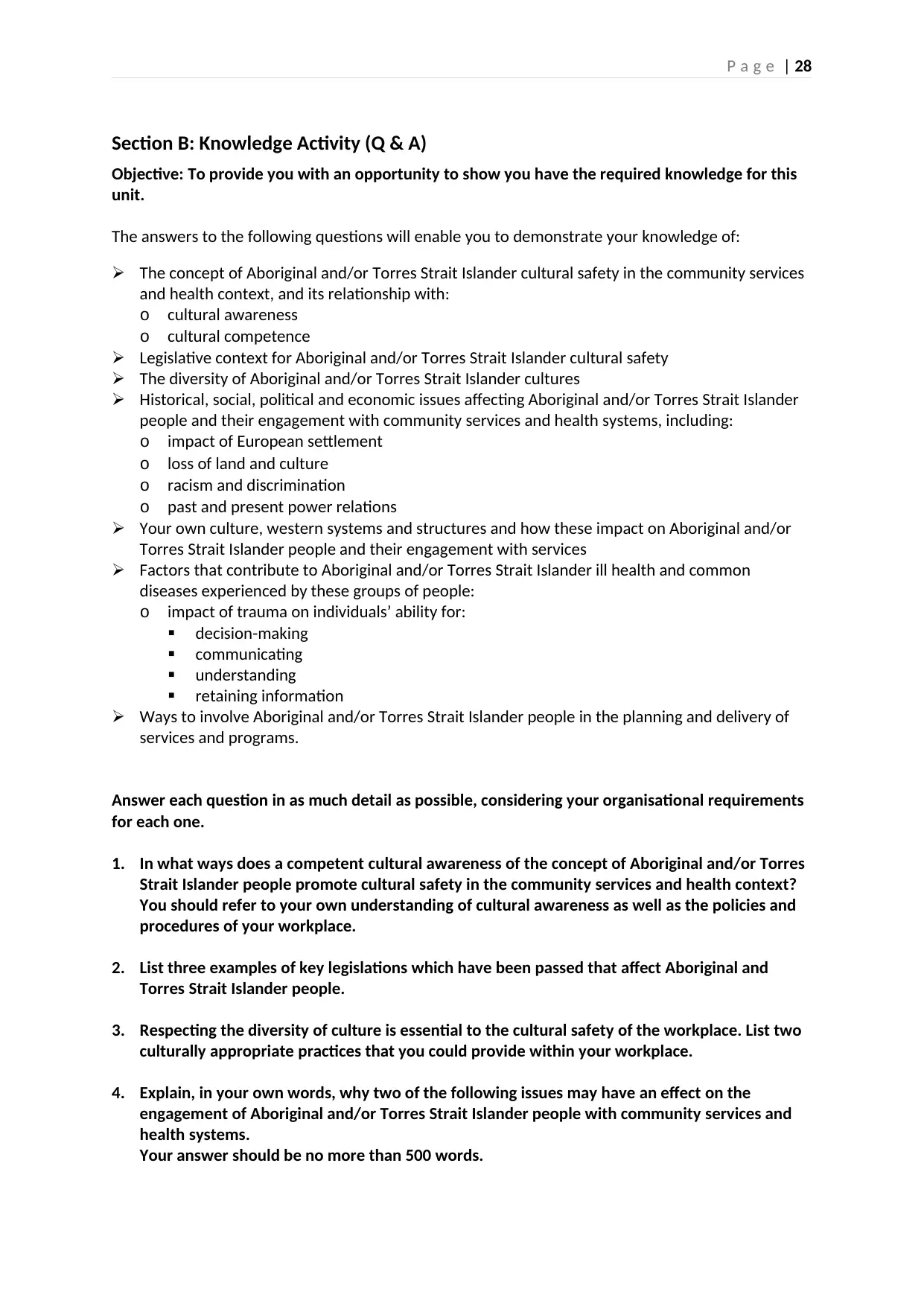
P a g e | 28
Section B: Knowledge Activity (Q & A)
Objective: To provide you with an opportunity to show you have the required knowledge for this
unit.
The answers to the following questions will enable you to demonstrate your knowledge of:
The concept of Aboriginal and/or Torres Strait Islander cultural safety in the community services
and health context, and its relationship with:
o cultural awareness
o cultural competence
Legislative context for Aboriginal and/or Torres Strait Islander cultural safety
The diversity of Aboriginal and/or Torres Strait Islander cultures
Historical, social, political and economic issues affecting Aboriginal and/or Torres Strait Islander
people and their engagement with community services and health systems, including:
o impact of European settlement
o loss of land and culture
o racism and discrimination
o past and present power relations
Your own culture, western systems and structures and how these impact on Aboriginal and/or
Torres Strait Islander people and their engagement with services
Factors that contribute to Aboriginal and/or Torres Strait Islander ill health and common
diseases experienced by these groups of people:
o impact of trauma on individuals’ ability for:
decision-making
communicating
understanding
retaining information
Ways to involve Aboriginal and/or Torres Strait Islander people in the planning and delivery of
services and programs.
Answer each question in as much detail as possible, considering your organisational requirements
for each one.
1. In what ways does a competent cultural awareness of the concept of Aboriginal and/or Torres
Strait Islander people promote cultural safety in the community services and health context?
You should refer to your own understanding of cultural awareness as well as the policies and
procedures of your workplace.
2. List three examples of key legislations which have been passed that affect Aboriginal and
Torres Strait Islander people.
3. Respecting the diversity of culture is essential to the cultural safety of the workplace. List two
culturally appropriate practices that you could provide within your workplace.
4. Explain, in your own words, why two of the following issues may have an effect on the
engagement of Aboriginal and/or Torres Strait Islander people with community services and
health systems.
Your answer should be no more than 500 words.
Section B: Knowledge Activity (Q & A)
Objective: To provide you with an opportunity to show you have the required knowledge for this
unit.
The answers to the following questions will enable you to demonstrate your knowledge of:
The concept of Aboriginal and/or Torres Strait Islander cultural safety in the community services
and health context, and its relationship with:
o cultural awareness
o cultural competence
Legislative context for Aboriginal and/or Torres Strait Islander cultural safety
The diversity of Aboriginal and/or Torres Strait Islander cultures
Historical, social, political and economic issues affecting Aboriginal and/or Torres Strait Islander
people and their engagement with community services and health systems, including:
o impact of European settlement
o loss of land and culture
o racism and discrimination
o past and present power relations
Your own culture, western systems and structures and how these impact on Aboriginal and/or
Torres Strait Islander people and their engagement with services
Factors that contribute to Aboriginal and/or Torres Strait Islander ill health and common
diseases experienced by these groups of people:
o impact of trauma on individuals’ ability for:
decision-making
communicating
understanding
retaining information
Ways to involve Aboriginal and/or Torres Strait Islander people in the planning and delivery of
services and programs.
Answer each question in as much detail as possible, considering your organisational requirements
for each one.
1. In what ways does a competent cultural awareness of the concept of Aboriginal and/or Torres
Strait Islander people promote cultural safety in the community services and health context?
You should refer to your own understanding of cultural awareness as well as the policies and
procedures of your workplace.
2. List three examples of key legislations which have been passed that affect Aboriginal and
Torres Strait Islander people.
3. Respecting the diversity of culture is essential to the cultural safety of the workplace. List two
culturally appropriate practices that you could provide within your workplace.
4. Explain, in your own words, why two of the following issues may have an effect on the
engagement of Aboriginal and/or Torres Strait Islander people with community services and
health systems.
Your answer should be no more than 500 words.
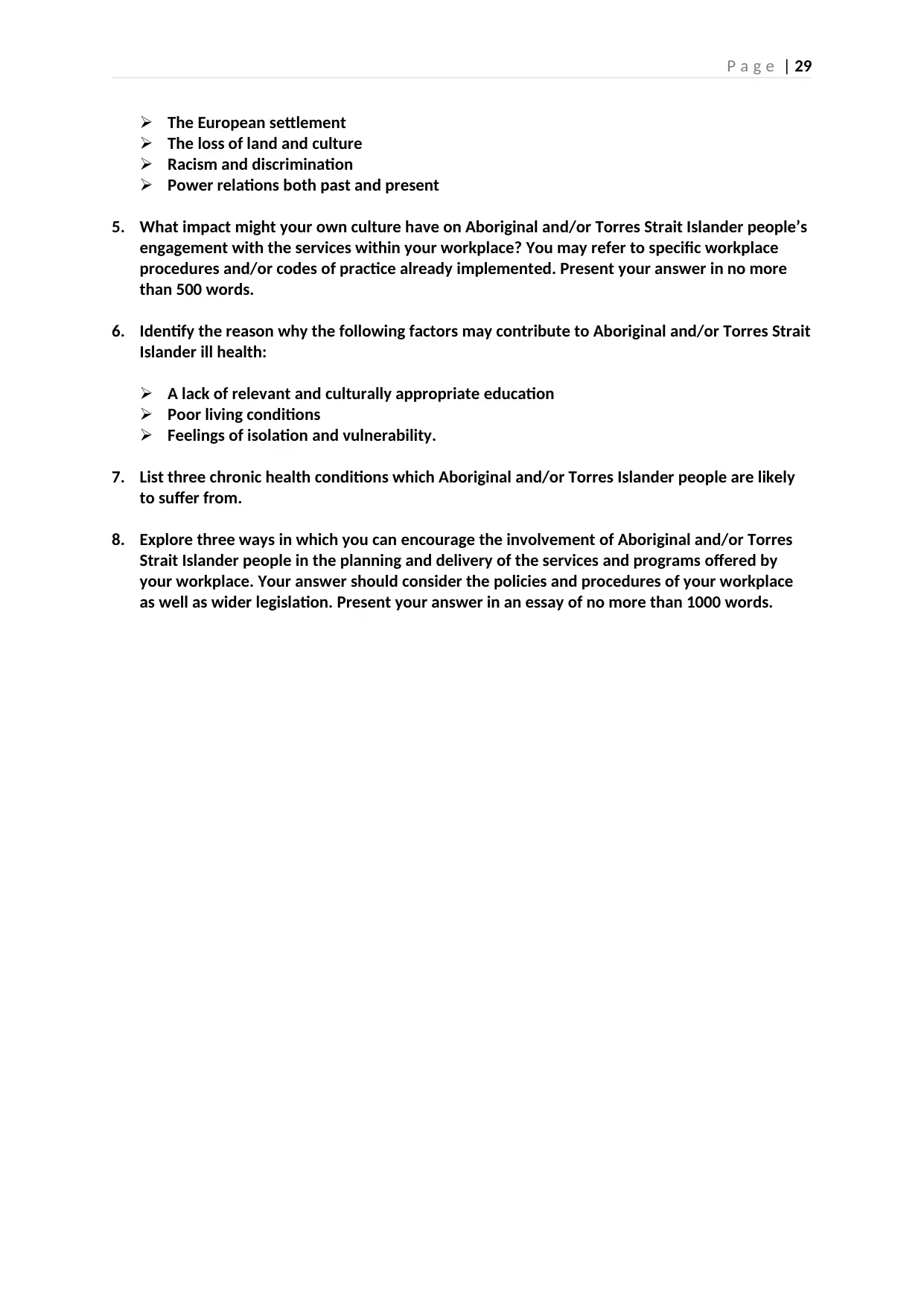
P a g e | 29
The European settlement
The loss of land and culture
Racism and discrimination
Power relations both past and present
5. What impact might your own culture have on Aboriginal and/or Torres Strait Islander people’s
engagement with the services within your workplace? You may refer to specific workplace
procedures and/or codes of practice already implemented. Present your answer in no more
than 500 words.
6. Identify the reason why the following factors may contribute to Aboriginal and/or Torres Strait
Islander ill health:
A lack of relevant and culturally appropriate education
Poor living conditions
Feelings of isolation and vulnerability.
7. List three chronic health conditions which Aboriginal and/or Torres Islander people are likely
to suffer from.
8. Explore three ways in which you can encourage the involvement of Aboriginal and/or Torres
Strait Islander people in the planning and delivery of the services and programs offered by
your workplace. Your answer should consider the policies and procedures of your workplace
as well as wider legislation. Present your answer in an essay of no more than 1000 words.
The European settlement
The loss of land and culture
Racism and discrimination
Power relations both past and present
5. What impact might your own culture have on Aboriginal and/or Torres Strait Islander people’s
engagement with the services within your workplace? You may refer to specific workplace
procedures and/or codes of practice already implemented. Present your answer in no more
than 500 words.
6. Identify the reason why the following factors may contribute to Aboriginal and/or Torres Strait
Islander ill health:
A lack of relevant and culturally appropriate education
Poor living conditions
Feelings of isolation and vulnerability.
7. List three chronic health conditions which Aboriginal and/or Torres Islander people are likely
to suffer from.
8. Explore three ways in which you can encourage the involvement of Aboriginal and/or Torres
Strait Islander people in the planning and delivery of the services and programs offered by
your workplace. Your answer should consider the policies and procedures of your workplace
as well as wider legislation. Present your answer in an essay of no more than 1000 words.
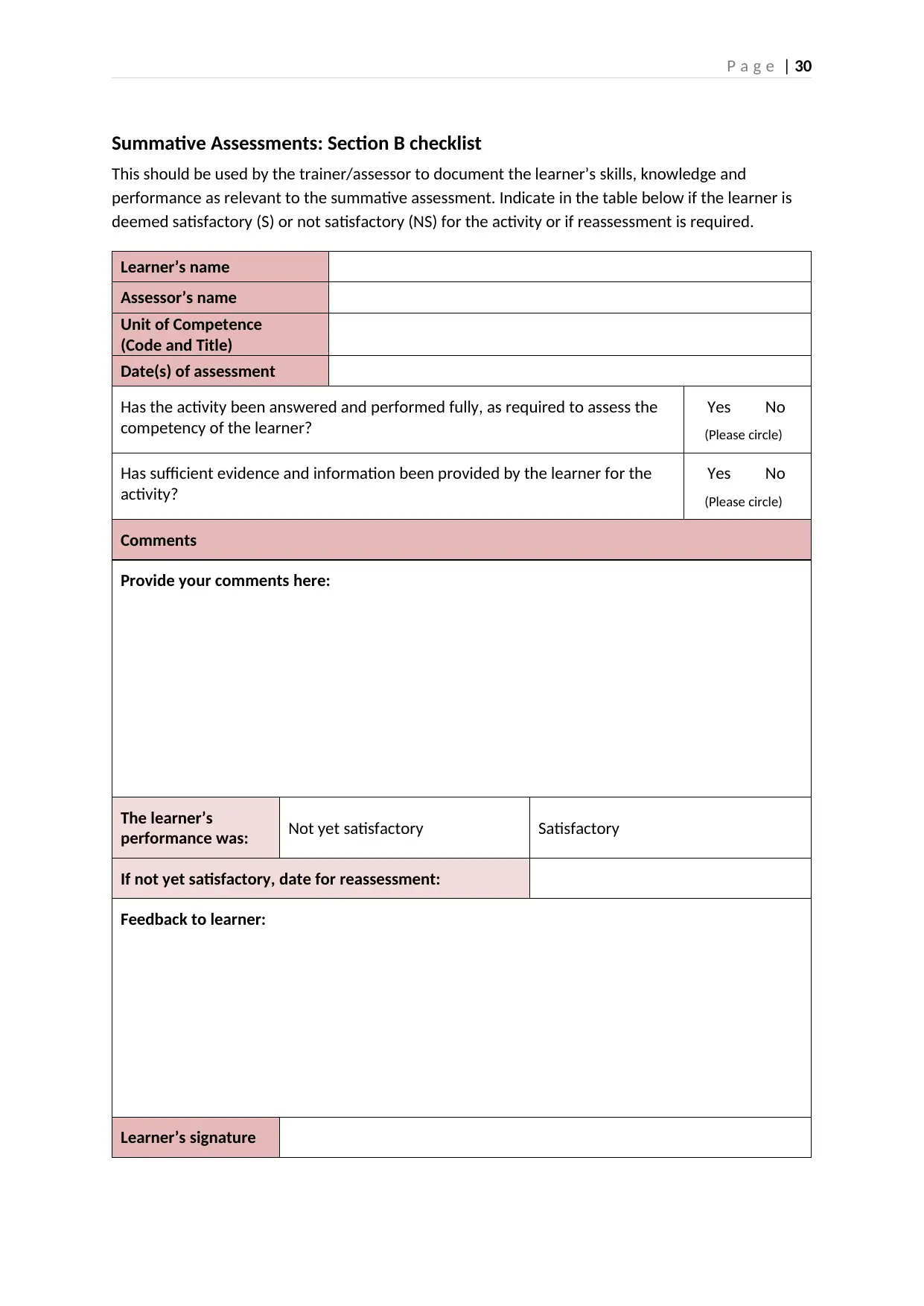
P a g e | 30
Summative Assessments: Section B checklist
This should be used by the trainer/assessor to document the learner’s skills, knowledge and
performance as relevant to the summative assessment. Indicate in the table below if the learner is
deemed satisfactory (S) or not satisfactory (NS) for the activity or if reassessment is required.
Learner’s name
Assessor’s name
Unit of Competence
(Code and Title)
Date(s) of assessment
Has the activity been answered and performed fully, as required to assess the
competency of the learner?
Yes No
(Please circle)
Has sufficient evidence and information been provided by the learner for the
activity?
Yes No
(Please circle)
Comments
Provide your comments here:
The learner’s
performance was: Not yet satisfactory Satisfactory
If not yet satisfactory, date for reassessment:
Feedback to learner:
Learner’s signature
Summative Assessments: Section B checklist
This should be used by the trainer/assessor to document the learner’s skills, knowledge and
performance as relevant to the summative assessment. Indicate in the table below if the learner is
deemed satisfactory (S) or not satisfactory (NS) for the activity or if reassessment is required.
Learner’s name
Assessor’s name
Unit of Competence
(Code and Title)
Date(s) of assessment
Has the activity been answered and performed fully, as required to assess the
competency of the learner?
Yes No
(Please circle)
Has sufficient evidence and information been provided by the learner for the
activity?
Yes No
(Please circle)
Comments
Provide your comments here:
The learner’s
performance was: Not yet satisfactory Satisfactory
If not yet satisfactory, date for reassessment:
Feedback to learner:
Learner’s signature
Paraphrase This Document
Need a fresh take? Get an instant paraphrase of this document with our AI Paraphraser
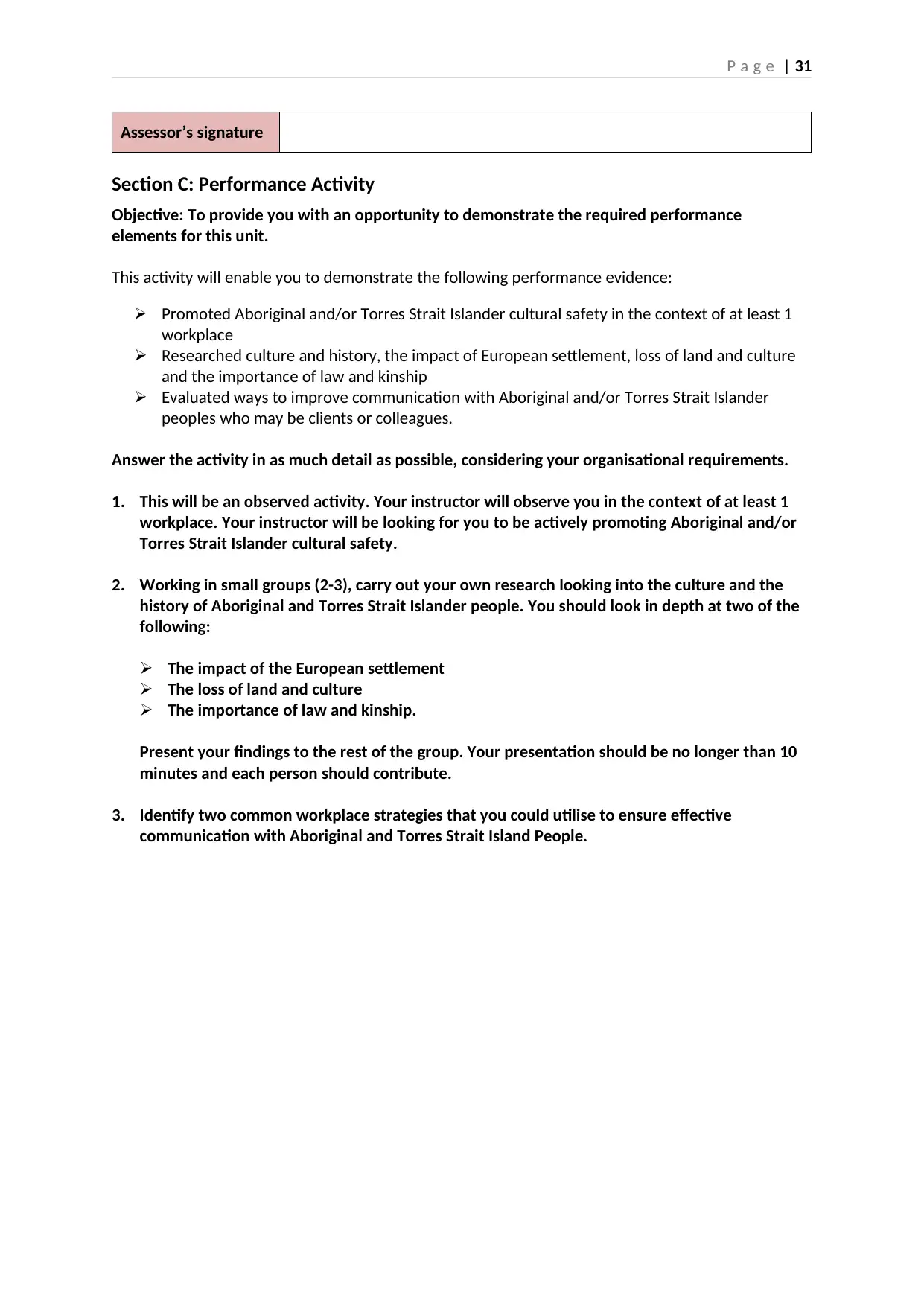
P a g e | 31
Assessor’s signature
Section C: Performance Activity
Objective: To provide you with an opportunity to demonstrate the required performance
elements for this unit.
This activity will enable you to demonstrate the following performance evidence:
Promoted Aboriginal and/or Torres Strait Islander cultural safety in the context of at least 1
workplace
Researched culture and history, the impact of European settlement, loss of land and culture
and the importance of law and kinship
Evaluated ways to improve communication with Aboriginal and/or Torres Strait Islander
peoples who may be clients or colleagues.
Answer the activity in as much detail as possible, considering your organisational requirements.
1. This will be an observed activity. Your instructor will observe you in the context of at least 1
workplace. Your instructor will be looking for you to be actively promoting Aboriginal and/or
Torres Strait Islander cultural safety.
2. Working in small groups (2-3), carry out your own research looking into the culture and the
history of Aboriginal and Torres Strait Islander people. You should look in depth at two of the
following:
The impact of the European settlement
The loss of land and culture
The importance of law and kinship.
Present your findings to the rest of the group. Your presentation should be no longer than 10
minutes and each person should contribute.
3. Identify two common workplace strategies that you could utilise to ensure effective
communication with Aboriginal and Torres Strait Island People.
Assessor’s signature
Section C: Performance Activity
Objective: To provide you with an opportunity to demonstrate the required performance
elements for this unit.
This activity will enable you to demonstrate the following performance evidence:
Promoted Aboriginal and/or Torres Strait Islander cultural safety in the context of at least 1
workplace
Researched culture and history, the impact of European settlement, loss of land and culture
and the importance of law and kinship
Evaluated ways to improve communication with Aboriginal and/or Torres Strait Islander
peoples who may be clients or colleagues.
Answer the activity in as much detail as possible, considering your organisational requirements.
1. This will be an observed activity. Your instructor will observe you in the context of at least 1
workplace. Your instructor will be looking for you to be actively promoting Aboriginal and/or
Torres Strait Islander cultural safety.
2. Working in small groups (2-3), carry out your own research looking into the culture and the
history of Aboriginal and Torres Strait Islander people. You should look in depth at two of the
following:
The impact of the European settlement
The loss of land and culture
The importance of law and kinship.
Present your findings to the rest of the group. Your presentation should be no longer than 10
minutes and each person should contribute.
3. Identify two common workplace strategies that you could utilise to ensure effective
communication with Aboriginal and Torres Strait Island People.

Summative Assessments: Section C checklist
This should be used by the trainer/assessor to document the learner’s skills, knowledge and
performance as relevant to the summative assessment. Indicate in the table below if the learner is
deemed satisfactory (S) or not satisfactory (NS) for the activity or if reassessment is required.
Learner’s name
Assessor’s name
Unit of Competence
(Code and Title)
Date(s) of assessment
Has the activity been answered and performed fully, as required to assess the
competency of the learner?
Yes No
(Please circle)
Has sufficient evidence and information been provided by the learner for the
activity?
Yes No
(Please circle)
Comments
Provide your comments here:
The learner’s
performance was: Not yet satisfactory Satisfactory
If not yet satisfactory, date for reassessment:
Feedback to learner:
Learner’s signature
This should be used by the trainer/assessor to document the learner’s skills, knowledge and
performance as relevant to the summative assessment. Indicate in the table below if the learner is
deemed satisfactory (S) or not satisfactory (NS) for the activity or if reassessment is required.
Learner’s name
Assessor’s name
Unit of Competence
(Code and Title)
Date(s) of assessment
Has the activity been answered and performed fully, as required to assess the
competency of the learner?
Yes No
(Please circle)
Has sufficient evidence and information been provided by the learner for the
activity?
Yes No
(Please circle)
Comments
Provide your comments here:
The learner’s
performance was: Not yet satisfactory Satisfactory
If not yet satisfactory, date for reassessment:
Feedback to learner:
Learner’s signature
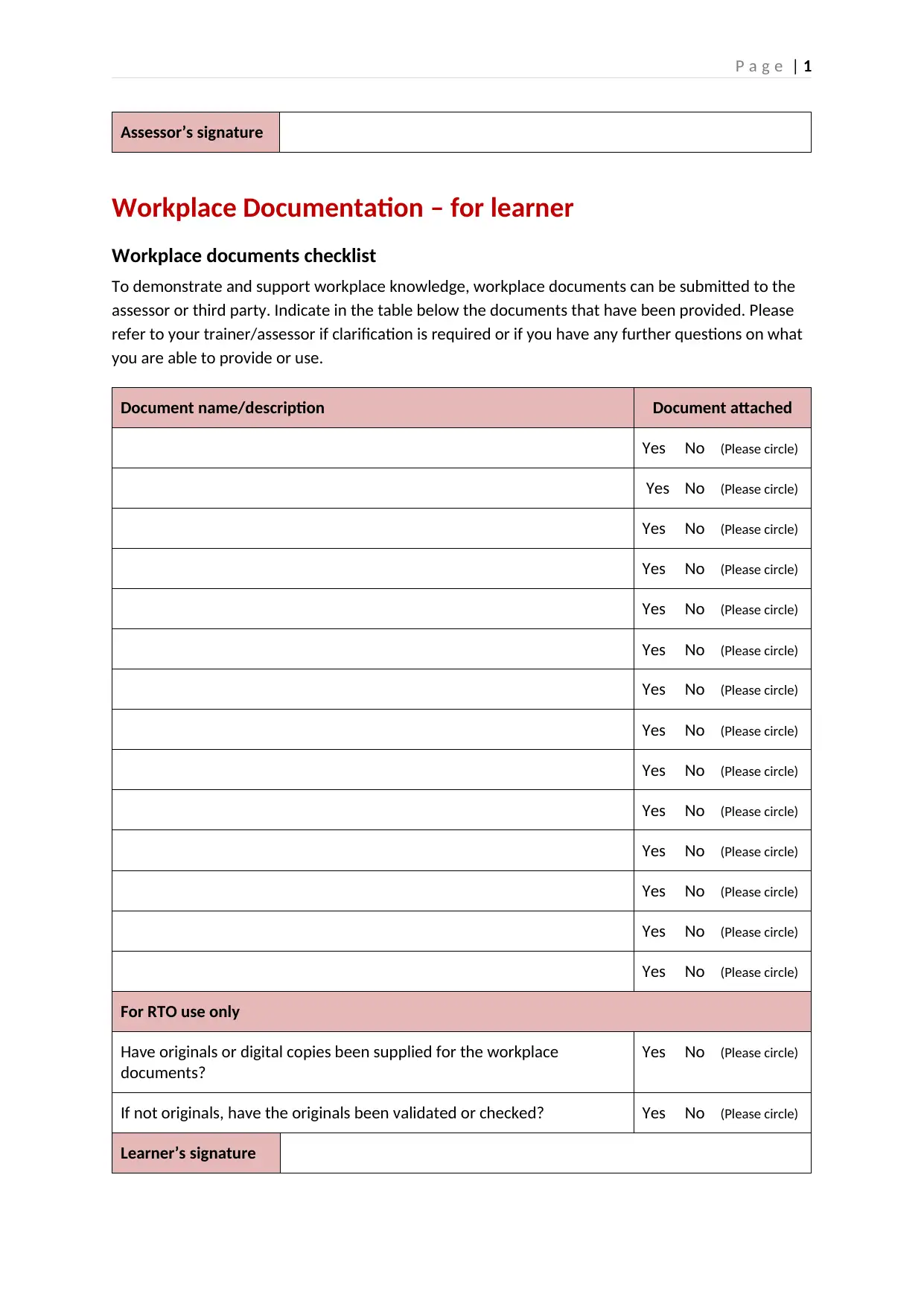
P a g e | 1
Assessor’s signature
Workplace Documentation – for learner
Workplace documents checklist
To demonstrate and support workplace knowledge, workplace documents can be submitted to the
assessor or third party. Indicate in the table below the documents that have been provided. Please
refer to your trainer/assessor if clarification is required or if you have any further questions on what
you are able to provide or use.
Document name/description Document attached
Yes No (Please circle)
Yes No (Please circle)
Yes No (Please circle)
Yes No (Please circle)
Yes No (Please circle)
Yes No (Please circle)
Yes No (Please circle)
Yes No (Please circle)
Yes No (Please circle)
Yes No (Please circle)
Yes No (Please circle)
Yes No (Please circle)
Yes No (Please circle)
Yes No (Please circle)
For RTO use only
Have originals or digital copies been supplied for the workplace
documents?
Yes No (Please circle)
If not originals, have the originals been validated or checked? Yes No (Please circle)
Learner’s signature
Assessor’s signature
Workplace Documentation – for learner
Workplace documents checklist
To demonstrate and support workplace knowledge, workplace documents can be submitted to the
assessor or third party. Indicate in the table below the documents that have been provided. Please
refer to your trainer/assessor if clarification is required or if you have any further questions on what
you are able to provide or use.
Document name/description Document attached
Yes No (Please circle)
Yes No (Please circle)
Yes No (Please circle)
Yes No (Please circle)
Yes No (Please circle)
Yes No (Please circle)
Yes No (Please circle)
Yes No (Please circle)
Yes No (Please circle)
Yes No (Please circle)
Yes No (Please circle)
Yes No (Please circle)
Yes No (Please circle)
Yes No (Please circle)
For RTO use only
Have originals or digital copies been supplied for the workplace
documents?
Yes No (Please circle)
If not originals, have the originals been validated or checked? Yes No (Please circle)
Learner’s signature
Secure Best Marks with AI Grader
Need help grading? Try our AI Grader for instant feedback on your assignments.

P a g e | 2
Assessor’s signature
Supplementary Oral Questions (optional) – for assessor
The below table is for you to document any supplementary verbal questions you have asked the
learner to determine their competency. For example, if you are unsure of their answer to a question
in the Learner Workbook, you may choose to ask them a supplementary question to clarify their
understanding of the relevant criteria.
Learner’s name
Assessor’s name
Unit of Competence
(Code and Title)
Date of assessment
Question:
Learner answer:
Assessor judgement: Satisfactory Not Satisfactory
Question:
Learner answer:
Assessor’s signature
Supplementary Oral Questions (optional) – for assessor
The below table is for you to document any supplementary verbal questions you have asked the
learner to determine their competency. For example, if you are unsure of their answer to a question
in the Learner Workbook, you may choose to ask them a supplementary question to clarify their
understanding of the relevant criteria.
Learner’s name
Assessor’s name
Unit of Competence
(Code and Title)
Date of assessment
Question:
Learner answer:
Assessor judgement: Satisfactory Not Satisfactory
Question:
Learner answer:

P a g e | 3
Assessor judgement: Satisfactory Not Satisfactory
Assessor judgement: Satisfactory Not Satisfactory
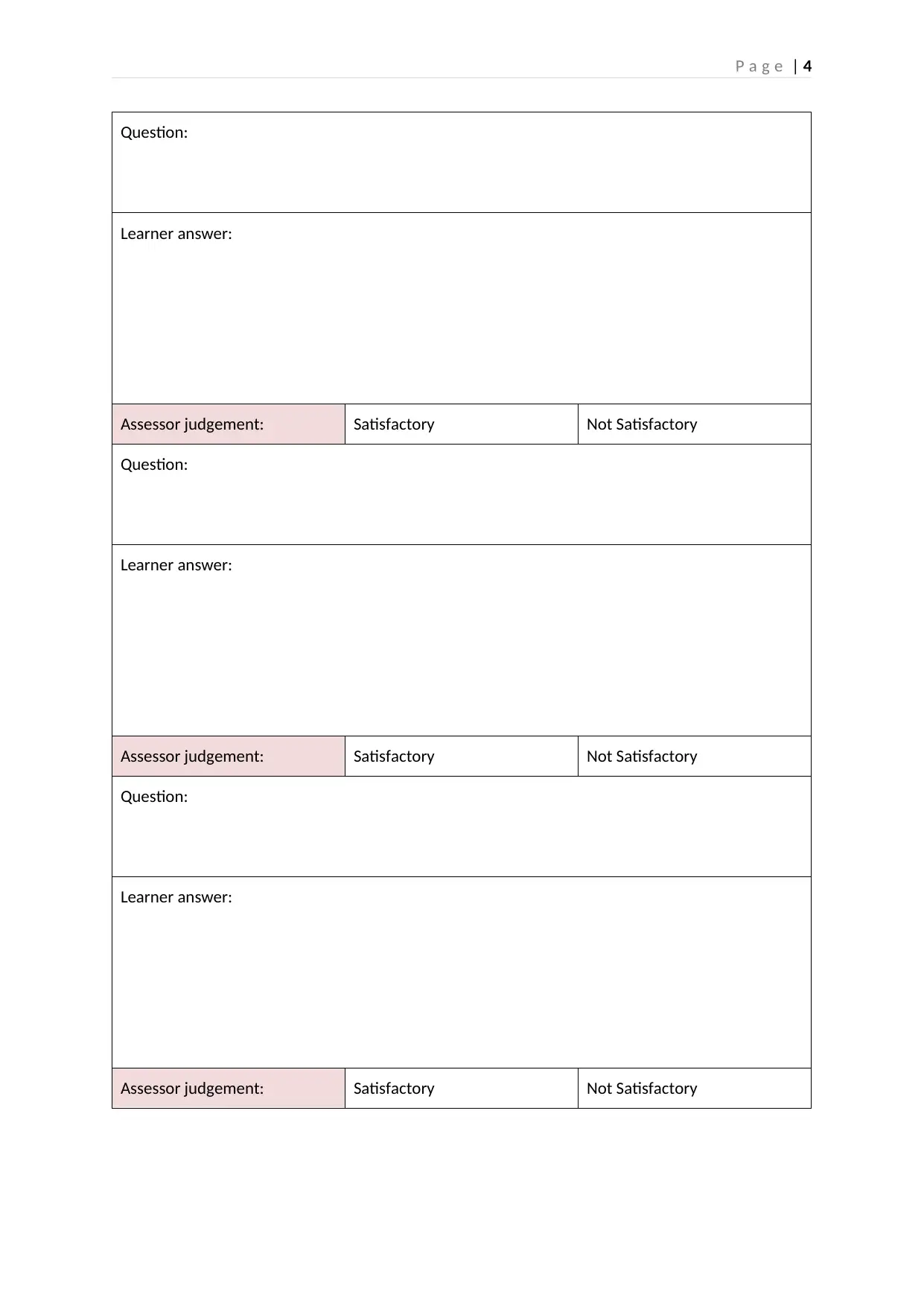
P a g e | 4
Question:
Learner answer:
Assessor judgement: Satisfactory Not Satisfactory
Question:
Learner answer:
Assessor judgement: Satisfactory Not Satisfactory
Question:
Learner answer:
Assessor judgement: Satisfactory Not Satisfactory
Question:
Learner answer:
Assessor judgement: Satisfactory Not Satisfactory
Question:
Learner answer:
Assessor judgement: Satisfactory Not Satisfactory
Question:
Learner answer:
Assessor judgement: Satisfactory Not Satisfactory
Paraphrase This Document
Need a fresh take? Get an instant paraphrase of this document with our AI Paraphraser
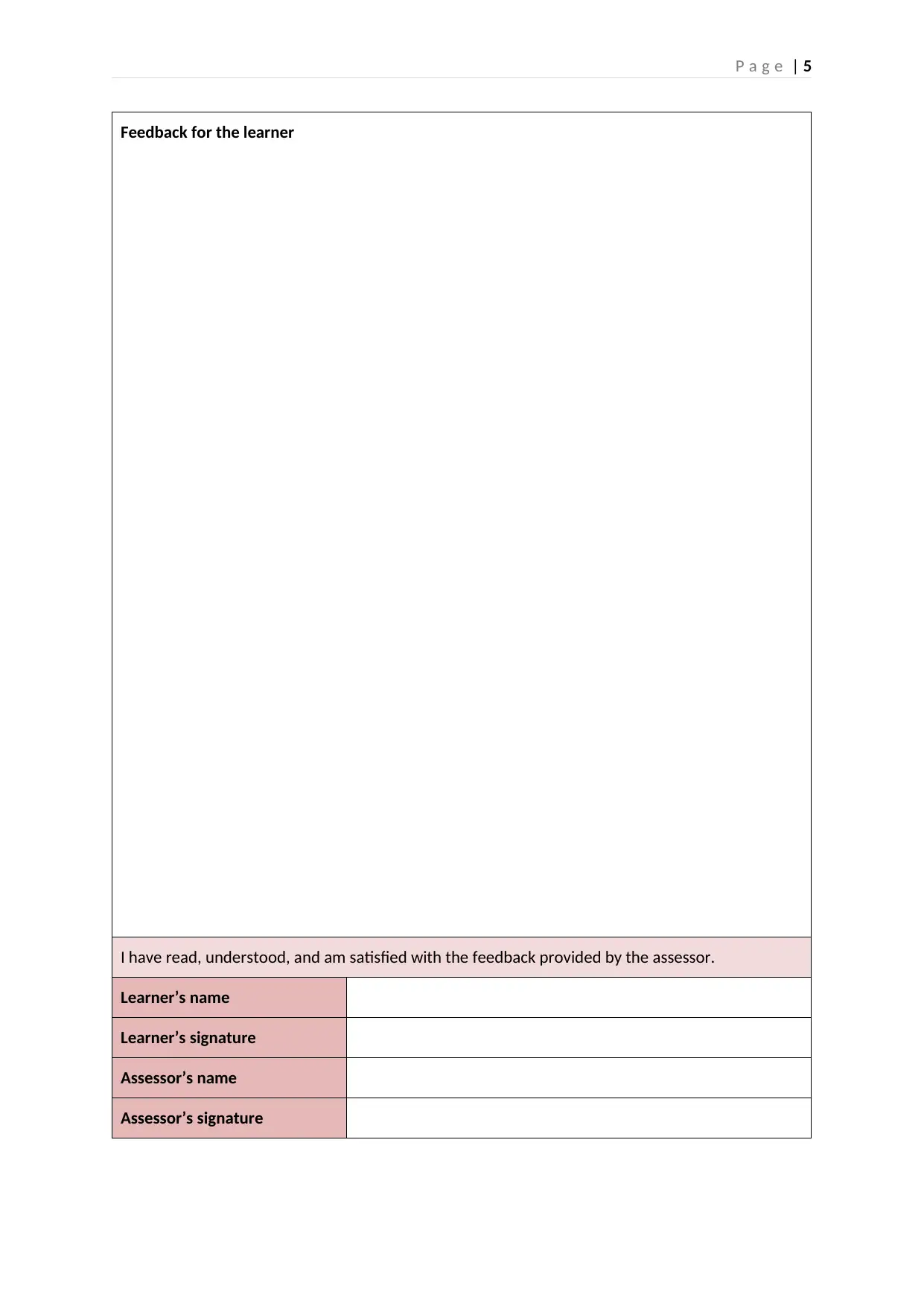
P a g e | 5
Feedback for the learner
I have read, understood, and am satisfied with the feedback provided by the assessor.
Learner’s name
Learner’s signature
Assessor’s name
Assessor’s signature
Feedback for the learner
I have read, understood, and am satisfied with the feedback provided by the assessor.
Learner’s name
Learner’s signature
Assessor’s name
Assessor’s signature
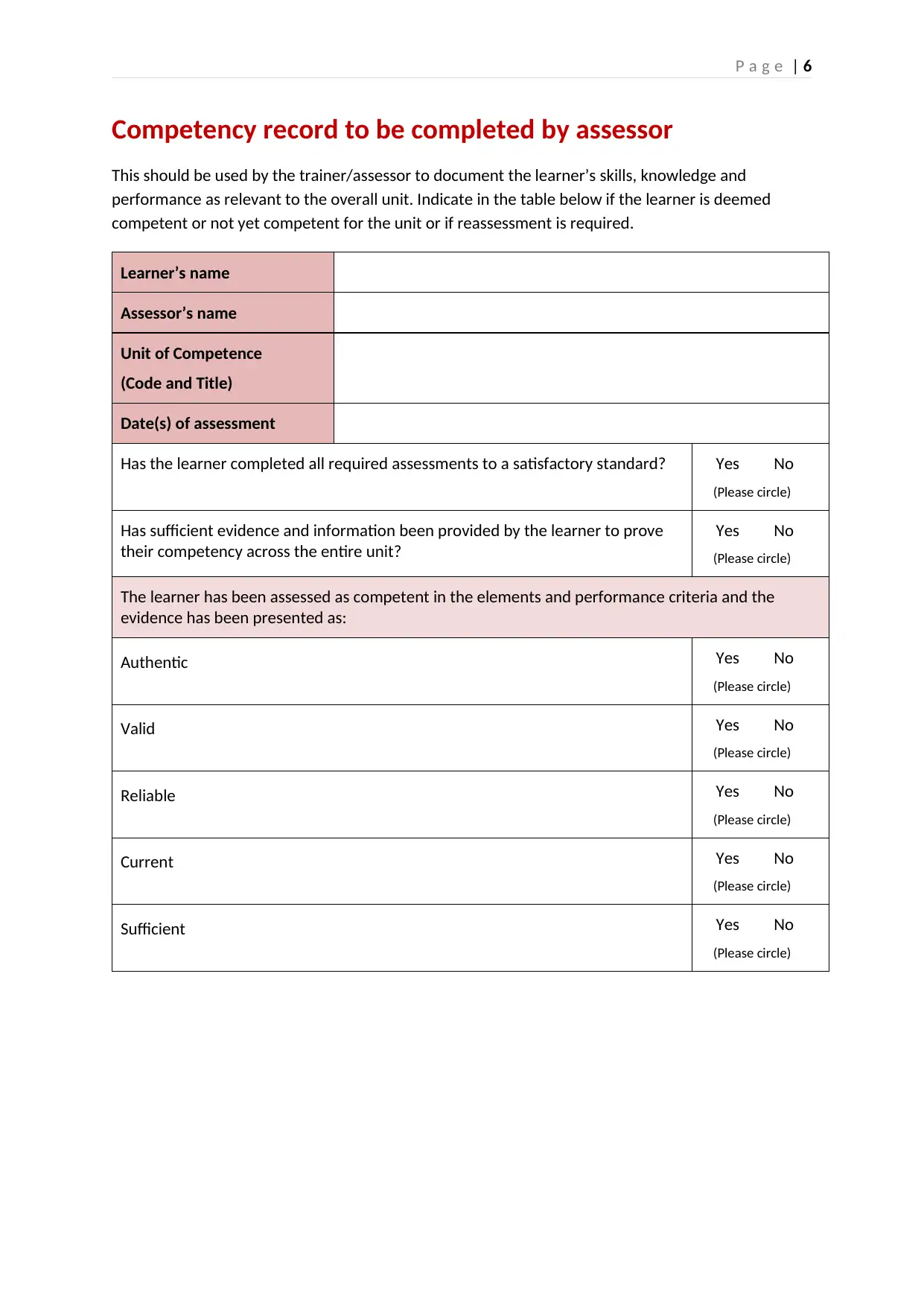
P a g e | 6
Competency record to be completed by assessor
This should be used by the trainer/assessor to document the learner’s skills, knowledge and
performance as relevant to the overall unit. Indicate in the table below if the learner is deemed
competent or not yet competent for the unit or if reassessment is required.
Learner’s name
Assessor’s name
Unit of Competence
(Code and Title)
Date(s) of assessment
Has the learner completed all required assessments to a satisfactory standard? Yes No
(Please circle)
Has sufficient evidence and information been provided by the learner to prove
their competency across the entire unit?
Yes No
(Please circle)
The learner has been assessed as competent in the elements and performance criteria and the
evidence has been presented as:
Authentic Yes No
(Please circle)
Valid Yes No
(Please circle)
Reliable Yes No
(Please circle)
Current Yes No
(Please circle)
Sufficient Yes No
(Please circle)
Competency record to be completed by assessor
This should be used by the trainer/assessor to document the learner’s skills, knowledge and
performance as relevant to the overall unit. Indicate in the table below if the learner is deemed
competent or not yet competent for the unit or if reassessment is required.
Learner’s name
Assessor’s name
Unit of Competence
(Code and Title)
Date(s) of assessment
Has the learner completed all required assessments to a satisfactory standard? Yes No
(Please circle)
Has sufficient evidence and information been provided by the learner to prove
their competency across the entire unit?
Yes No
(Please circle)
The learner has been assessed as competent in the elements and performance criteria and the
evidence has been presented as:
Authentic Yes No
(Please circle)
Valid Yes No
(Please circle)
Reliable Yes No
(Please circle)
Current Yes No
(Please circle)
Sufficient Yes No
(Please circle)
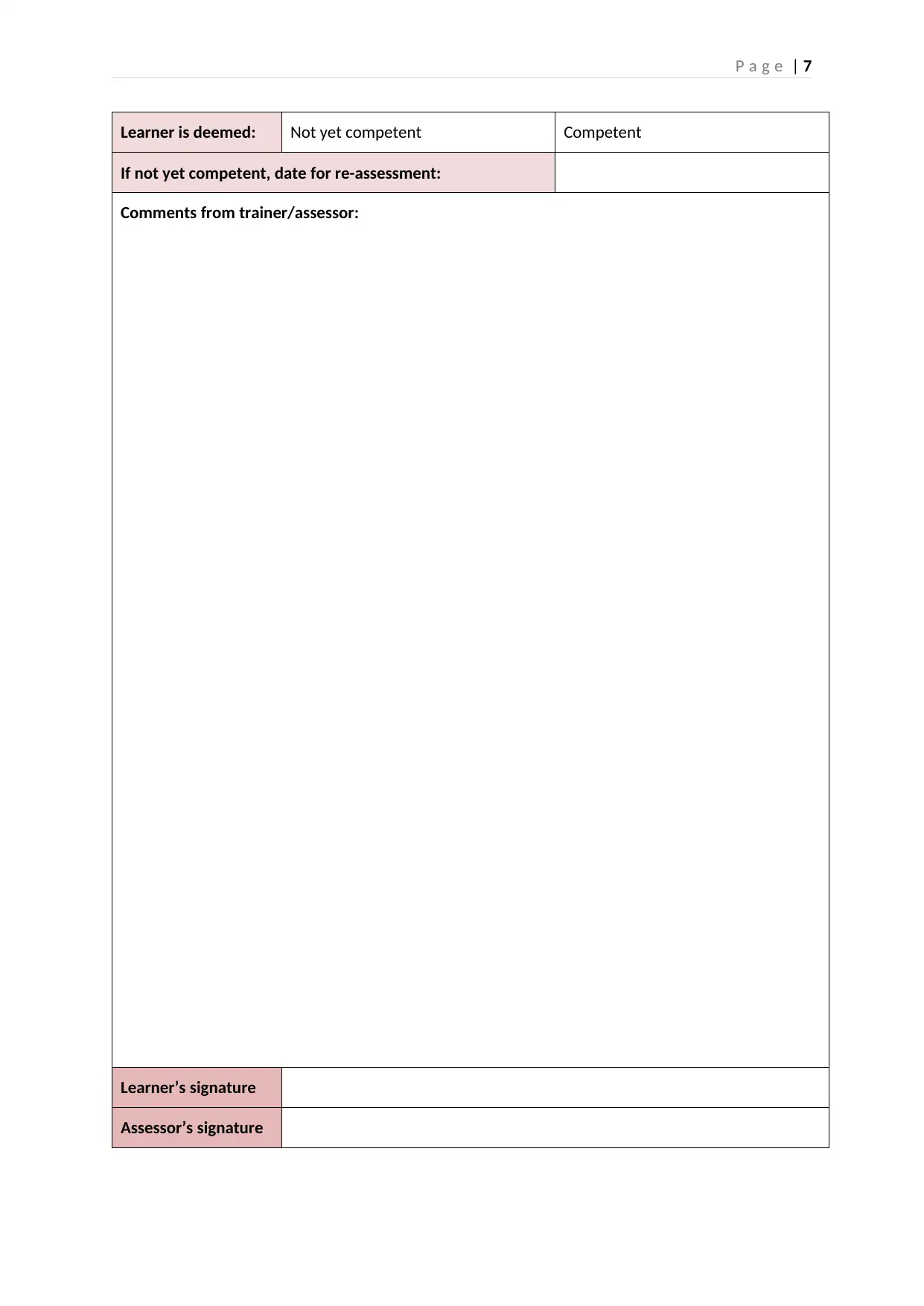
P a g e | 7
Learner is deemed: Not yet competent Competent
If not yet competent, date for re-assessment:
Comments from trainer/assessor:
Learner’s signature
Assessor’s signature
Learner is deemed: Not yet competent Competent
If not yet competent, date for re-assessment:
Comments from trainer/assessor:
Learner’s signature
Assessor’s signature
Secure Best Marks with AI Grader
Need help grading? Try our AI Grader for instant feedback on your assignments.

P a g e | 8

P a g e | 9
References
Eoc.sa.gov.au. 2018. Australian Human Rights Commission Act 1986. [online] Available at:
http://www.eoc.sa.gov.au/eo-you/discrimination-laws/australian-laws/human-rights-and-equal-
opportunity-commission-act [Accessed 20 Feb. 2018].
Fredericks, B., 2013. 'We don't leave our identities at the city limits': Aboriginal and Torres Strait
Islander people living in urban localities. Australian Aboriginal Studies, (1), p.4.
Gelis, U., 2015. ’The Caretaker and the Plague: British Nuclear Weapons Testing in
Australia’. Nuclear Age Peace Foundation, 27.
Green, S., 2016. The European Identity: Historical and Cultural Realities We Cannot Deny. Haus
Publishing.
legislation.gov.au. 2018. Racial Discrimination Act 1975. [online] Available at:
https://www.legislation.gov.au/Details/C2014C00014 [Accessed 20 Feb. 2018].
Loos, N. and Mabo, E.K., 2013. Eddie Koiki Mabo: His Life and Struggle for Land Rights. Univ. of
Queensland Press.
Lowe, K. and Yunkaporta, T., 2013. The inclusion of Aboriginal and Torres Strait Islander content in
the Australian National Curriculum: A cultural, cognitive and socio-political evaluation. Curriculum
Perspectives, 33(1), pp.1-14.
Parker, R. and Milroy, H., 2014. Aboriginal and Torres Strait Islander mental health: an
overview. Working together: Aboriginal and Torres Strait Islander mental health and wellbeing
principles and practice, 2, pp.25-38.
Zubrzycki, J., Green, S., Jones, V., Stratton, K., Young, S. and Bessarab, D., 2014. Getting it right:
Creating partnerships for change. Integrating Aboriginal and Torres Strait Islander knowledges in
social work education and practice.
References
Eoc.sa.gov.au. 2018. Australian Human Rights Commission Act 1986. [online] Available at:
http://www.eoc.sa.gov.au/eo-you/discrimination-laws/australian-laws/human-rights-and-equal-
opportunity-commission-act [Accessed 20 Feb. 2018].
Fredericks, B., 2013. 'We don't leave our identities at the city limits': Aboriginal and Torres Strait
Islander people living in urban localities. Australian Aboriginal Studies, (1), p.4.
Gelis, U., 2015. ’The Caretaker and the Plague: British Nuclear Weapons Testing in
Australia’. Nuclear Age Peace Foundation, 27.
Green, S., 2016. The European Identity: Historical and Cultural Realities We Cannot Deny. Haus
Publishing.
legislation.gov.au. 2018. Racial Discrimination Act 1975. [online] Available at:
https://www.legislation.gov.au/Details/C2014C00014 [Accessed 20 Feb. 2018].
Loos, N. and Mabo, E.K., 2013. Eddie Koiki Mabo: His Life and Struggle for Land Rights. Univ. of
Queensland Press.
Lowe, K. and Yunkaporta, T., 2013. The inclusion of Aboriginal and Torres Strait Islander content in
the Australian National Curriculum: A cultural, cognitive and socio-political evaluation. Curriculum
Perspectives, 33(1), pp.1-14.
Parker, R. and Milroy, H., 2014. Aboriginal and Torres Strait Islander mental health: an
overview. Working together: Aboriginal and Torres Strait Islander mental health and wellbeing
principles and practice, 2, pp.25-38.
Zubrzycki, J., Green, S., Jones, V., Stratton, K., Young, S. and Bessarab, D., 2014. Getting it right:
Creating partnerships for change. Integrating Aboriginal and Torres Strait Islander knowledges in
social work education and practice.

P a g e | 10
1 out of 55
Related Documents
Your All-in-One AI-Powered Toolkit for Academic Success.
+13062052269
info@desklib.com
Available 24*7 on WhatsApp / Email
![[object Object]](/_next/static/media/star-bottom.7253800d.svg)
Unlock your academic potential
© 2024 | Zucol Services PVT LTD | All rights reserved.





